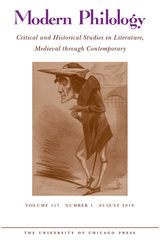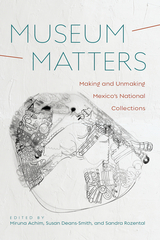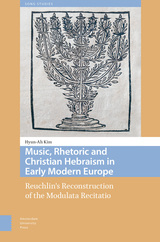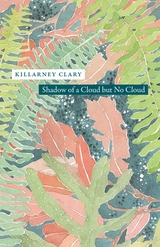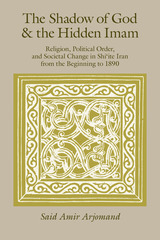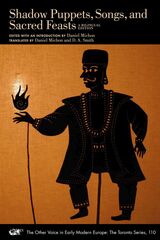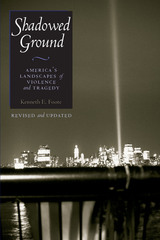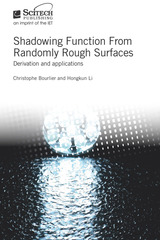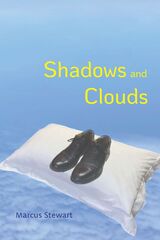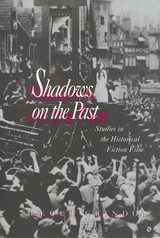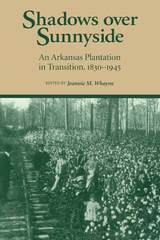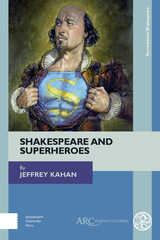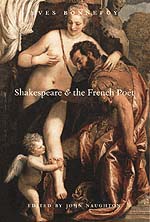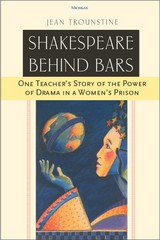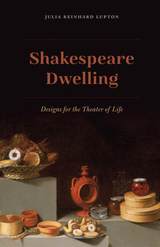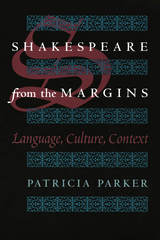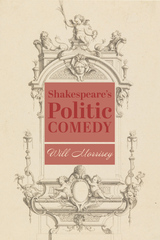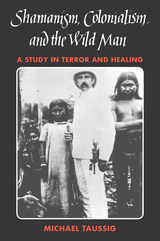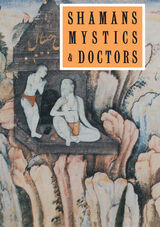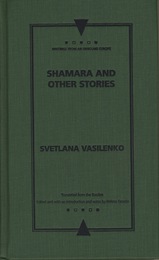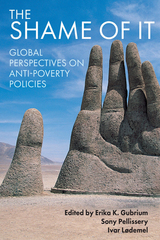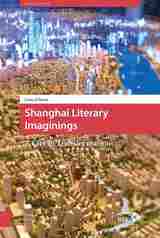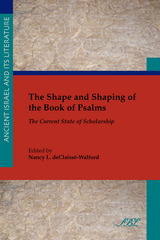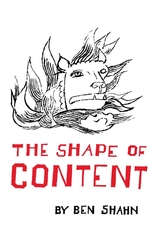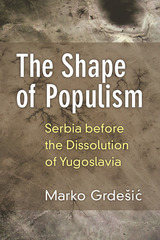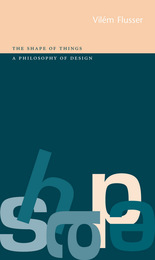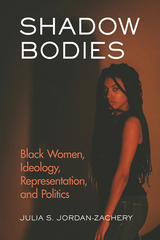 Shadow Bodies: Black Women, Ideology, Representation, and Politics
Jordan-Zachery, Julia S.
Rutgers University Press, 2018 What does it mean for Black women to organize in a political context that has generally ignored them or been unresponsive although Black women have shown themselves an important voting bloc? How for example, does #sayhername translate into a political agenda that manifests itself in specific policies? Shadow Bodies focuses on the positionality of the Black woman’s body, which serves as a springboard for helping us think through political and cultural representations. It does so by asking: How do discursive practices, both speech and silences, support and maintain hegemonic understandings of Black womanhood thereby rendering some Black women as shadow bodies, unseen and unremarked upon?
Grounded in Black feminist thought, Julia S. Jordan-Zachery looks at the functioning of scripts ascribed to Black women’s bodies in the framing of HIV/AIDS, domestic abuse, and mental illness and how such functioning renders some bodies invisible in Black politics in general and Black women’s politics specifically.
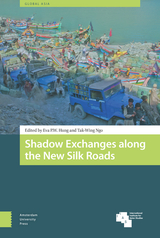 Shadow Exchanges along the New Silk Roads
Eva P. W. Hung
Amsterdam University Press, 2020 Long before China promulgated the official One Belt One Road initiatives, vast networks of cross-border exchanges already existed across Asia and Eurasia. The dynamics of such trade and resource flows have largely been outside state control, and are pushed to the realm of the shadow economy. The official initiative is a state-driven attempt to enhance the orderly flow of resources across countries along the Belt and Road, hence extending the reach of the states to the shadow economies. This volume offers a bottom-up view of the transborder informal exchanges across Asia and Eurasia, and analyses its clash and mesh with the state-orchestrated Belt and Road cooperation. By undertaking a comparative study of country cases along the new silk roads, the book underlines the intended and unintended consequences of such competing routes of connectivity on the socio-economic conditions of local communities.
 Shadow Girl: A Memoir Of Attachment
Deb Abramson
University of Iowa Press, 2002 As the good little girl in an unhappy family who hid her darker troubles, Deb Abramson felt like she was living with another girl, a shadowy being who would neither leave nor make herself known. Crushed beneath the burden of her parents‘ rigid expectations yet driven to satisfy their needs, Abramson becomes bulimic, then severely depressed and suicidal, retreating more and more from the troubling outside world to the seeming haven of home, to a cycle of comfort from and competition with her depressed mother, to the frightening but alluring intimacy of her father's affections. Her struggle to extricate herself from the “impermeable, immutable knot” of her family forms the heart of her dazzling book.
In this psychological portrait of a family bound together by the uneasy permutations of love, Abramson relies not on sensationalist narrative but on a collection of the many small moments that glitter along the bumpy path of her life. Now and then she provides a broader, connecting perspective by stepping out of her story to reflect on the meaning of it all from the standpoint of the insightful, healed person she has managed—against all odds—to become.
Rich in metaphor and intimate detail, this is a lyrical story about moving from isolation toward connection, about seeing childhood not as a crippling refuge but as a point of departure, about discovering that it is possible to “have your shadows as well as your light.”
 Shadow Lives: The Forgotten Women of the War on Terror
Victoria Brittain
Pluto Press, 2013 Shadow Lives reveals the unseen side of the '9/11 wars': their impact on the wives and families of men incarcerated in Guantanamo, or in prison or under house arrest in Britain and the US. Victoria Brittain shows how these families have been made socially invisible and a convenient scapegoat for the state in order to exercise arbitrary powers under the cover of the 'War on Terror'.
A disturbing exposé of the perilous state of freedom and democracy in our society, the book reveals how a culture of intolerance and cruelty has left individuals at the mercy of the security services’ unverifiable accusations and punitive punishments.
Both a j'accuse and a testament to the strength and humanity of the families, Shadow Lives shows the methods of incarceration and social control being used by the British state and gives a voice to the families whose lives have been turned upside down. In doing so it raises urgent questions about civil liberties which no one can afford to ignore.
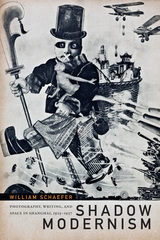 Shadow Modernism: Photography, Writing, and Space in Shanghai, 1925-1937
William Schaefer
Duke University Press, 2017 During the early twentieth century, Shanghai was the center of China's new media culture. Described by the modernist writer Mu Shiying as "transplanted from Europe" and “paved with shadows,” for many of its residents Shanghai was a city without a past paradoxically haunted by the absent past’s traces. In Shadow Modernism William Schaefer traces how photographic practices in Shanghai provided a forum within which to debate culture, ethnicity, history, and the very nature of images. The central modernist form in China, photography was neither understood nor practiced as primarily a medium for realist representation; rather, photo layouts, shadow photography, and photomontage rearranged and recomposed time and space, cutting apart and stitching places, people, and periods together in novel and surreal ways. Analyzing unknown and overlooked photographs, photomontages, cartoons, paintings, and experimental fiction and poetry, Schaefer shows how artists and writers used such fragmentation and juxtaposition to make visible the shadows of modernity in Shanghai: the violence, the past, the ethnic and cultural multiplicity excluded and repressed by the prevailing cultural politics of the era and yet hidden in plain sight.
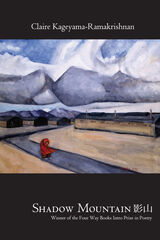 Shadow Mountain
Claire Kageyama-Ramakrishnan
Four Way Books, 2008 Shadow Mountain is the winner of the Four Way Books Intro Series in Poetry, selected by acclaimed poet Kimiko Hahn. The first years of the 21st century have been marked by a global uneasiness over untold stories: forgotten prisoners, unjustified wars, secret decisions. In Shadow Mountain Claire Kageyama-Ramakrishnan gives voice to older, too-easily forgotten tragedies, urging us to learn a present lesson. She draws on the stories of Japanese-Americans interned at Manzanar Relocation Center, California, and on her own childhood and memories of her grandparents, examining the fault-line between family life and communal experience. Shadow Mountain is captivating in its imagery, enchanting in its sounds, and a must read for anyone interested in the history of Japanese-American citizens and their children. Ranging in her forms from sonnet to terzanelle to fragmented, obstructed free verse, Kageyama-Ramakrishnan is a heartfelt interlocutor. “A socially-conscious writer whose issues of war and passion bring us back, then forward again… Shadow Mountain, a plaintive first book, will be read by those who love poetry—and by those who will begin that love, here.” —Kimiko Hahn
Shadow of a Cloud but No Cloud
Killarney Clary
University of Chicago Press, 2014 Shadow of a Cloud but No Cloud, the latest collection from enigmatic prose poet Killarney Clary, is a book-length sequence of unnumbered, untitled poems, each evoking a clear moment in time. The details on which Clary chooses to focus suggest a narrative that will not resolve. The unnamed people with whom she interacts offer exchanges she is desperate to prolong, and in attempts to understand her place, she reaches beneath the fragile armor of those loved, especially those who can no longer answer her. This quietly haunting book, remarkable for its subtlety and delicacy, is Clary’s strongest, most engaging work to date and amply shows her to be a master of this lyric genre.
 The Shadow of a Year: The 1641 Rebellion in Irish History and Memory
John Gibney
University of Wisconsin Press, 2013 In October 1641 a rebellion broke out in Ireland. Dispossessed Irish Catholics rose up against British Protestant settlers whom they held responsible for their plight. This uprising, the first significant sectarian rebellion in Irish history, gave rise to a decade of war that would culminate in the brutal re-conquest of Ireland by Oliver Cromwell. It also set in motion one of the most enduring and acrimonious debates in Irish history.
Was the 1641 rebellion a justified response to dispossession and repression? Or was it an unprovoked attempt at sectarian genocide? John Gibney comprehensively examines three centuries of this debate. The struggle to establish and interpret the facts of the past was also a struggle over the present: if Protestants had been slaughtered by vicious Catholics, this provided an ideal justification for maintaining Protestant privilege. If, on the other hand, Protestant propaganda had inflated a few deaths into a vast and brutal “massacre,” this justification was groundless.
Gibney shows how politicians, historians, and polemicists have represented (and misrepresented) 1641 over the centuries, making a sectarian understanding of Irish history the dominant paradigm in the consciousness of the Irish Protestant and Catholic communities alike.
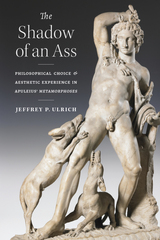 The Shadow of an Ass: Philosophical Choice and Aesthetic Experience in Apuleius' Metamorphoses
Jeffrey P. Ulrich
University of Michigan Press, 2024 Jeffrey Ulrich’s The Shadow of an Ass addresses fundamental questions about the reception and aesthetic experience of Apuleius’ Metamorphoses, popularly known as The Golden Ass, by situating the novel in a contemporaneous literary and philosophical discourse emerging in the Second Sophistic. This unique Latin novel follows a man who is accidentally turned into a donkey because of his curiosity, viewing the world through a donkey’s eyes until he is returned to human form by the Egyptian goddess Isis. In the end, he chooses to become a cult initiate and priest instead of a debased and overindulgent ass. On the one hand, the novel encourages readers to take pleasure in the narrator’s experiences, as he relishes food, sex, and forbidden forms of knowledge. Simultaneously, it challenges readers to reconsider their participation in the story by exposing its donkey-narrator as a failed model of heroism and philosophical investigation. Ulrich interprets the Metamorphoses as a locus of philosophical inquiry, positioning the act of reading as a choice of how much to invest in this tale of pleasurable transformation and unanticipated conversion. The Shadow of an Ass further explores how Apuleius, as a North African philosopher translating an originally Greek novel into a Latin idiolect, transforms himself into an intermediary of Platonic philosophy for his Carthaginian audience.
Situating the novel in a long history of philosophical and literary conversations, Ulrich suggests that the Metamorphoses anticipates much of the philosophical burlesque we tend to associate with early modern fiction, from Don Quixote to Lewis Carroll.
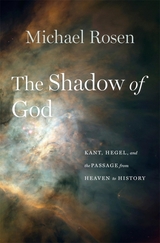 The Shadow of God: Kant, Hegel, and the Passage from Heaven to History
Michael Rosen
Harvard University Press, 2022 A bold and beautifully written exploration of the “afterlife” of God, showing how apparently secular habits of mind in fact retain the structure of religious thought.
Once in the West, our lives were bounded by religion. Then we were guided out of the darkness of faith, we are often told, by the cold light of science and reason. To be modern was to reject the religious for the secular and rational. In a bold retelling of philosophical history, Michael Rosen explains the limits of this story, showing that many modern and apparently secular ways of seeing the world were in fact profoundly shaped by religion.
The key thinkers, Rosen argues, were the German Idealists, as they sought to reconcile reason and religion. It was central to Kant’s philosophy that, if God is both just and assigns us to heaven or hell for eternity, we must know what is required of us and be able to choose freely. In trying to live moral lives, Kant argued, we are engaged in a collective enterprise as members of a “Church invisible” working together to achieve justice in history. As later Idealists moved away from Kant’s ideas about personal immortality, this idea of “historical immortality” took center stage. Through social projects that outlive us we maintain a kind of presence after death. Conceptions of historical immortality moved not just into the universalistic ideologies of liberalism and revolutionary socialism but into nationalist and racist doctrines that opposed them. But how, after global wars and genocide, can we retain faith in any conception of shared moral progress and, if not, what is to become of the idea of historical immortality? That is our present predicament.
A seamless blend of philosophy and intellectual history, The Shadow of God is a profound exploration of secular modernity’s theistic inheritance.
 Shadow of My Shadow
Jennifer Doyle
Duke University Press, 2024 Over the course of two years, Jennifer Doyle filed multiple harassment complaints with her campus’s Title IX office and one with the Department of Labor. Her experiences with these complaints and how they subsequently impacted her life have led to this book, Shadow of My Shadow. Doyle tells her personal story, sharing how she lost her sense of voice, felt exposed at work, became distrustful of students and colleagues, and was consumed by grief. Working across autobiography, literary criticism, an analysis of the Larry Nassar Title IX case, and a larger institutional critique of harassment administration, Doyle shows that harassment is at once intimate, dynamic, and intensely social, flourishing in neglected social spaces. In her own case, it profoundly reshaped her relationship to her work, her writing, and ultimately to herself. As Doyle explains, the experience drew out the distance between herself in the world and herself on the page. This book is her effort to understand and repair that breach and to consider how loss and grief can be sources of insight and compassion.
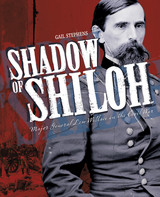 Shadow of Shiloh: Major General Lew Wallace in the Civil War
Gail Stephens
Indiana Historical Society Press, 2010 Thirty-two years after the battle of Shiloh, Lew Wallace returned to the battlefield, mapping the route of his April 1862 march. Ulysses S. Grant, Wallace's commander at Shiloh, expected Wallace and his Third Division to arrive early in the afternoon of April 6. Wallace and his men, however, did not arrive until nightfall, and in the aftermath of the bloodbath of Shiloh Grant attributed Wallace's late arrival to a failure to obey orders. By mapping the route of his march and proving how and where he had actually been that day, the sixty-seven-year-old Wallace hoped to remove the stigma of "Shiloh and its slanders." That did not happen. Shiloh still defines Wallace's military reputation, overshadowing the rest of his stellar military career and making it easy to forget that in April 1862 he was a rising military star, the youngest major general in the Union army.
Wallace was devoted to the Union, but he was also pursuing glory, fame, and honor when he volunteered to serve in April 1861. In Shadow of Shiloh: Major General Lew Wallace in the Civil War, author Gail Stephens specifically addresses Wallace's military career and its place in the larger context of Civil War military history.
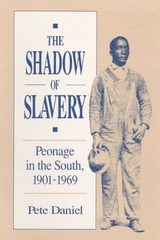 The Shadow of Slavery: Peonage in the South, 1901-1969
Pete Daniel
University of Illinois Press, 1972 Whether peonage in the South grew out of slavery, a natural and perhaps unavoidable interlude between bondage and freedom, or whether employers distorted laws and customs to create debt servitude, most Southerners quietly accepted peonage. To the employer it was a way to control laborers; to the peon it was a bewildering system that could not be escaped without risk of imprisonment, beating, or death.
Pete Daniel's book is about this largely ignored form of twentieth-century slavery. It is in part "the record of an American failure, the inability of federal, state, and local law-enforcement officers to end peonage." In a series of case studies and histories, Daniel re-creates the neglected and frightening world of peonage, demanding, "If a form of slavery yet exists in the United States, as so much evidence suggests, then the relevant questions are why, and by whose irresponsibility?"
Peonage grew out of labor settlements following emancipation, when employers forbade croppers to leave plantations because of debt (often less than $30). At the turn of the century the federal government acknowledged that the "labyrinth of local customs and laws" binding men in debt was peonage. They outlawed debt servitude and slowly moved against it, but with no large success. Disappearing witnesses and acquitted employers characterized the cases that did go to court.
Daniel holds that peonage persists for many reasons: the corruption and apathy of law-enforcement, racist traditions in the South, and the impotence of the Justice Department in prosecuting this violation of federal law. He draws extensively on complaints and trial transcripts from the peonage records of the Justice Department.
Shadow of the Hunter
Richard K. Nelson
University of Chicago Press, 1983 Shadow of the Hunter is a collection of stories based upon Richard Nelson's experiences in an Eskimo village of the Tareogmiut, or "people of the sea." The stories follow a group of hunters and their families through the cycle of an arctic year. Each chapter takes the reader into a different realm of the Eskimo world—from the quiet moments of families in far-flung camps to the intensity and passion of the hunt; from the times of fear and danger to those of security, triumph, and celebration.
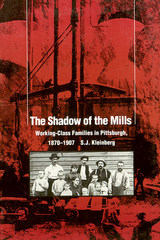 The Shadow Of The Mills: Working-Class Families in Pittsburgh, 1870–1907
S. J. Kleinberg
University of Pittsburgh Press, 1991
The profound disruption of family relationships caused by industrialization found its most dramatic expression in the steel mills of Pittsburgh in the 1880s. The work day was twelve hours, and the work week was seven days - with every other Sunday for rest.
In this major work, S. J. Kleinberg focuses on the private side of industrialization, on how the mills structured the everyday existence of the women, men, and children who lived in their shadows. What did industrialization and urbanization really mean to the people who lived through the these processes? What solutions did they find to the problems of low wages, poor housing, inadequate sanitation, and high mortality rates?
Through imaginative use of census data, the records of municipal, charitable, and fraternal organizations, and the voices of workers themselves in local newspapers, Kleinberg builds a detailed picture of the working-class life cycle: marital relationships, the interaction between parents and children, the education and employment prospects of the young, and the lives if the elderly.
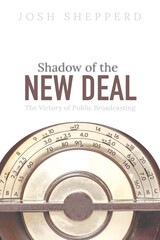 Shadow of the New Deal: The Victory of Public Broadcasting
Josh Shepperd
University of Illinois Press, 2023 Despite uncertain beginnings, public broadcasting emerged as a noncommercial media industry that transformed American culture. Josh Shepperd looks at the people, institutions, and influences behind the media reform movement and clearinghouse the National Association of Educational Broadcasters (NAEB) in the drive to create what became the Public Broadcasting Service and National Public Radio. Founded in 1934, the NAEB began as a disorganized collection of undersupported university broadcasters. Shepperd traces the setbacks, small victories, and trial and error experiments that took place as thousands of advocates built a media coalition premised on the belief that technology could ease social inequality through equal access to education and information. The bottom-up, decentralized network they created implemented a different economy of scale and a vision of a mass media divorced from commercial concerns. At the same time, they transformed advice, criticism, and methods adopted from other sectors into an infrastructure that supported public broadcasting in the 1960s and beyond.
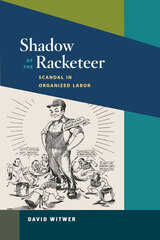 Shadow of the Racketeer: Scandal in Organized Labor
David Witwer
University of Illinois Press, 2008 Shadow of the Racketeer: Scandal in Organized Labor tells the story of organized crime's move into labor racketeering in the 1930s, focusing on a union corruption scandal involving payments from the largest Hollywood movie studios to the Chicago mob to ensure a pliant labor supply for their industry. The book details the work of crusading journalist Westbrook Pegler, whose scorching investigative work dramatically exposed the mob connections of top labor leaders George Scalise and William Bioff and garnered Pegler a Pulitzer Prize for reporting. From a behind-the-scenes perspective, David Witwer describes how Pegler and his publisher, the politically powerful Roy W. Howard, shaped the news coverage of this scandal in ways that obscured the corrupt ties between employers and the mob while emphasizing the perceived menace of union leaders empowered by New Deal legislation that had legitimized organized labor. Pegler, Howard, and the rest of the mainstream press pointedly ignored evidence of the active role that business leaders took in the corruption, which badly tarnished the newly reborn labor movement. Because he was more concerned with pursuing political gains for the conservative movement, Pegler's investigative journalism did little to reform union governance or organized crime's influence on labor unions. The union corruption scandal only undercut the labor movement. Pegler's continuing campaign against labor corruption framed the issue in ways that set the stage for postwar political defeats, culminating with the 1947 Taft-Hartley Act, which greatly limited the power of labor unions in the United States. Demonstrating clearly and convincingly how journalism is wielded as a political weapon, Witwer studies a broad range of forces at play in the labor union scandal and its impact, including the influence of the press, organized crime, political corruption, and businessmen following their own economic imperatives.
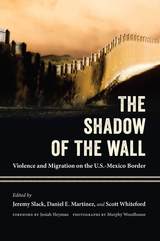 The Shadow of the Wall: Violence and Migration on the U.S.-Mexico Border
Edited by Jeremy Slack, Daniel E. Martínez, and Scott Whiteford; Foreword by Josiah Heyman; Photographs by Murphy Woodhouse
University of Arizona Press, 2018 Mass deportation is at the forefront of political discourse in the United States. The Shadow of the Wall shows in tangible ways the migration experiences of hundreds of people, including their encounters with U.S. Border Patrol, cartels, detention facilities, and the deportation process. Deportees reveal in their heartwrenching stories the power of family separation and reunification and the cost of criminalization, and they call into question assumptions about human rights and federal policies.
The authors analyze data from the Migrant Border Crossing Study (MBCS), a mixed-methods, binational research project that offers socially relevant, rigorous social science about migration, immigration enforcement, and violence on the border. Using information gathered from more than 1,600 post-deportation surveys, this volume examines the different faces of violence and migration along the Arizona-Sonora border and shows that deportees are highly connected to the United States and will stop at nothing to return to their families. The Shadow of the Wall underscores the unintended social consequences of increased border enforcement, immigrant criminalization, and deportation along the U.S.-Mexico border.
Contributors
Howard Campbell
Josiah Heyman
Alison Elizabeth Lee
Daniel E. Martínez
Ricardo Martínez-Schuldt
Emily Peiffer
Jeremy Slack
Prescott L. Vandervoet
Matthew Ward
Scott Whiteford
Murphy Woodhouse
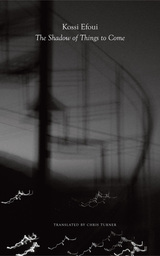 Shadow of Things to Come
Kossi Efoui
Seagull Books, 2013 Now in paperback, The Shadow of Things to Come and its catastrophic and carnivalesque dreamscape speak out against political rhetoric and the destruction of meaning by government.
In an unnamed African nation, the people are subject to a state of perpetual warfare and to an Orwellian abuse of language that strips from language its meaning and renders life senseless. And in a bare room lit only by moonlight, a young man hides, waiting for the mysterious crocodile-men to come and help him escape from the violent tyranny of the state. While he waits, he tells his story.
This is Kossi Efoui’s catastrophic and carnivalesque dreamscape, the dark setting of The Shadow of Things to Come. Here, men and women are taken in the night, spirited away from their families, and sent to plantation penal colonies to be worked to the edge of madness. When they return, they are empty shells, their lost time referred to as the “Time of Annexation.” But though his parents were taken, our protagonist survived, first in the care of a quirky benefactress named Mama Maize, then under the wing of the state itself, as a student at one of its elite schools. When he meets a bookseller named Axis Kemal, however, he has found a surrogate father, an eccentric and wise man who can bring him out of the meaningless confusion and tell him the truth about the society he lives in.
Through his characters, Efoui speaks out against atrocity and the abuse of power, but more, he writes against political rhetoric and the destruction of meaning by government. This novel is a love letter to language and, in Chris Turner’s dazzling translation, it becomes a stunning introduction for English-language readers to an exciting new talent.
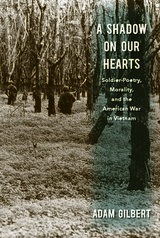 A Shadow on Our Hearts: Soldier-Poetry, Morality, and the American War in Vietnam
Adam Gilbert
University of Massachusetts Press, 2018 The American war in Vietnam was one of the most morally contentious events of the twentieth century, and it produced an extraordinary outpouring of poetry. Yet the complex ethical terrain of the conflict is remarkably underexplored, and the prodigious poetic voice of its American participants remains largely unheard. In A Shadow on Our Hearts, Adam Gilbert rectifies these oversights by utilizing the vast body of soldier-poetry to examine the war's core moral issues.
The soldier-poets provide important insights into the ethical dimensions of their physical and psychological surroundings before, during, and after the war. They also offer profound perspectives on the relationships between American soldiers and the Vietnamese people. From firsthand experiences, they reflect on what it meant to be witnesses, victims, and perpetrators of the war's violence. And they advance an uncompromising vision of moral responsibility that indicts a range of culprits for the harms caused by the conflict. Gilbert explores the powerful and perceptive work of these soldier-poets through the lens of morality and presents a radically alternative, deeply personal, and ethically penetrating account of the American war in Vietnam.
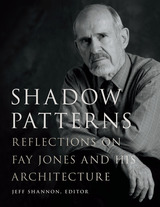 Shadow Patterns: Reflections on Fay Jones and His Architecture
Jeff Shannon
University of Arkansas Press, 2017 Winner, 2017 Ned Shank Award for Outstanding Preservation Publication from Preserve Arkansas
Shadow Patterns: Reflections on Fay Jones and His Architecture is a collection of critical essays and personal accounts of the man the American Institute of Architects honored with its highest award, the Gold Medal, in 1990. The essays range from the academic, with appreciations and observations by Juhanni Palaasma and Robert McCarter and Ethel Goodstein-Murphree, to personal reflections by clients and friends. Two of Arkansas’s most accomplished writers, Roy Reed and Ellen Gilchrist, who each live in Fay Jones houses, have provided intimate portrayals of what it’s like to live in, and manage the quirks of, a “house built by a genius,” where “light is everywhere. . . . Everything is quiet, and everything is a surprise,” as Gilchrist says. Through this compendium of perspectives, readers will learn about Jones’s personal qualities, including his strong will, his ability to convince other people of the rightness of his ideas, and yet his willingness, at times, to change his mind. We also enter into the work: powerful architecture like Stoneflower and Thorncrown Chapel and Pinecote Pavilion, along with private residences ranging from the modest to the monumental. And we learn about his relationship with his mentor, Frank Lloyd Wright. Shadow Patterns broadens and enriches our understanding of this major figure in American architecture of the twentieth century.
Shadow Puppets, Songs, and Sacred Feasts: Celebrations of the Indo-Portuguese Nuns in the Eighteenth-Century Real Convento de Santa Mónica, Goa, India. A Bilingual Edition
Edited by Daniel Michon
Iter Press, 2025 The two eighteenth-century texts translated here offer a rare glimpse into the creative lives of cloistered nuns in Asia, providing a valuable example of early modern "other voices" in a colonial context.
The Entrada de Bonifrate para Festa dos Reis, a shadow puppet play for the feast of the Kings, and the Cartepaço da Muzica, a songbook for the feast of St. John, showcase the imaginative minds of the nuns at the Indo-Portuguese Real Convento de Santa Mónica, Goa, India. Composed for private convent audiences, these texts blend Portuguese and Spanish baroque elements with local Goan traditions. The uncensored verses celebrate convent life, critique local social norms, and affirm the nuns’ community identity, exhibiting the Mónicas’ musical talents and literary sensibilities.
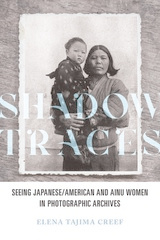 Shadow Traces: Seeing Japanese/American and Ainu Women in Photographic Archives
Elena Tajima Creef
University of Illinois Press, 2022 Images of Japanese and Japanese American women can teach us what it meant to be visible at specific moments in history. Elena Tajima Creef employs an Asian American feminist vantage point to examine ways of looking at indigenous Japanese Ainu women taking part in the 1904 Louisiana Purchase Exposition; Japanese immigrant picture brides of the early twentieth century; interned Nisei women in World War II camps; and Japanese war brides who immigrated to the United States in the 1950s. Creef illustrates how an against-the-grain viewing of these images and other archival materials offers textual traces that invite us to reconsider the visual history of these women and other distinct historical groups. As she shows, using an archival collection’s range as a lens and frame helps us discover new intersections between race, class, gender, history, and photography. Innovative and engaging, Shadow Traces illuminates how photographs shape the history of marginalized people and outlines a method for using such materials in interdisciplinary research.
Shadowboxing: poems & impersonations
Joseph Rios
Omnidawn, 2017 Borrowing the poetic language found in boxing lore and in the Rocky films, Shadowboxing pieces together a poetic portrait of Josefo, a Chicano adolescent working and becoming a poet in the farm territories of Central California. Rios confounds the relationship between author, speaker, and subject within various forms and, at times, across genre. He challenges the usefulness of poetry and stands upon oral histories to demystify California’s overlooked labor class. Rios invites the reader to enter Josefo’s world of memory, experience, and talk, of packinghouse mentors, storytelling grandmothers, parable-sharing plumbers, smooth talking truck drivers, and infinitely patient literature professors.
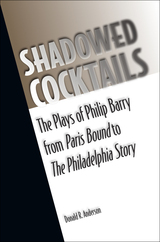 Shadowed Cocktails: The Plays of Philip Barry from Paris Bound to The Philadelphia Story
Donald R. Anderson
Southern Illinois University Press, 2010 An important and prolific playwright, Philip Barry wrote hit plays such as The Philadelphia Story and Holiday. However, he has been largely forgotten and no book-length analysis of his work has appeared in more than forty years. With this book, Donald R. Anderson rescues the playwright from obscurity. Although Barry’s successes were with comedies of manners, he also wrote dramatic and experimental works. Anderson analyzes all of Barry’s plays (twenty-one in total) and questions the traditional characterization of the American playwright’s work. He begins with Barry’s early plays concerning intergenerational tensions and lessons learned from the Great War. Subsequent chapters explore Barry’s preoccupation with fidelity and infidelity, his struggles with his Catholic beliefs, and his investigations into sources of evil and despair. Anderson also looks at the plays of the late 1930s and the 1940s, including the posthumously produced Second Threshold. One chapter is devoted to Barry’s synergistic relationship with Katharine Hepburn: her role in lifting the playwright out of a mid-1930s slump and his role in rescuing her from the label of “box-office poison” with both The Philadelphia Story and the World War II drama Without Love. Anderson places Barry within the context of his times but also shows him drawing on past influences and anticipating theatrical developments of the latter part of the twentieth century. Part cultural history, part literary analysis, Shadowed Cocktails is sure to revitalize interest in this remarkable American author. and his role in rescuing her from the label of 'box-office poison' with both The Philadelphia Story and the World War II drama Without Love.
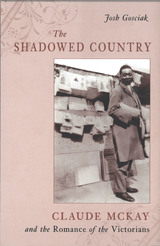 The Shadowed Country: Claude McKay and the Romance of the Victorians
Gosciak, Josh
Rutgers University Press, 2006 One of the most important voices of the Harlem Renaissance, Claude McKay is largely recognized for his work during the 1920s, which includes a major collection of poems, Harlem Shadows, as well as a critically acclaimed novel, Home to Harlem. But McKay was never completely comfortable with his literary reputation during this period. Throughout his world travels, he saw himself as an English lyricist. In this compelling examination of the life and works of this complex poet, novelist, journalist, and short story writer, Josh Gosciak sheds light on McKay’s literary contributions beyond his interactions with Harlem Renaissance artists and writers. Working within English literary traditions, McKay crafted a verse out of hybridity and diaspora. Gosciak shows how he reinvigorated a modern pastoral through his encounters with some of the major aesthetic and political movements of the late Victorian and early modern periods. Exploring new archival material as well as many of McKay’s lesser known poetic works, TheShadowed Country provides a unique interpretation of the writings of this major author.
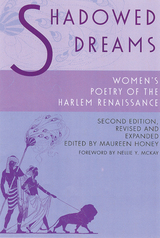 Shadowed Dreams: Women's Poetry of the Harlem Renaissance
McKay, Nellie
Rutgers University Press, 2006 The first edition of Shadowed Dreams was a groundbreaking anthology that brought to light the contributions of women poets to the Harlem Renaissance. This revised and expanded version contains twice the number of poems found in the original, many of them never before reprinted, and adds eighteen new voices to the collection to once again strike new ground in African American literary history. Also new to this edition are nine period illustrations and updated biographical introductions for each poet.
Shadowed Dreams features new poems by Gwendolyn Bennett, Anita Scott Coleman, Mae Cowdery, Blanche Taylor Dickinson, Alice Dunbar-Nelson, Jessie Fauset, Angelina Weld Grimké, Gladys Casely Hayford (a k a Aquah Laluah), Virginia Houston, Georgia Douglas Johnson, Helene Johnson, Effie Lee Newsome, Esther Popel, and Anne Spencer, as well as writings from newly discovered poets Carrie Williams Clifford, Edythe Mae Gordon, Alvira Hazzard, Gertrude Parthenia McBrown, Beatrice Murphy, Lucia Mae Pitts, Grace Vera Postles, Ida Rowland, and Lucy Mae Turner, among others.
Covering the years 1918 through 1939 and ranging across the period’s major and minor journals, as well as its anthologies and collections, Shadowed Dreams provides a treasure trove of poetry from which to mine deeply buried jewels of black female visions in the early twentieth century.
Shadowed Ground: America’s Landscapes of Violence and Tragedy
By Kenneth E. Foote
University of Texas Press, 2003 Winner, John Brinckerhoff Jackson Prize, Association of American Geographers, 1997 Shadowed Ground explores how and why Americans have memorialized—or not—the sites of tragic and violent events spanning three centuries of history and every region of the country. For this revised edition, Kenneth Foote has written a new concluding chapter that looks at the evolving responses to recent acts of violence and terror, including the destruction of the Branch Davidian compound at Waco, Texas, the Oklahoma City bombing, the Columbine High School massacre, and the terrorist attacks of 9/11.
Shadowing Function from Randomly Rough Surfaces: Derivation and applications
Christophe Bourlier
The Institution of Engineering and Technology, 2019 The shadowing function is an important element in the simulation and calculation of how electromagnetic waves scatter at randomly rough surfaces. Its derivation and use is an active, interdisciplinary area of research with practical applications in fields such as radar, optics, acoustics, geoscience, computer graphics and remote sensing.
 The Shadowlands of Conduct: Ethics and State Politics
Beth A. Rosenson
Georgetown University Press, 2005 Although the linking of "ethics" and "politics" may seem more like the ingredients for a comedian's monologue, it is a sober issue and one that affects every American—especially when it comes to state politics, where the cynical might say ethics can never survive. To find examples of the latest corruption du jour, all one has to do is turn to the newspaper, or switch on the local newscast (think Illinois and New Jersey). Scandals have been ubiquitous since the beginning of the Republic, but it wasn't until 1954 that ethical self-regulation began to move legislatively beyond bribery statutes to address deeper issues—those which, in New York Governor Thomas Dewey's words, skulked in the "shadowlands of conduct." Rosenson begins her exploration with that moment when New York became the first state to enact a general ethics law, setting standards and guidelines for behavior. Unforgiving and illuminating, she examines the many laws that have been enacted since and the reasons that many of these law came into being. It is crucial to the functioning of a democratic government to understand how and why ethics laws vary across legislatures, and it is surprising to discover that many states have become far more stringent than the U.S. Congress in laws and regulations. Using both qualitative historical sources and rigorous statistical analysis, Rosenson examines when and why, from 1954 to the present, legislators have enacted ethics laws that seem to threaten their own well-being. Among the economic, political, and institutional factors considered that have helped or hindered the passage of these laws, the most consistent was pure scandal, abetted by the media. To have good government, one must be able to trust it, and this book can help all citizens understand and find their way out of the shadowlands into the light.
Shadows and Clouds
Marcus Stewart
Omnidawn, 2023 Stories that question our experience of time, truth, and memory.
Through the stories in Shadows and Clouds, Marcus Stewart invites us to consider how things are not always as they appear or as we remember them, instead locating reality in the imagination and the dream world. While animals understand the world without words, humans create our experiences as stories, translating past and future into tales told in the present. Stewart's stories take the notion of storytelling and expand to a consideration of how truth, misremembering, logic, lying, and uncertainty play together to affect our experience of reality. In an alternate reading of time, Stewart poses the suggestion that you may already have a future memory of reading this book, and reading the stories backward may bring us back to the present.
Shadows and Clouds is the winner of the 2021 Omnidawn Fabulist Fiction Chapbook / Novelette Contest, chosen by Theodora Ziolkowski.
Shadows Burning
W.S. Di Piero
Northwestern University Press, 1995 Shadows Burning is a poetry book that wrestles with its angels—domestic love, fruition and desiccation, the passion for words that will suffice at bringing to light and shadow ground between the inner and outer life.
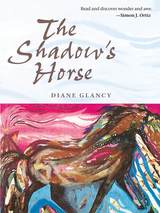 The Shadow’s Horse
Diane Glancy
University of Arizona Press, 2003 There is a saying in Native American tradition that "wholeness is when the shadow of the rider and his horse are one." Although we usually focus our attention on what seems most real, Diane Glancy shows us that the shadow of our past has substance as well. The Shadow's Horse is a new collection of poems in which Glancy walks the margin between her white and Indian heritage. In poems that conjure the persistence of fallen leaves or juxtapose images of Christ and the stockyards, she powerfully evokes place and spirit to address with intelligence and beauty issues of family, work, and faith. In some of these poems Glancy recalls growing up with her Cherokee father, who worked in a stockyard, radically applying Christian theology to the slaughter of non-human creatures: The cattle go up the ramp
dragging their crosses.
Their voices are Gregorian chants
rising to the blue sky,
the cold clouds. In others she examines the walk of history through the ordinary details of life-history seen from two points of view, early Euro-American and contemporary Native American. She sees her Native heritage as shortlived and fragile, yet as enduring as leaves, and she asks, "If you line up all the leaves that fall / how many times will they go around the earth?" Writing in a cross-boundaried, fragmented voice—a voice based on the memory of the way language sounded when it was stretched across the cultures or walked in both worlds—Glancy has fashioned a book about speaking oneself into existence. The Shadow's Horse is the story of one culture made to sing the song of another until the Native voice is so erased it is nearly an illusion. Yet as readers of these poems will discover, the shadow of the past is as real as the horse it rides.
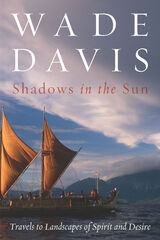 Shadows in the Sun: Travels to Landscapes of Spirit and Desire
Wade Davis
Island Press, 1998 Wade Davis has been called "a rare combination of scientist, scholar, poet and passionate defender of all of life's diversity." In Shadows in the Sun, he brings all of those gifts to bear on a fascinating examination of indigenous cultures and the interactions between human societies and the natural world.
Ranging from the British Columbian wilderness to the jungles of the Amazon and the polar ice of the Arctic Circle, Shadows in the Sun is a testament to a world where spirits still stalk the land and seize the human heart. Its essays and stories, though distilled from travels in widely separated parts of the world, are fundamentally about landscape and character, the wisdom of lives drawn directly from the land, the hunger of those who seek to rediscover such understanding, and the consequences of failure.
As Davis explains, "To know that other, vastly different cultures exist is to remember that our world does not exist in some absolute sense but rather is just one model of reality. The Penan in the forests of Borneo, the Vodoun acolytes in Haiti, the jaguar Shaman of Venezuela, teach us that there are other options, other possibilities, other ways of thinking and interacting with the earth." Shadows in the Sun considers those possibilities, and explores their implications for our world.
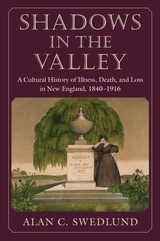 Shadows in the Valley: A Cultural History of Illness, Death, and Loss in New England, 1840-1916
Alan Swedlund
University of Massachusetts Press, 2010 How does the experience of sickness, death, and loss change over time? We know that the incidence and virulence of particular diseases have varied from one period to another, as has their medical treatment. But what was it like for the individuals who suffered and died from those illnesses, for the health practitioners and institutions that attended to them, and for the families who buried and mourned them?
In Shadows in the Valley, Alan Swedlund addresses these questions by closely examining the history of mortality in several small communities in western Massachusetts from the mid-nineteenth to the early twentieth century—from just before the acceptance of the germ theory of disease through the early days of public health reform in the United States. This was a time when most Americans lived in rural areas or small towns rather than large cities. It was also a time when a wide range of healing practices was available to the American public, and when the modern form of Western medicine was striving for dominance and authority. As Swedlund shows, this juncture of competing practices and ideologies provides a rich opportunity for exploring the rise of modern medicine and its impact on the everyday lives of ordinary Americans.
To indicate how individuals in different stages of their lives were exposed to varying assaults on their health, the book is structured in a way that superimposes what the author calls "life-course time" onto chronological time. Thus the early chapters look at issues of infancy and childhood in the 1840s and 1850s and the last chapters at the problems of old age after 1900. The reader becomes familiar with specific individuals and families as they cope with the recurrent loss of children, struggle to understand the causes of new contagions, and seek to find meaning in untimely death. By using a broad time frame and a narrow geographical lens, Swedlund is able to engage with both the particularities and generalities of evolving medical knowledge and changing practice, and to highlight the differences in personal as well as collective responses to illness and loss.
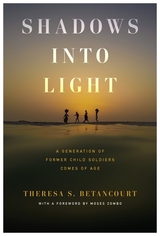 Shadows into Light: A Generation of Former Child Soldiers Comes of Age
Theresa S. Betancourt
Harvard University Press, 2025 A twenty-plus-year study of former child soldiers offers far-reaching insight into mental health and resilience after extreme trauma.
During the civil war that ravaged Sierra Leone from 1991 to 2002, an estimated 20,000 children were forced to join the fighting. As villages were raided and youths rounded up, it was not uncommon for a child to be ordered to kill a friend, relative, or neighbor under threat of being killed themselves. The goal was to make it impossible for the captives to return home and be accepted back into their communities.
But when the conflict ended, many of the children did find their way home. Could they reintegrate after such extreme trauma? Theresa Betancourt and her collaborators in Sierra Leone launched a study of more than 500 boys and girls who had been pulled into the war, tracking them for over two decades. The results were surprising: despite everything they had suffered, this was not a lost generation. In fact, the most dominant trend over time was one of healing and increasing acceptance. The lives of the former child soldiers were shaped not just by their personal ordeals but also, crucially, by the responses of their families, peers, and broader communities. Filled with vivid personal stories, Shadows into Light describes heartbreak and despair but also remarkable triumphs made possible by layers of social support and encouragement.
Betancourt’s study provides unparalleled insight into the long-term psychological and developmental effects of family separation, war, and exposure to violence. The lessons go far beyond Sierra Leone’s tragedy, suggesting that we should, in general, think of children’s risk and resilience more as products of the post-trauma environment than as individual traits.
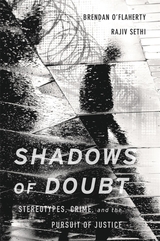 Shadows of Doubt: Stereotypes, Crime, and the Pursuit of Justice
Brendan O'Flaherty and Rajiv Sethi
Harvard University Press, 2019 Shadows of Doubt reveals how deeply stereotypes distort our interactions, shape crime, and deform the criminal justice system.
If you’re a robber, how do you choose your victims? As a police officer, how afraid are you of the young man you’re about to arrest? As a judge, do you think the suspect in front of you will show up in court if released from pretrial detention? As a juror, does the defendant seem guilty to you? Your answers may depend on the stereotypes you hold, and the stereotypes you believe others hold. In this provocative, pioneering book, economists Brendan O’Flaherty and Rajiv Sethi explore how stereotypes can shape the ways crimes unfold and how they contaminate the justice system through far more insidious, pervasive, and surprising paths than we have previously imagined.
Crime and punishment occur under extreme uncertainty. Offenders, victims, police officers, judges, and jurors make high-stakes decisions with limited information, under severe time pressure. With compelling stories and extensive data on how people act as they try to commit, prevent, or punish crimes, O’Flaherty and Sethi reveal the extent to which we rely on stereotypes as shortcuts in our decision making. Sometimes it’s simple: Robbers tend to target those they stereotype as being more compliant. Other interactions display a complex and sometimes tragic interplay of assumptions: “If he thinks I’m dangerous, he might shoot. I’ll shoot first.”
Shadows of Doubt shows how deeply stereotypes are implicated in the most controversial criminal justice issues of our time, and how a clearer understanding of their effects can guide us toward a more just society.
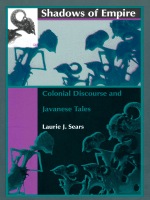 Shadows of Empire: Colonial Discourse and Javanese Tales
Laurie J. Sears
Duke University Press, 1996 Shadows of Empire explores Javanese shadow theater as a staging area for negotiations between colonial power and indigenous traditions. Charting the shifting boundaries between myth and history in Javanese Mahabharata and Ramayana tales, Laurie J. Sears reveals what happens when these stories move from village performances and palace manuscripts into colonial texts and nationalist journals and, most recently, comic books and novels. Historical, anthropological, and literary in its method and insight, this work offers a dramatic reassessment of both Javanese literary/theatrical production and Dutch scholarship on Southeast Asia.
Though Javanese shadow theater (wayang) has existed for hundreds of years, our knowledge of its history, performance practice, and role in Javanese society only begins with Dutch documentation and interpretation in the nineteenth century. Analyzing the Mahabharata and Ramayana tales in relation to court poetry, Islamic faith, Dutch scholarship, and nationalist journals, Sears shows how the shadow theater as we know it today must be understood as a hybrid of Javanese and Dutch ideas and interests, inseparable from a particular colonial moment. In doing so, she contributes to a re–envisioning of European histories that acknowledges the influence of Asian, African, and New World cultures on European thought—and to a rewriting of colonial and postcolonial Javanese histories that questions the boundaries and content of history and story, myth and allegory, colonialism and culture.
 Shadows of Ethics: Criticism and the Just Society
Geoffrey Galt Harpham
Duke University Press, 1999 In this volume Geoffrey Galt Harpham argues for a deeply original view of the relations among ethics, literary study, and critical theory. In thirteen lucid, provocative and often witty essays, Harpham rejects both the optimism of those who see ethics as a way of solving problems about values or principles and the pessimism of those who regard ethics as primarily a cover story for politics.
Ethics, he claims, has been seen by its most powerful theorists as a discourse of “shadows,” a characteristic disturbance of thought in the presence of the other, a source of doubts rather than certainty. At the same time, however, ethics includes an element of violence, even blindness and “fundamentalism,” a crushing drive to clarity and resolution. Contemporary thinkers, Harpham argues, have been unwilling to accept this account of ethics and the obligations it would impose, and have, as a consequence, cultivated social and intellectual marginality as the only site of virtue, the only position in which critical intelligence is at home. They have, he contends, failed to “imagine the center,” to take up the true intellectual and worldly challenge of ethics.
Tracking these issues and energies in debates about enlightenment, the politics of the aesthetic, the nature of rationality, and the worldly contexts of theory, Harpham demonstrates in compelling detail the ubiquity and true difficulty of ethics. Shadows of Ethics also revives a neglected genre, the intellectual portrait, with extended meditations on Jacques Derrida, Martha Nussbaum, Fredric Jameson, Geoffrey Hartman, and Noam Chomsky.
The book will interest literary critics, philosophers, cultural critics, and all those interested in the ethical character of intellectual work.
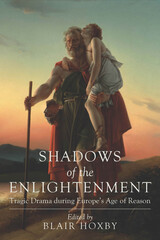 Shadows of the Enlightenment: Tragic Drama during Europe’s Age of Reason
Edited by Blair Hoxby
Ohio State University Press, 2022 To refer to Enlightenment tragedy is to teeter on the brink of paradox. The eighteenth century is famous for its celebration and deployment of ideals such as optimism, reason, and human progress—ideals seemingly contradicted by the pessimism and passion of much classical tragedy. Moreover, tragedy in the Enlightenment is also often overlooked in favor of its illustrious seventeenth-century predecessors. In Shadows of the Enlightenment, an assemblage of respected experts specializing in classical, eighteenth-century, comparative, and modernist literary traditions offer a corrective analysis, proving that the Enlightenment was a critical period for tragic drama, during which the signature classical influences of the era coexisted with an emerging modern identity. By analyzing a highly diverse set of works—from Johann Christoph Gottsched to Voltaire to Joanna Baillie—with a rare pan-European scope, the contributors excavate the dynamic, and indeed paradoxical, entanglement of antiquity and modernity encapsulated by Enlightenment tragedy. Contributors: Joshua Billings, Logan J. Connors, Adrian Daub, Cécile Dudouyt, James Harriman-Smith, Joseph Harris, Alex Eric Hernandez, Blair Hoxby, Russ Leo, Larry F. Norman, Stefan Tilg
 Shadows of Treblinka
Miriam Kuperhand and Saul Kuperhand
University of Illinois Press, 1998 Unique and compelling, this husband-and-wife memoir of the Holocaust
will move and inform generations. As we lose eyewitnesses to this ultimate
horror, the Kuperhands present us with an elegantly restrained, yet hard-hitting,
Kaddish to Polish Jewry.
Miriam was the daughter of a prosperous furrier; Saul was the son of
a poor shoemaker. Miriam was sixteen when she and her brother roamed the
wild countryside of Poland, searching for food and shelter--and for their
parents. Saul was only a few years older when he watched the smoke rising
from the crematoria and knew that his parents, sister, and eight brothers
were gone forever. Miriam lived by hiding; Saul lived by escaping from
the camp.
The authors emphasize the essential role that Polish Christians played
in their survival and stress that wit, courage, faith, luck, and even
a strong will to live were worthless without their help.
The travail of their survival is wrenching yet comforting, tragic yet
upbeat, cinematic yet intimate. Shadows of Treblinka will haunt
and inspire its readers.
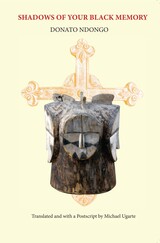 Shadows of Your Black Memory
Donato Ndongo
Swan Isle Press, 2007 Set during the last years of Spanish rule in Equatorial Guinea, Shadows of Your Black Memory presents the voice of a young African man reflecting on his childhood. Through the idealistic eyes of the nameless protagonist, Donato Ndongo portrays the cultural conflicts between Africa and Spain, ancestral worship competing with Catholicism, and tradition giving way to modernity. The backdrop of a nation moving toward a troubled independence parallels the young man’s internal struggle to define his own identity.
Now in paperback, Shadows of Your Black Memory masterfully exposes the cultural fissures of Ndongo’s native land. “Spanish Guinea” is a heated, sensual landscape with exotic animals and trees, ancient rituals, ghosts, saints, and sinners. We come to know the narrator’s extended family, the people of his village, merchants, sorcerers, and Catholic priests; we see them critically at times, even humorously, yet always with compassion and a magical dignity. Michael Ugarte’s sensitive translation captures the spirit of the original Spanish prose and makes Ndongo’s powerful, gripping tale available to English-speaking readers for the first time.
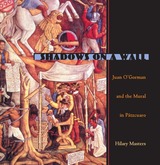 Shadows On A Wall: Juan O’Gorman and the Mural in Patzcuaro
Hilary Masters
University of Pittsburgh Press, 2005
Novelist and essayist Hilary Masters recreates a moment in 1940s Pittsburgh when circumstances, ideology, and a passion for the arts collided to produce a masterpiece in another part of the world.
E. J. Kaufmann, the so-called "merchant prince" who commissioned Frank Lloyd Wright's Fallingwater, was a man whose hunger for beauty included women as well as architecture.
He had transformed his family's department store into an art deco showcase with murals by Boardman Robinson and now sought to beautify the walls of the YM&WHA of which he was the president. Through his son E. J. Kaufmann, jr (the son preferred the lowercase usage), he met Juan O'Gorman, a rising star in the Mexican pantheon of muralists dominated by Diego Rivera, O'Gorman's friend and mentor.
O'Gorman and his American wife spent nearly six months in Pittsburgh at Kaufmann's invitation while the artist researched the city's history and made elaborate cartoons for the dozen panels of the proposed mural. Like Rivera, O'Gorman was an ardent Marxist whose views of society were radically different from those of his host, not to mention the giants of Pittsburgh's industrial empire-Carnegie, Frick, and Mellon. The murals were never painted, but why did Kaufmann commission O'Gorman in the first place? Was it only a misunderstanding?
In the discursive manner for which his fiction and essays are noted, Masters pulls together the skeins of world events, the politics of art patronage, and the eccentric personalities and cruel histories of the period into a pattern that also includes the figures of O'Gorman and his wife Helen, and Kaufmann, his wife Liliane, and their son. Masters traces the story through its many twists and turns to its surprising ending: E. J. Kaufmann's failure to put beautiful pictures on the walls of the Y in Pittsburgh resulted in Juan O'Gorman's creation of a twentieth-century masterpiece on a wall in the town of Pátzcuaro, Mexico.
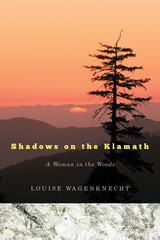 Shadows on the Klamath: A Woman in the Woods
Louise Wagenknecht
Oregon State University Press, 2021 In 1973, Louise Wagenknecht was just another college graduate, but unlike many, she wanted to go home, back to the Klamath Mountains where she was raised. When a job offer from the Klamath National Forest gave her that chance, she jumped at it. She landed in the logging town of Happy Camp, where she’d spent part of her childhood, as chronicled in her previous memoirs, White Poplar, Black Locust and Light on the Devils.
With Shadows on the Klamath, Louise Wagenknecht completes her trilogy about life in remote northwestern California. In this new work, she recounts her years in the Forest Service, starting as a clerical worker on the Klamath National Forest before moving to a field position where she did everything from planting trees to fighting fires.
Her story is about a Forest Service in transition, as forest management practices began to shift. Not least among these changes was the presence of women in the ranks—a change that many in the Forest Service resisted. Wagenknecht blends the personal and professional to describe land management in the West and the people who do it—their friendships, rivalries, and rural communities.
Anyone with an interest in the Klamath-Siskiyou region, or the history of women in natural resource agencies, or the many issues associated with industrial forestry, should read this book for its valuable firsthand perspective. General readers interested in the rural West and personal memoir will also be richly rewarded.
Shadows on the Past: Studies in the Historical Fiction Film
Leger Grindon
Temple University Press, 1994 Studying popular Hollywood films from Gone With the Wind to Reds and such distinguished European films as La Marseillaise and The Rise to Power of Louis XIV, Leger Grindon examines how historical fiction films interpret the present through a representation of the past. The historical fiction film is characterized by a set of motives and, Grindon argues, deserves to be considered a genre unto itself. Appropriation of historical events can insinuate a film's authority of its subject, veil an intention, provide an escape into nostalgia, or direct a search for knowledge and origins. Utilizing the past as a way of responding to social conflicts in the present, Grindon shows how the genre promotes a political agenda, superseding the influence of scholarship on the public's perception and interpretation of history.
In the series Culture and the Moving Image, edited by Robert Sklar.
Shadows Over Sunnyside: An Arkansas Plantation in Transition, 1830-1945
Jeannie M. Whayne
University of Arkansas Press, 1993 This remarkable collection of essays addresses social, historical, cultural, and labor issues as they affect a Southern plantation. The heart of the book is an examination of a "great experiment" to import Italian laborers to Sunnyside Plantation. From the crucible of tensions that this experiment produced, the reader obtains a concrete understanding of the implications of U.S. immigration policy, of changing labor relations following Reconstruction, and of a minority culture's introduction into the Delta.
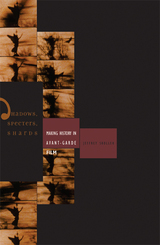 Shadows, Specters, Shards: Making History in Avant-Garde Film
Jeffrey Skoller
University of Minnesota Press, 2005 Avant-garde films are often dismissed as obscure or disconnected from the realities of social and political history. Jeffrey Skoller challenges this myth, arguing that avant-garde films more accurately display the complex interplay between past events and our experience of the present than conventional documentaries and historical films. Shadows, Specters, Shards examines a group of experimental films, including work by Eleanor Antin, Ernie Gehr, and Jean-Luc Godard, that take up historical events such as the Holocaust, Latin American independence struggles, and urban politics. Identifying a cinema of evocation rather than representation, these films call attention to the unrepresentable aspects of history that profoundly impact the experience of everyday life. Making use of the critical theories of Walter Benjamin and Gilles Deleuze, among others, Skoller analyzes various narrative strategies - allegory, sideshadowing, testimony, and multiple temporalities - that uncover competing perspectives and gaps in historical knowledge often ignored in conventional film. In his discussion of avant-garde film of the 1970s, 1980s, and 1990s, Skoller reveals how a nuanced understanding of the past is inextricably linked to the artistry of image making and storytelling.
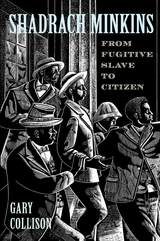 Shadrach Minkins: From Fugitive Slave to Citizen
Gary Collison
Harvard University Press, 1997 On February 15, 1851, Shadrach Minkins was serving breakfast at a coffeehouse in Boston when history caught up with him. The first runaway to be arrested in New England under the 1850 Fugitive Slave Law, this illiterate Black man from Virginia found himself the catalyst of one of the most dramatic episodes of rebellion and legal wrangling before the Civil War. In a remarkable effort of historical sleuthing, Gary Collison has recovered the true story of Shadrach Minkins’ life and times and perilous flight. His book restores an extraordinary chapter to our collective history and at the same time offers a rare and engrossing picture of the life of an ordinary Black man in nineteenth-century North America.
As Minkins’ journey from slavery to freedom unfolds, we see what day-to-day life was like for a slave in Norfolk, Virginia, for a fugitive in Boston, and for a free Black man in Montreal. Collison recreates the drama of Minkins’s arrest and his subsequent rescue by a band of Black Bostonians, who spirited the fugitive to freedom in Canada. He shows us Boston’s Black community, moved to panic and action by the Fugitive Slave Law, and the previously unknown community established in Montreal by Minkins and other refugee Blacks from the United States. And behind the scenes, orchestrating events from the disastrous Compromise of 1850 through the arrest of Minkins and the trial of his rescuers, is Daniel Webster, who through the exigencies of his dimming political career, took the role of villain.
Webster is just one of the familiar figures in this tale of an ordinary man in extraordinary circumstances. Others, such as Frederick Douglass, Richard Henry Dana, Jr., Harriet Jacobs, and Harriet Beecher Stowe (who made use of Minkins’s Montreal community in Uncle Tom’s Cabin), also appear throughout the narrative. Minkins’ intriguing story stands as a fascinating commentary on the nation’s troubled times—on urban slavery and Boston abolitionism, on the Underground Railroad, and on one of the federal government’s last desperate attempts to hold the Union together.
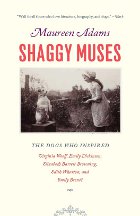 Shaggy Muses: The Dogs who Inspired Virginia Woolf, Emily Dickinson, Elizabeth Barrett Browning, Edith Wharton, and Emily Brontë
Maureen Adams
University of Chicago Press, 2011 “You’ll call this sentimental—perhaps—but then a dog somehow represents the private side of life, the play side,” Virginia Woolf confessed to a friend. In this charming and engaging book, Maureen Adams celebrates this private, playful side telling readers about the relationships between five remarkable women writers and their dogs. In Shaggy Muses, Adams explores the work and lives of these authors through the various roles played by their most devoted companions. Elizabeth Barrett Browning was rescued from a life of passivity and illness by Flush, a lively, possessive (and frequently dog-napped!) golden Cocker Spaniel. Emily Brontë’s fierce Mastiff mix, Keeper, provided a safe and loving outlet for the writer’s equally fierce spirit. Emily Dickinson found companionship with Carlo, the gentle, giant Newfoundland who soothed her emotional terrors. A troop of ever-faithful Pekingese warmed Edith Wharton’s lonely heart during her restless travels among Europe and America’s social and intellectual elite. And Virginia Woolf developed a deep attachment to Pinka, a black Cocker Spaniel who was both gift from her lover, Vita Sackville-West, and a link to her husband Leonard. Based on diaries, letters, and other contemporary accounts—and featuring many illustrations of the writers and their dogs—these five miniature biographies allow unparalleled intimacy with women of genius in their hours of domestic ease and inner vulnerability.
Shahr-E-Jaanaan: The City of the Beloved
Adeeba Shahid Talukder
Tupelo Press, 2020 Shahr-e-jaanaan sets out to recreate the universe of Urdu and Persian poetic tradition, its tropes both lenses and mirrors for the speaker’s reality. As she maps her romances onto legends, directing their characters perform her own tragedy, their fantastical metaphors easily lend themselves to her fluctuating mental state. Cycling between delirious grandeur and wretched despair, she is torn between two selves— the pitiable lover continually rejected, and the cruel, unattainable beloved comparable in her exaltation to a god. Shahr-e-jaanaan explores, interrogates, and distorts these dichotomies and their symbolism, calling into question the forces that elevate some to divinity even as they damn others to injustice and oppression.
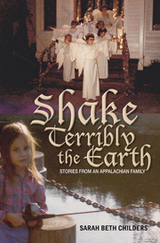 Shake Terribly the Earth: Stories from an Appalachian Family
Sarah Beth Childers
Ohio University Press, 2013 Sarah Beth Childers grew up listening to stories. She heard them riding to school with her mother, playing Yahtzee in her Granny’s nicotine cloud, walking to the bowling alley with her grandfather, and eating casseroles at the family reunions she attended every year.
In a thoughtful, humorous voice born of Appalachian storytelling, Childers brings to life in these essays events that affected the entire region: large families that squeezed into tiny apartments during the Great Depression, a girl who stepped into a rowboat from a second-story window during Huntington’s 1937 flood, brothers who were whisked away to World War II and Vietnam, and a young man who returned home from the South Pacific and worked his life away as a railroad engineer.
Childers uses these family tales to make sense of her personal journey and find the joy and clarity that often emerge after the earth shakes terribly beneath us.
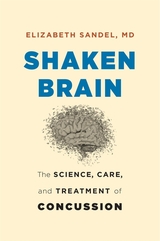 Shaken Brain: The Science, Care, and Treatment of Concussion
Elizabeth Sandel, MD
Harvard University Press, 2020 A physician with thirty-five years of experience treating people with brain injuries shares the latest research on concussions and best practices for care.
The explosion of attention to sports concussions has many of us thinking about the addled brains of our football and hockey heroes. But concussions happen to everyone, not just elite athletes. Children fall from high chairs, drivers and cyclists get into accidents, and workers encounter unexpected obstacles on the job. Concussions are prevalent, occurring even during everyday activities. In fact, in less time than it takes to read this sentence, three Americans will experience a concussion. The global statistics are no less staggering.
Shaken Brain offers expert advice and urgently needed answers. Elizabeth Sandel, MD, is a board-certified physician who has spent more than three decades treating patients with traumatic brain injuries, training clinicians, and conducting research. Here she explains the scientific evidence for what happens to the brain and body after a concussion. And she shares stories from a diverse group of patients, educating readers on prevention, diagnosis, and treatment. Few people understand that what they do in the aftermath of their injury will make a dramatic difference to their future well-being; patient experiences testify to the best practices for concussion sufferers and their caregivers. Dr. Sandel also shows how to evaluate risks before participating in activities and how to use proven safety strategies to mitigate these risks.
Today concussions aren’t just injuries—they’re big news. And, like anything in the news, they’re the subject of much misinformation. Shaken Brain is the resource patients and their families, friends, and caregivers need to understand how concussions occur, what to expect from healthcare providers, and what the long-term consequences may be.
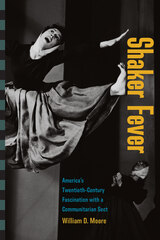 Shaker Fever: America's Twentieth-Century Fascination with a Communitarian Sect
William D. Moore
University of Massachusetts Press, 2020 Americans were enthralled by the Shakers in the years between 1925 and 1965. They bought Shaker furniture, saw Shaker worship services enacted on Broadway, sang Shaker songs, dressed in Shaker-inspired garb, collected Shaker artifacts, and restored Shaker villages. William D. Moore analyzes the activities of scholars, composers, collectors, folklorists, photographers, writers, choreographers, and museum staff who drove the national interest in this dwindling regional religious group.
This interdisciplinary study places the activities of individuals—including Doris Humphrey, Charles Sheeler, Laura Bragg, Juliana Force, and Edward Deming Andrews—within the larger cultural and historical contexts of nationalism, modernism, and cultural resource management. Taking up previously unexamined primary sources and cultural productions that include the first scholarly studies of the faith, material culture and visual arts, stage performances, and museum exhibitions, Shaker Fever compels a reconsideration of this religious group and its place within American memory. It is sure to delight enthusiasts, public historians, museum professionals, furniture collectors, and anyone interested in the dynamics of cultural appropriation and stewardship.
 Shaker Textile Arts
Beverly Gordon
University Press of New England, 1982 Today we witness a steadily growing interest in the Shakers and their way of life, especially their crafts. Although Shaker furniture, architecture, and herbs, for example, have been written about repeatedly, there are no other studies in depth of another all-important element in Shaker lives--Shaker textiles. Beverly Gordon, an experienced craftswoman and teacher, presents a comprehensive, illustrated book on the kinds of textiles the Shakers used, how they were produced, and their cultural and economic importance to the communities. She shows how Shaker beliefs were manifested in the actual artifacts and integrates detailed technical information in a way that will appeal to the nonprofessional admirers of these crafts as well as to experts. Professional dealers may use the book to verify the authenticity of a variety of items. An introductory chapter is followed by sections on the general characteristics of the textiles, their importance in Shaker lives, and the types of textile activities they undertook. Textile production, including fiber preparation, spinning, weaving, dyeing, knitting, crocheting, and sewing, is examined. Detailed descriptions of rugs and floor coverings, chair and seat tapes and cushions, clothing and personal accessories, popular cloth, and fancywork are followed by appendices on original Shaker weaving drafts, analyses of rugs and chair seat tapes, dye recipes, and instructions for knitting and constructing “fancy” items. This indispensable reference work results in part from the author’s close association with Shaker textiles between 1973 and 1977, when she was a textile interpreter at Hancock Shaker Village. Since then she has had access to artifacts and original manuscripts and documents throughout the country, works that are reflected in her full bibliography. A study from the procurement and processing of materials to the uses of finished products, this is a book of lasting value to collectors and antique dealers, museum curators, home economists, historians, weavers, and fiber artists with related specialties.
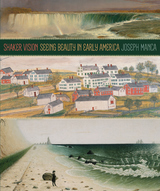 Shaker Vision: Seeing Beauty in Early America
Joseph Manca
University of Massachusetts Press, 2019 The Shakers are known for self-denial and austerity in everyday living and their material world, as embodied by the heavenly simplicity and purity of their chairs and blanket chests. Yet the believers also enjoyed a diversity of visual pleasures, from flowers, sunsets, rainbows, and the northern lights as seen at home to waterfalls, ocean waves, and dramatic cliffs viewed while traveling across America.
In Shaker Vision, Joseph Manca explores original texts, especially diaries and travel journals, and material culture to demonstrate that Shakers enjoyed a remarkably deep experience of the visual world. Shakers shared tastes with mainstream Americans and often employed a similar aesthetic vocabulary, but all within a belief system that made them distinct. In addition to their well-known ascetic architecture, furniture, and handicraft styles, they expressed themselves through ornate and detailed spiritual art and in vivid, visionary experiences. Based on firsthand accounts of the believers themselves, this richly illustrated volume will dramatically change how we assess the visual world of this uniquely American religious sect.
 Shakers at the Center: Manifesting Spirits & Spectacles in Nineteenth-Century America
Edited by Douglas L. Winiarski
University of Massachusetts Press, 2026 Exploring the theological, social, and cultural dimensions of one of America’s most ambitious prophetic movements
The Shakers’ Era of Manifestations ranks among the most astounding events in American religious history. During the 1840s, members of United Society of Believers in Christ’s Second Appearing embarked on an audacious project of producing visions, revelations, and other manifestations of the spirit world and convincing both themselves and the world’s people of their reality. In this practice, gifted Shakers surrendered their bodies to possessing spirits and celestial beings who, in turn, provided the Believers with an unimaginable number of spirit communications that collapsed time and space, rewrote the Bible, and vastly expanded traditional Protestant theology. The fruits of Shaker spiritualism would gain a permanent place in America’s public consciousness.
The New Era (or period of Mother Ann’s Work), as it came to be known, ranks among the largest outbreaks of visionary and revelatory phenomena in American history. Hundreds of volumes and thousands of pages of inspired writings, music, and art crowd the shelves of a half dozen major research libraries. The archive is so vast, so extraordinary, so seemingly bizarre that few scholars have dared tackle it in its totality. The authors of this volume, specialists in nineteenth-century American religious studies, have collaborated to produce an extensive analysis of Mother Ann’s Work. They examine a fascinating range of topics: speaking with the dead; the spectacle of Shaker rituals; race, gender, and family life; and the material culture of physical and spiritual things; as well as manuscripts, books, songs, objects, and art produced during the New Era.
Shakers at the Center is the first book to examine all the sprawling elements of the Era of Manifestations together in a single volume. Written for students, scholars, and general readers alike, it will stand for years as the definitive history of the Shakers’ most fascinating and vexing historical period.
Contributors include the volume editor as well as Emily Suzanne Clark, Brett Malcolm Grainger, Sonia Hazard, Dana Logan, Carol Medlicott, Sally M. Promey, Erik R. Seeman, Ryan K. Smith, and David Walker.
 Shakers at the Center: Manifesting Spirits & Spectacles in Nineteenth-Century America
Edited by Douglas L. Winiarski
University of Massachusetts Press, 2026 Exploring the theological, social, and cultural dimensions of one of America’s most ambitious prophetic movements
The Shakers’ Era of Manifestations ranks among the most astounding events in American religious history. During the 1840s, members of United Society of Believers in Christ’s Second Appearing embarked on an audacious project of producing visions, revelations, and other manifestations of the spirit world and convincing both themselves and the world’s people of their reality. In this practice, gifted Shakers surrendered their bodies to possessing spirits and celestial beings who, in turn, provided the Believers with an unimaginable number of spirit communications that collapsed time and space, rewrote the Bible, and vastly expanded traditional Protestant theology. The fruits of Shaker spiritualism would gain a permanent place in America’s public consciousness.
The New Era (or period of Mother Ann’s Work), as it came to be known, ranks among the largest outbreaks of visionary and revelatory phenomena in American history. Hundreds of volumes and thousands of pages of inspired writings, music, and art crowd the shelves of a half dozen major research libraries. The archive is so vast, so extraordinary, so seemingly bizarre that few scholars have dared tackle it in its totality. The authors of this volume, specialists in nineteenth-century American religious studies, have collaborated to produce an extensive analysis of Mother Ann’s Work. They examine a fascinating range of topics: speaking with the dead; the spectacle of Shaker rituals; race, gender, and family life; and the material culture of physical and spiritual things; as well as manuscripts, books, songs, objects, and art produced during the New Era.
Shakers at the Center is the first book to examine all the sprawling elements of the Era of Manifestations together in a single volume. Written for students, scholars, and general readers alike, it will stand for years as the definitive history of the Shakers’ most fascinating and vexing historical period.
Contributors include the volume editor as well as Emily Suzanne Clark, Brett Malcolm Grainger, Sonia Hazard, Dana Logan, Carol Medlicott, Sally M. Promey, Erik R. Seeman, Ryan K. Smith, and David Walker.
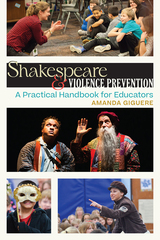 Shakespeare & Violence Prevention: A Practical Handbook for Educators
Amanda Giguere
University of Wyoming Press, 2025 Shakespeare and Violence Prevention is a handbook that guides educators through an exploration of Shakespeare’s potential to address the public health issue of youth violence. Amanda Giguere presents Shakespeare’s plays as a tool to understand, address root causes of, and prevent violence in our own communities. Performance-based engagement with the plays in an educational setting allows students to explore violence-prevention strategies, practice empathy, and build safer communities. Youth violence is an all too relevant topic, and this text helps educators, theatre companies, and academic theatre departments understand new ways in which the performing arts can positively impact young people.
Framed by examples from Giguere’s work with the Shakespeare & Violence Prevention program, an interdisciplinary outreach project for K–12 schools developed at the University of Colorado Boulder, the text offers helpful entry points, digestible research, and practical exercises to align a violence-prevention curriculum with Shakespeare’s plays. It provides a condensed overview of key findings from violence prevention, clear synopses of the plays, and practicable strategies to implement the program. Guided by firsthand experience with a tried-and-true school program that reaches thousands of K–12 students annually, Giguere shares the Colorado Shakespeare Festival method, which focuses on “upstander” roleplays to practice violence-prevention strategies. Using a clear distillation of Shakespeare studies and violence-prevention research, she shows how the two fields naturally reinforce the concepts of teamwork, empathy, change, and hope.
Shakespeare and Violence Prevention is a new spin on these classic texts that empowers teachers and community leaders to use these tools to create research-guided university engagement programs, theatre company outreach programs, and K–12 student engagement with Shakespeare, even for those without expertise in violence prevention or Shakespeare.
 Shakespeare and Abraham
Ken Jackson
University of Notre Dame Press, 2015 In Shakespeare and Abraham, Ken Jackson illuminates William Shakespeare’s dramatic fascination with the story of Abraham’s near sacrifice of his son Isaac in Genesis 22. Themes of child killing fill Shakespeare’s early plays: Genesis 22 informed Clifford’s attack on young Rutland in 3 Henry 6, Hubert’s providentially thwarted murder of Arthur in King John, and Aaron the Moor’s surprising decision to spare his son amidst the filial slaughters of Titus Andronicus, among others.
However, the playwright’s full engagement with the biblical narrative does not manifest itself exclusively in scenes involving the sacrifice of children or in verbal borrowings from the famously sparse story of Abraham. Jackson argues that the most important influence of Genesis 22 and its interpretive tradition is to be found in the conceptual framework that Shakespeare develops to explore relationships among ideas of religion, sovereignty, law, and justice. Jackson probes the Shakespearean texts from the vantage of modern theology and critical theory, while also orienting them toward the traditions concerning Abraham in Jewish, Pauline, patristic, medieval, and Reformation sources and early English drama. Consequently, the playwright’s “Abrahamic explorations” become strikingly apparent in unexpected places such as the “trial” of Shylock in The Merchant of Venice and the bifurcated structure of Timon of Athens.
By situating Shakespeare in a complex genealogy that extends from ancient religion to postmodern philosophy, Jackson inserts Shakespeare into the larger contemporary conversation about religion in the modern world.
"Ken Jackson's Shakespeare and Abraham poses a powerful model for how a biblical hero can be recovered within a number of divergent dramatic contexts—both Shakespearean and medieval—as well as in philosophy and theology. Writing with great clarity about challenging ideas, Jackson has led us a great deal closer to understanding the meanings that the binding of Isaac held for Shakespeare." —Julia Reinhard Lupton, University of California, Irvine
"Ken Jackson’s powerfully argued book challenges us to rethink what religion may have meant to Shakespeare and what it may yet come to mean for us. Neither secular nor orthodox, neither skeptical nor pious, Jackson’s Shakespeare is nevertheless a passionately committed playwright deeply aware of the inescapably religious dimensions of everyday life. Through a series of startling readings, Jackson shows Shakespeare bearing witness to a desire for pure generosity that quickens even as it unsettles the three great monotheisms. Shakespeare and Abraham is high-stakes criticism sure to provoke." —Gary Kuchar, University of Victoria
“Ken Jackson’s timely book makes a forceful case for attending to Shakespeare’s engagement with the Abrahamic roots of monotheism as a way of looking anew at some of the most perplexing moments in the plays. Reevaluating the playwright’s attitude toward religion without getting bogged down in debates over doctrinal commitments, Jackson gives us a Shakespeare deeply invested in religious questions, if not religious controversy. Moving effortlessly among theological, literary, and philosophical works from antiquity to the present, Jackson reveals that Shakespeare’s response to Abraham raises urgent questions about the intersections of religion and culture in early modern England that are no less relevant today.” —James A. Knapp, Edward Surtz, S.J., Professor of English, Loyola University Chicago
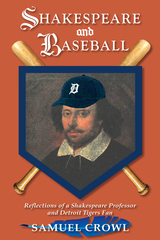 Shakespeare and Baseball: Reflections of a Shakespeare Professor and Detroit Tigers Fan
Samuel Crowl
Ohio University Press, 2024 Shakespeare and baseball are monuments of high and popular culture: Shakespeare is the most widely read and staged playwright in the world, and baseball is America’s game. Professor Samuel Crowl, a prize-winning teacher and international scholar of Shakespeare on film, explores his life as a champion of the Bard and a fan of the Detroit Tigers. He saw his first Tigers game in the summer of 1950 (Hal Newhouser beat the Chicago White Sox) and his first Shakespeare play in 1953 (Alec Guinness as Richard III at Ontario’s Stratford Festival) and has spent almost seventy-five years enjoying and writing about the pleasures of play that each provides. Shakespeare and Baseball is an unusual hybrid combining Crowl’s education as a Shakespeare and baseball fan, the resonances he perceives between the playwright and the game, the unexpected pleasures both forms of play have afforded his extended family of children and grandchildren, and a selection from the seventy letters he has written to them about Tigers games he has seen, from old Tiger Stadium, Fenway Park, Yankee Stadium, and ballparks in Cleveland. Crowl finds unexpected connections between his twin subjects, including beer, which funded and fueled both the establishment of Major League baseball clubs, like the Yankees and Cardinals, and the creation of the Shakespeare Memorial Theatre in Stratford-upon-Avon, the home of the Royal Shakespeare Company, visited by Shakespeare enthusiasts from around the world. A deeper linkage is that Shakespeare’s festive comedies kept the ideas, rituals, and customs of rural England alive in the dense urban world of Elizabethan London, just as baseball kept the image of the garden—the rural American past in which the game took shape—alive in the twentieth-century American city. The book is written in a style that captures what one reader has called Crowl’s “warm, rich midwestern voice” and will be of interest to fans of the game and of the Bard, from high schoolers on up.
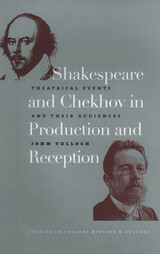 Shakespeare and Chekhov in Production and Reception: Theatrical Events and Their Audiences
Tulloch, John
University of Iowa Press, 2005 With a focus on the canonical institutions of Shakespeare and Chekhov, John Tulloch brings together for the first time new concepts of “the theatrical event” with live audience analysis. Using mainstream theatre productions from across the globe that were highly successful according to both critics and audiences, this book of case studies—ethnographies of production and reception—offers a combined cultural and media studies approach to analyzing theatre history, production, and audience. Tulloch positions these concepts and methodologies within a broader current theatrical debate between postmodernity and risk modernity. He also describes the continuing history of Shakespeare and Chekhov as a series of stories “currently and locally told” in the context of a blurring of academic genres that frames the two writers. Drawn from research conducted over nearly a decade in Australia, Britain, and the U.S., Shakespeare and Chekhov in Production and Reception will be of interest to students and scholars of theatre studies, media studies, and audience research.
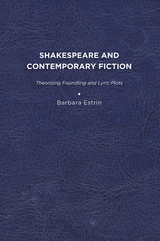 Shakespeare and Contemporary Fiction: Theorizing Foundling and Lyric Plots
Barbara L. Estrin
University of Delaware Press, 2012 In the first book to use fiction as theory, Barbara L. Estrin reverses chronological direction, beginning with contemporary novels to arrive at a re-visioned Shakespeare, uncovering a telling difference in the stories that script us and that influence our political unconscious in ways that have never been explored in literary-critical interpretations. Describing the animus against foreign blood, central to the dynamic of the foundling and lyric plots that form the nexus of her study, Estrin describes how late modern writers change those plots. Reading backward through the theoretical lens of their revisions allows us to rethink the Shakespeare we thought we knew. That innovative methodology, in turn, encourages us to read forward again with different tellings, ones that challenge the mythological homogeneity of the traditional classifications and that suggest new formulaic paradigms. With close readings of four contemporary novels and three Shakespeare plays, Estrin identifies the cultural walls that contribute to political gate-keeping as she chronicles the connection between plot variations and gender revisionism in the work of Caryl Phillips, Liz Jensen, Anne Michaels, and W.G. Sebald, as well as two film-makers (Mona Hatoum and Mieke Bal) who demonstrate an understanding that mythical repercussions prove dangerous in the twentieth and twenty-first centuries even as they suggest how the heritage shaping their work, and to which they are themselves drawn, in turn proposes an alternative Shakespeare, one who frees us to ask other questions: At the time that the nation state was beginning to coalesce, what does Shakespeare’s frequent use of the foundling plot and his significant variations portend? How does his infusion of a revised lyric dynamic in The Merchant of Venice, Othello and The Winter’s Tale change our reading of plays where the two plots coalesce as they do in the contemporary novels that shape Estrin’s late modern interpretations? All the works in this study share the underlying premise that the connection between cultural origins and political destinies is reciprocal and that it is necessary and possible to transform the constructs—in memory and imagination—that continue to shape our lives.
Published by University of Delaware Press. Distributed worldwide by Rutgers University Press.
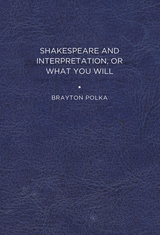 Shakespeare and Interpretation, or What You Will
Brayton Polka
University of Delaware Press, 2011 Brayton Polka takes both a textual and theoretical approach to seven plays of Shakespeare: Macbeth, Othello, Twelfth Night, All’s Well That Ends Well, Julius Caesar, Troilus and Cressida, and Hamlet. He calls upon the Bible and the ideas of major European thinkers, above all, Kierkegaard and Spinoza, to argue that the concept of interpretation that underlies both Shakespeare’s plays and our own lives as moderns is the golden rule of the Bible: the command to love your neighbor as yourself. What you will (the alternative title of Twelfth Night ) thus captures the idea that interpretation is the very act by which we constitute our lives. For it is only in willing what others will—in loving relationships—that we enact a concept of interpretation that is adequate to our lives. Polka argues that it is the aim of Shakespeare, when representing the ancient world in plays like Julius Caesar and Troilus and Cressida, and also in his long narrative poem “The Rape of Lucrece,” to dramatize the fundamental differences between ancient (pagan) values and modern (biblical) values or between what he articulates as contradiction and paradox. The ancients are fatally destroyed by the contradictions of their lives of which they remain ignorant. In contrast, we moderns in the biblical tradition, like those who figure in Shakespeare’s other works, are responsible for addressing and overcoming the contradictions of our lives through living the interpretive paradox of “what you will,” of treating all human beings as our neighbor. Shakespeare’s comedies and tragedies, notwithstanding their dramatically different form, share this interpretive framework of paradox. As the author shows in his book, texts without interpretation are blind and interpretation without texts is empty.
Published by University of Delaware Press. Distributed worldwide by Rutgers University Press.
Shakespeare and Superheroes
Jeffrey Kahan
Arc Humanities Press, 2018 This short book offers a series of thought experiments and invites Shakespeareans to rediscover the wonders and pleasures of fandom. It does not argue that comic books and movies can or should replace Shakespeare; the goal is to explore the values in both, to think of comics as allusively Shakespearean, telling similar stories, expressing similar concerns, exploring similar values. Shakespeare and Superheroes seeks to re-democratize criticism by encouraging all readers to engage in and to respond to literary arguments using their own common cultural language.
Shakespeare and the Audience: A Study in the Technique of Exposition
Arthur C. Sprague
Harvard University Press With the best will in the world, the playwright is forbidden to take a short cut and address us in person, and he must also face certain disadvantages inherent in his prescribed method of imparting information by word of mouth. Shakespeare had to reckon, still further, with the special conditions of his own theatre: the lack of programmes, of scenery, and of artificial lighting. Yet in spite of all these hindrances, he is able to make us enter into the lives of his characters and to see not only their point of view but his own as well. How he turns the trick is of immediate interest to everyone who sees the plays produced in the theatre or reflects upon them in terms of the theatre rather than of the closet. Such is Dr Sprague’s point of departure for a fresh survey of Shakespeare as vital and stimulating as anything that has been written in its field for these many years.
Shakespeare and the Denial of Death
James Calderwood
University of Massachusetts Press, 1987 James L. Calderwood offers a lively exploration of the ways in which Shakespeare dramatizes the strategies people employ to deal with and transcend the inevitability of death. In keeping with the views of Ernest Becker, Norman O. Brown, and others, Calderwood argues that the denial of death is fundamental to both individuals and their cultures. By drawing on a fascinating range of examples, he suggests how often and how variously Shakespeare dramatizes this desire for symbolic immortality.
Shakespeare and the French Poet
Yves Bonnefoy
University of Chicago Press, 2004 A meditation on the major plays of Shakespeare and the thorny art of literary translation, Shakespeare and the French Poet contains twelve essays from France's most esteemed critic and preeminent living poet, Yves Bonnefoy. Offering observations on Shakespeare's response to the spiritual crisis of his era as well as compelling insights on the practical and theoretical challenges of verse in translation, Bonnefoy delivers thoughtful, evocative essays penned in his characteristically powerful prose.
Translated specifically for an American readership, Shakespeare and the French Poet also features a new interview with Bonnefoy. For Shakespeare scholars, Bonnefoy enthusiasts, and students of literary translation, Shakespeare and the French Poet is a celebration of the global language of poetry and the art of "making someone else's voice live again in one's own."
 Shakespeare and the Hazards of Ambition
Robert N. Watson
Harvard University Press, 1984 What is ambition, and what are its consequences, in Shakespearean drama? This compelling interpretation of eight major plays reveals a Shakespeare who understands ambition as a doomed but necessary struggle against the limitations of the inherited self. Through vivid new readings of such crucial moments as Henry V's rejection of Falstaff, Macbeth's defeat by the advancing Birnam Wood, and Coriolanus' crisis at the gates of Rome, Robert Watson delineates a pattern of poetic justice whereby characters who disdain their places in nature's system forfeit the benefits that nature normally offers. Watson also amends the insights of psychoanalytic critics by demonstrating that Shakespeare uses Oedipal impulses and unnatural births as metaphors for the forbidden act of remaking the self: conceiving a new identity entails a symbolically incestuous defiance of the father's authority.
By tracing the evolution of this Shakespearean myth of ambition and exploring its analogues in many less familiar Renaissance texts, Watson illuminates the ethical perspective of the playwright and provides a bold new approach to the sexual symbolism of the plays. The persistence of the mythic pattern across different types of play (history, tragedy, and romance) and different modes of aspiration (political, martial, and spiritual) indicates that Shakespeare perceives ambition as a moral and dramatic problem in its own right, with its own special properties and its own weighty ambiguities.
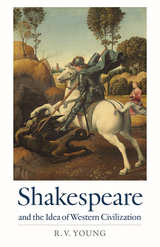 Shakespeare and the Idea of Western Civilization
R.V. Young
Catholic University of America Press, 2022 William Shakespeare is widely regarded as one of the greatest writers of the Western world and most certainly its greatest playwright. His actual relationship to Western civilization has not, however, been thoroughly investigated. At a time when that civilization, as well as its premier dramatist, is subjected to severe and increasing criticism for both its supposed crimes against the rest of the world and its fundamental principles, a reassessment of the culture of the West is overdue.
Shakespeare and the Idea of Western Civilization offers an unprecedented account of how the playwright draws upon his civilization's unique culture and illuminates its basic features. Rather than a treatment of all the works, R.V. Young focuses on how some of Shakespeare's best and most well-known plays dramatize the West's conception of social institutions and historical developments such as love and marriage, ethnic and racial prejudice, political order, colonialism, and religion. Shakespeare and the Idea of Western Civilization provides a spirited defense of the West and its greatest poet at a time when both are the object of virulent academic and political hostility.
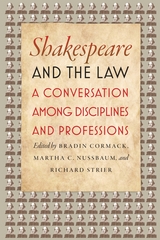 Shakespeare and the Law: A Conversation among Disciplines and Professions
Edited by Bradin Cormack, Martha C. Nussbaum, and Richard Strier
University of Chicago Press, 2013 William Shakespeare is inextricably linked with the law. Legal documents make up most of the records we have of his life, and trials, lawsuits, and legal terms permeate his plays. Gathering an extraordinary team of literary and legal scholars, philosophers, and even sitting judges, Shakespeare and the Law demonstrates that Shakespeare’s thinking about legal concepts and legal practice points to a deep and sometimes vexed engagement with the law’s technical workings, its underlying premises, and its social effects.
The book’s opening essays offer perspectives on law and literature that emphasize both the continuities and contrasts between the two fields. The second section considers Shakespeare’s awareness of common law thinking and common law practice, while the third inquires into Shakespeare’s general attitudes toward legal systems. The fourth part of the book looks at how law enters into conversation with issues of politics and community, whether in the plays, in Shakespeare’s world, or in our own world. Finally, a colloquy among Supreme Court Justice Stephen Breyer, Judge Richard Posner, Martha C. Nussbaum, and Richard Strier covers everything from the ghost in Hamlet to the nature of judicial discretion.
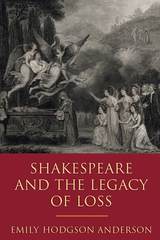 Shakespeare and the Legacy of Loss
Emily Hodgson Anderson
University of Michigan Press, 2018 How do we recapture, or hold on to, the live performances we most love, and the talented artists and performers we most revere? Shakespeare and the Legacy of Loss tells the story of how 18th-century actors, novelists, and artists, key among them David Garrick, struggled with these questions through their reenactments of Shakespearean plays. For these artists, the resurgence of Shakespeare, a playwright whose works just decades earlier had nearly been erased, represented their own chance for eternal life. Despite the ephemeral nature of performance, Garrick and company would find a way to make Shakespeare, and through him the actor, rise again. In chapters featuring Othello, Richard III, Hamlet, The Winter’s Tale, and The Merchant of Venice, Emily Hodgson Anderson illuminates how Garrick’s performances of Shakespeare came to offer his contemporaries an alternative and even an antidote to the commemoration associated with the monument, the portrait, and the printed text. The first account to read 18th-century visual and textual references to Shakespeare alongside the performance history of his plays, this innovative study sheds new light on how we experience performance, and why we gravitate toward an art, and artists, we know will disappear.
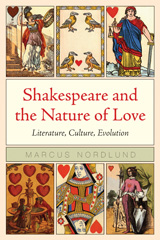 Shakespeare and the Nature of Love: Literature, Culture, Evolution
Marcus Nordlund
Northwestern University Press, 2007 The best conception of love, Marcus Nordlund contends, and hence the best framework for its literary analysis, must be a fusion of evolutionary, cultural, and historical explanation. It is within just such a bio-cultural nexus that Nordlund explores Shakespeare’s treatment of different forms of love. His approach leads to a valuable new perspective on Shakespearean love and, more broadly, on the interaction between our common humanity and our historical contingency as they are reflected, recast, transformed, or even suppressed in literary works.
After addressing critical issues about love, biology, and culture raised by his method, Nordlund considers four specific forms of love in seven of Shakespeare’s plays. Examining the vicissitudes of parental love in Titus Andronicus and Coriolanus, he argues that Shakespeare makes a sustained inquiry into the impact of culture and society upon the natural human affections. King Lear offers insight into the conflicted relationship between love and duty. In two problem plays about romantic love, Troilus and Cressida and All’s Well that Ends Well, the tension between individual idiosyncrasies and social consensus becomes especially salient. And finally, in Othello and The Winter’s Tale, Nordlund asks what Shakespeare can tell us about the dark avatar of jealousy.
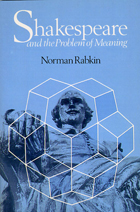 Shakespeare and the Problem of Meaning
Norman Rabkin
University of Chicago Press, 1981 "Rabkin selects The Merchant of Venice, Henry V, Antony and Cleopatra, Julius Caesar, Richard III, Macbeth, Coriolanus, The Winter's Tale, and The Tempest as the plays on which to build his argument, and he teaches us a great deal about these plays. . . . To convince the unbelievingthat that the plays do mean, but that the meaning is coterminous with the experience of the plays themselves, Rabkin finds a strategy more subtle than thesis and rational argument, a strategy designed to make us see for ourselves why thematic descriptions are inadequate, see for ourselves tath the plays mean more than and statement about them can ever suggest." –Barbara A. Mowat, Auburn University
"Norman Rabkin's new book is a very different kind of good book. Elegantly spare, sharp, undogmatic. . . . The relationship between the perception of unity and the perception of artistic achievement is a basic conundrum, and it is one that Mr. Rabkin has courageously placed at the center of his discussion." –G. K. Hunter, Sewanee Review
"Rabkin's book is brilliant, taut, concise, beautifully argued, and sensitively responsive to the individuality of particular Shakespeare plays." –Anne Barton, New York Review of Books
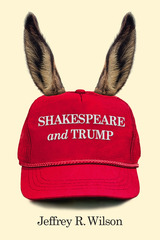 Shakespeare and Trump
Jeffrey R. Wilson
Temple University Press, 2020 Should we draw an analogy between Shakespeare’s tyrants—Richard III, Julius Caesar, Macbeth, and King Lear—and Donald Trump? In Shakespeare and Trump, Jeffrey Wilson applies literary criticism to real life, examining plot, character, villainy, soliloquy, tragedy, myth, and metaphor to identify the formal features of the Trump phenomenon, and its hidden causes, structure, and meanings. Wilsonapproaches his comparison prismatically. He first considers two high-concept (read: far-fetched) Shakespeare adaptations penned by Trump’s former chief political strategist Steve Bannon. He looks at University of Pennsylvania students protesting Trump by taking down a monument to Shakespeare. He reads Trump’s first 100 days in office against Netflix’s House of Cards. Wilson also addresses the summer 2017 Shakespeare in the Park production of Julius Caesar wherein an assassination of a Trump-ian leader caused corporations to withdraw sponsorship. These stories reveal a surprising—and bizarre—relationship between the provincial English playwright and the billionaire President of the United States, ostensibly a medieval king living in a modern world. The comparison reveals a politics that blends villainy and comedy en route to tragedy.
Shakespeare: Aspects of Influence
G. B. Evans
Harvard University Press, 1976 The ten essays in this volume are devoted to various manifestations of Shakespeare’s influence, on individual writers and on the popular consciousness, from the early seventeenth century to the present. A few facets of that influence are highlighted, without any attempt at a systematic or chronological survey. The contributors are Morton Bloomfield, Douglas Bush, Paul Cantor, Paul D’Andrea, Alfred Harbage, David Hirsch, Cyrus Hoy, Murray Krieger, Arthur Sherbo, and Hallett Smith.
Shakespeare at the Cineplex: The Kenneth Branagh Era
Samuel Crowl
Ohio University Press, 2005 Samuel Crowl’s Shakespeare at the Cineplex: The Kenneth Branagh Era is the first thorough exploration of the fifteen major Shakespeare films released since the surprising success of Kenneth Branagh’s Henry V (1989). Crowl presents the rich variety of these films in the “long decade: between the fall of the Berlin Wall and the terrorist attacks on September 11, 2001.” The productions range from Hollywood-saturated films such as Franco Zeffirelli’s Hamlet and Michael Hoffman’s A Midsummer Night’s Dream to more modest, experimental offerings, such as Christine Edzard’s As You Like It. Now available in paperback, Shakespeare at the Cineplex will be welcome reading for fans, students, and scholars of Shakespeare in performance.
Shakespeare Behind Bars: One Teacher's Story of the Power of Drama in a Women's Prison
Jean Trounstine
University of Michigan Press, 2004 In this deeply stirring account, Jean Trounstine, who spent 10 years teaching at Framingham (MA) Women's Prison, focuses on six inmates who, each in her own way, discover in the power of Shakespeare a way to transcend the painful constraints of incarceration. Shakespeare Behind Bars is a powerful story about the redemptive power of art and education.
Originally published in cloth in 2001, the paperback includes a new foreword that will inspire all teachers who work with students others have deemed unteachable. A new afterword updates readers on the prison art's program -- and the author herself -- since 2001.
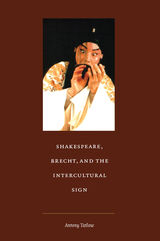 Shakespeare, Brecht, and the Intercultural Sign
Antony Tatlow
Duke University Press, 2001 In Shakespeare, Brecht, and the Intercultural Sign renowned Brecht scholar Antony Tatlow uses drama to investigate cultural crossings and to show how intercultural readings or performances question the settled assumptions we bring to interpretations of familiar texts. Through a “textual anthropology” Tatlow examines the interplay between interpretations of Shakespeare and readings of Brecht, whose work he rereads in the light of theories of the social subject from Nietzsche to Derrida and in relation to East Asian culture, as well as practices within Chinese and Japanese theater that shape their versions of Shakespearean drama.
Reflecting on how, why, and to what effect knowledges and styles of performance pollinate across cultures, Tatlow demonstrates that the employment of one culture’s material in the context of another defamiliarizes the conventions of representation in an act that facilitates access to what previously had been culturally repressed. By reading the intercultural, Tatlow shows, we are able not only to historicize the effects of those repressions that create a social unconscious but also gain access to what might otherwise have remained invisible.
This remarkable study will interest students of cultural interaction and aesthetics, as well as readers interested in theater, Shakespeare, Brecht, China, and Japan.
Shakespeare Dwelling: Designs for the Theater of Life
Julia Reinhard Lupton
University of Chicago Press, 2018 Great halls and hovels, dove-houses and sheepcotes, mountain cells and seaside shelters—these are some of the spaces in which Shakespearean characters gather to dwell, and to test their connections with one another and their worlds. Julia Reinhard Lupton enters Shakespeare’s dwelling places in search of insights into the most fundamental human problems.
Focusing on five works (Romeo and Juliet, Macbeth, Pericles, Cymbeline, and The Winter’s Tale), Lupton remakes the concept of dwelling by drawing on a variety of sources, including modern design theory, Renaissance treatises on husbandry and housekeeping, and the philosophies of Hannah Arendt and Martin Heidegger. The resulting synthesis not only offers a new entry point into the contemporary study of environments; it also shows how Shakespeare’s works help us continue to make sense of our primal creaturely need for shelter.
 Shakespeare, Einstein, and the Bottom Line: The Marketing of Higher Education
David L. Kirp
Harvard University Press, 2003 How can you turn an English department into a revenue center? How do you grade students if they are "customers" you must please? How do you keep industry from dictating a university's research agenda? What happens when the life of the mind meets the bottom line? Wry and insightful, Shakespeare, Einstein, and the Bottom Line takes us on a cross-country tour of the most powerful trend in academic life today--the rise of business values and the belief that efficiency, immediate practical usefulness, and marketplace triumph are the best measures of a university's success.
With a shrewd eye for the telling example, David Kirp relates stories of marketing incursions into places as diverse as New York University's philosophy department and the University of Virginia's business school, the high-minded University of Chicago and for-profit DeVry University. He describes how universities "brand" themselves for greater appeal in the competition for top students; how academic super-stars are wooed at outsized salaries to boost an institution's visibility and prestige; how taxpayer-supported academic research gets turned into profitable patents and ideas get sold to the highest bidder; and how the liberal arts shrink under the pressure to be self-supporting.
Far from doctrinaire, Kirp believes there's a place for the market--but the market must be kept in its place. While skewering Philistinism, he admires the entrepreneurial energy that has invigorated academe's dreary precincts. And finally, he issues a challenge to those who decry the ascent of market values: given the plight of higher education, what is the alternative?
Shakespeare from the Margins: Language, Culture, Context
Patricia Parker
University of Chicago Press, 1996 In the interpretation of Shakespeare, wordplay has often been considered inconsequential, frequently reduced to a decorative "quibble." But in Shakespeare from the Margins: Language, Culture, Context, Patricia Parker, one of the most original interpreters of Shakespeare, argues that attention to Shakespearean wordplay reveals unexpected linkages, not only within and between plays but also between the plays and their contemporary culture.
Combining feminist and historical approaches with attention to the "matter" of language as well as of race and gender, Parker's brilliant "edification from the margins" illuminates much that has been overlooked, both in Shakespeare and in early modern culture. This book, a reexamination of popular and less familiar texts, will be indispensable to all students of Shakespeare and the early modern period.
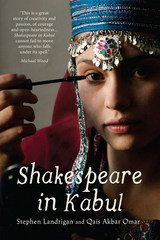 Shakespeare in Kabul
Stephen Landrigan and Qais Akbar Omar
Haus Publishing, 2012 In 2005, a group of actors in Kabul performed Shakespeare's Love’s Labour's Lost to the cheers of Afghan audiences and the raves of foreign journalists. For the first time in years, men and women had appeared onstage together. The future held no limits, the actors believed. In this fast-moving, fondly told and frequently very funny account, Qais Akbar Omar and Stephen Landrigan capture the triumphs and foibles of the actors as they extend their Afghan passion for poetry to Shakespeare's.Both authors were part of the production. Qais, a journalist, served as Assistant Director and interpreter for Paris actress, Corinne Jaber, who had come to Afghanistan on holiday and returned to direct the play. Stephen, himself a playwright, assembled a team of Afghan translators to fashion a script in Dari as poetic as Shakespeare's. This chronicle of optimism plays out against the heartbreak of knowing that things in Afghanistan have not turned out the way the actors expected.
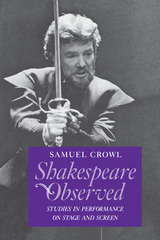 Shakespeare Observed: Studies in Performance on Stage and Screen
Samuel Crowl
Ohio University Press, 1993 In this lively study of both modern film and stage productions of Shakespeare, Samuel Crowl provides fascinating insights into the ways in which these productions have been influenced by one another as well as by contemporary developments in critical approaches to Shakespeare's plays.
Crowl’s study demonstrates the surprising resonances between Roman Polanski's 1971 film of Macbeth and Adrian Noble's heralded recent production of the play for The Royal Shakespeare Company; argues that Orson Welles's films of Othello and Cabins at Midnight are not only brilliant remaining of Shakespeare in another art form but make a powerful contribution to our contemporary understanding of performance as interpretation; and chronicles the impact of Peter Hall's creation of the Royal Shakespeare Company in 1960 on performance approaches to Shakespeare in the past thirty years.
Shakespeare Observed provides full interpretative readings of key recent Shakespeare productions in England and includes an intimate behind-the-scenes glimpse into the rehearsal process which produced Ron Daniels's emotionally charged version of Romeo and Juliet for the RSC in 1980. The final chapter uses Kenneth Branagh's highly successful film of Henry V as a summary example of the trends and influences Crowl's study traces, seeing the film as gathering its interpretative energies from both Olivier's famous film version of the play and Adrian Noble's stage production featuring Branagh as the king.
Written in a style which places a premium on capturing the vivid and often dazzling moments of stage and film performances of Shakespeare, Crowl's study will be of interest to the avid film and theatergoer as well as to the scholar and student. Shakespeare Observed joins a growing list of recent critical works which have significantly expanded and redefined the boundaries of Shakespeare studies in our time.
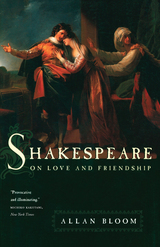 Shakespeare on Love and Friendship
Allan Bloom
University of Chicago Press, 2000 "No one can make us love love as much as Shakespeare, and no one can make us despair of it as effectively as he does." William Shakespeare is the only classical author to remain widely popular—not only in America but throughout the world—and Allan Bloom argues that this is because no other writer holds up a truer mirror to human nature. Unlike the Romantics and other moderns, Shakespeare has no project for the betterment or salvation of mankind—his poetry simply gives us eyes to see what is there. In particular, we see the full variety of erotic connections, from the "star-crossed" devotions of Romeo and Juliet to the failed romance of Troilus and Cressida to the problematic friendship of Falstaff and Hal.
This volume includes essays on five plays, Romeo and Juliet, Anthony and Cleopatra, Measure for Measure, Troilus and Cressida, and The Winter's Tale, and within these Bloom meditates on Shakespeare's work as a whole. He also draws on his formidable knowledge of Plato, Rousseau, and others to bring both ancients and moderns into the conversation. The result is a truly synoptic treatment of eros—not only a philosophical reflection on Shakespeare, but a survey of the human spirit and its tendency to seek what Bloom calls the "connectedness" of love and friendship.
These highly original interpretations of the plays convey a deep respect for their author and a deep conviction that we still have much to learn from him. In Bloom's view, we live in a love-impoverished age; he asks us to turn once more to Shakespeare because the playwright gives us a rich version of what is permanent in human nature without sharing our contemporary assumptions about erotic love.
"Provocative and illuminating." —Michiko Kakutani, New York Times
"A brilliant analysis of the erotic ugliness and the balancing erotic grace of The Winter's Tale . . . and Bloom makes more sense of [Measure for Measure] than anyone else I have read." —A. S. Byatt, Washington Post Book World
At his death in 1992, Allan Bloom was the John U. Nef Distinguished Service Professor in the Committee on Social Thought at the University of Chicago. He is the author of several books, including Shakespeare's Politics (with Harry V. Jaffa) and The Closing of the American Mind.
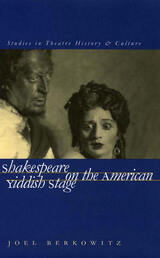 Shakespeare on the American Yiddish Stage
Joel Berkowitz
University of Iowa Press, 2002 The professional Yiddish theatre started in 1876 in Eastern Europe; with the assassination of Tsar Alexander II in 1881, masses of Eastern European Jews began moving westward, and New York—Manhattan’s Bowery and Second Avenue—soon became the world’s center of Yiddish theatre. At first the Yiddish repertoire revolved around comedies, operettas, and melodramas, but by the early 1890s America's Yiddish actors were wild about Shakespeare. In Shakespeare on the American Yiddish Stage, Joel Berkowitz knowledgeably and intelligently constructs the history of this unique theatrical culture. The Jewish King Lear of 1892 was a sensation. The year 1893 saw the beginning of a bevy of Yiddish versions of Hamlet; that year also saw the first Yiddish production of Othello. Romeo and Juliet inspired a wide variety of treatments. The Merchant of Venice was the first Shakespeare play published in Yiddish, and Jacob Adler received rave reviews as Shylock on Broadway in both 1903 and 1905. Berkowitz focuses on these five plays in his five chapters. His introduction provides an orientation to the Yiddish theatre district in New York as well as the larger picture of Shakespearean production and the American theatre scene, and his conclusion summarizes the significance of Shakespeare’s plays in Yiddish culture.
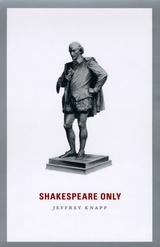 Shakespeare Only
Jeffrey Knapp
University of Chicago Press, 2009 Three decades of controversy in Shakespeare studies can be summed up in a single question: Was Shakespeare one of a kind? On one side of the debate are the Shakespeare lovers, the bardolatrists, who insist on Shakespeare’s timeless preeminence as an author. On the other side are the theater historians who view modern claims of Shakespeare’s uniqueness as a distortion of his real professional life. In Shakespeare Only, Knapp draws on an extraordinary array of historical evidence to reconstruct Shakespeare’s authorial identity as Shakespeare and his contemporaries actually understood it. He argues that Shakespeare tried to adapt his own singular talent and ambition to the collaborative enterprise of drama by imagining himself as uniquely embodying the diverse, fractious energies of the popular theater. Rewriting our current histories of authorship as well as Renaissance drama, Shakespeare Only recaptures a sense of the creative force that mass entertainment exerted on Shakespeare and that Shakespeare exerted on mass entertainment.
 Shakespeare the Actor and the Purposes of Playing
Meredith Anne Skura
University of Chicago Press, 1993 For the Renaissance, all the world may have been a stage and all its people players, but Shakespeare was also an actor on the literal stage. Meredith Anne Skura asks what it meant to be an actor in Shakespeare's England and shows why a knowledge of actual theatrical practices is essential for understanding both Shakespeare's plays and the theatricality of everyday life in early modern England.
Despite the obvious differences between our theater and Shakespeare's, sixteenth-century testimony suggests that the experience of acting has not changed much over the centuries. Beginning with a psychoanalytically informed account of acting today, Skura shows how this intense and ambivalent experience appears not only in literal references to acting in Shakespearean drama but also in recurring narrative concerns, details of language, and dramatic strategies used to engage the audience. Looking at the plays in the context of both public and private worlds outside the theater, Skura rereads the canon to identify new configurations in the plays and new ways of understanding theatrical self-consciousness in Renaissance England. Rich in theatrical, psychoanalytic, biographical, and historical insight, this book will be invaluable to students of Shakespeare and instructive to all readers interested in the dynamics of performance.
 Shakespeare the Illusionist: Magic, Dreams, and the Supernatural on Film
Neil Forsyth
Ohio University Press, 2019 In Shakespeare the Illusionist, Neil Forsyth reviews the history of Shakespeare’s plays on film, using the basic distinction in film tradition between what is owed to Méliès and what to the Lumière brothers. He then tightens his focus on those plays that include some explicit magical or supernatural elements—Puck and the fairies, ghosts and witches, or Prospero’s island, for example—and sets out methodically, but with an easy touch, to review all the films that have adapted those comedies and dramas, into the present day. Forsyth’s aim is not to offer yet another answer as to whether Shakespeare would have written for the screen if he were alive today, but rather to assess what various filmmakers and TV directors have in fact made of the spells, haunts, and apparitions in his plays. From analyzing early camera tricks to assessing contemporary handling of the supernatural, Forsyth reads Shakespeare films for how they use the techniques of moviemaking to address questions of illusion and dramatic influence. In doing so, he presents a bold step forward in Shakespeare and film studies, and his fresh take is presented in lively, accessible language that makes the book ideal for classroom use.
Shakespeare Valued: Education Policy and Pedagogy 1989-2009
Sarah Olive
Intellect Books, 2015 Taking a comprehensive critical and theoretical approach to the role of Shakespeare in educational policy and pedagogy from 1989—the year compulsory Shakespeare was introduced under the National Curriculum for English in the United Kingdom—to the present, Shakespeare Valued explores the esteem afforded Shakespeare in the British educational system and its evolution throughout the twentieth and twenty-first centuries. Sarah Olive offers an unparalleled analysis of the ways in which Shakespeare is valued in a range of educational domains in England, and the resulting book will be essential reading for students and teachers of English and Shakespeare.
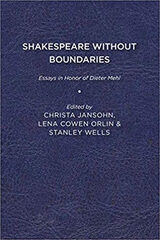 Shakespeare without Boundaries: Essays in Honor of Dieter Mehl
Christa Jansohn
University of Delaware Press, 2011 Shakespeare without Boundaries: Essays in Honor of Dieter Mehl offers a wide-ranging collection of essays written by an international team of distinguished scholars who attempt to define, to challenge, and to erode boundaries that currently inhibit understanding of Shakespeare, and to exemplify how approaches that defy traditional bounds of study and criticism may enhance understanding and enjoyment of a dramatist who acknowledged no boundaries in art. The Volume is published in tribute to Professor Dieter Mehl, whose critical and scholarly work on authors from Chaucer through Shakespeare to D. H. Lawrence has transcended temporal and national boundaries in its range and scope, and who, as Ann Jennalie Cook writes, has contributed significantly to the erasure of political boundaries that have endangered the unity of German literary scholarship and, more broadly, through his work for the International Shakespeare Association, to the globalization of Shakespeare studies. Published by University of Delaware Press. Distributed worldwide by Rutgers University Press.
 Shakespeare without Words and Other Essays
Alfred Harbage
Harvard University Press, 1972 In the title essay of this volume, Harbage admonishes the critics and directors whose modern--and often perverse--presentations of Shakespeare attempt to locate him in the theatre of the absurd. According to the author, such critics are using the actions of the plays but ignoring the words; his concern is that the plays be read and responded to as whole works of art.
Thus the groundwork is laid for this outstanding collection of essays and lectures--most of them previously presented in various publications over the past two or three decades and all characterized by Harbage's urbanity, wit, and good sense. Devoted to the debate of critical issues involving Shakespeare and his fellow dramatists, the first eight essays, described by the author as "pleas for sanity," include such pieces as "Marlowe Disinterred," prompted by a book nominating Marlowe as the author of Shakespeare's plays; "Cosmic Card Game," a parody of the New Criticism; and "Shakespeare and the Professions," where one section details Shakespeare's opinion of the various professions as they are represented by characters in the plays--parsons, teachers, lawyers, and doctors.
The last part of the book is composed of four essays relating to the history of the Elizabethan drama and raising provocative questions of chronology and authorship. These articles likewise deal with structural problems and suggest new directions for research.
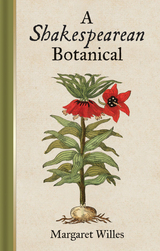 A Shakespearean Botanical
Margaret Willes
Bodleian Library Publishing, 2015 When Falstaff calls upon the sky to rain potatoes in The Merry Wives of Windsor, he highlights the belief that the exotic vegetable, recently introduced to England from the Americas, was an aphrodisiac. In Romeo and Juliet, Lady Capulet calls for quinces to make pies for the marriage feast, knowing that the fragrant fruit was connected with weddings and fertility. Shakespeare’s contemporaries would have been familiar with such ripe symbolism in part due to herbals, tomes filled with detailed botanical descriptions consulted to deepen knowledge of the plants of the day.
A Shakespearean Botanical follows in the tradition of the medieval and Renaissance herbal, touring the Bard’s remarkable knowledge of the fruits, vegetables, herbs, and flowers of Tudor and Jacobean England through fifty quotations from his plays and verse poems. Each of the entries is beautifully illustrated with hand-colored renderings from the work of Shakespeare’s contemporary, herbalist John Gerard, making an appropriate pairing with his writing, along with a brief text setting the quotation within the context of the medicine, cooking, and gardening of the time.
The book’s many beautifully reproduced images are a pleasure to look at, and Margaret Willes’s well-chosen quotations and expert knowledge of Shakespeare’s England provide readers with a fascinating insight into daily life. The book will make an inspiring addition to the Shakespeare lover’s bookshelf, as well as capitvate anyone with a passion for plants or botanical art.
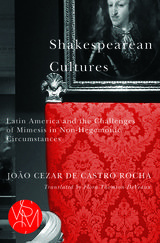 Shakespearean Cultures: Latin America and the Challenges of Mimesis in Non-Hegemonic Circumstances
João Cezar de Castro Rocha
Michigan State University Press, 2019 In Shakespearean Cultures, René Girard’s ideas on violence and the sacred inform an innovative analysis of contemporary Latin America. Castro Rocha proposes a new theoretical framework based upon the “poetics of emulation” and offers a groundbreaking approach to understanding the asymmetries of the modern world. Shakespearean cultures are those whose self-perception originates in the gaze of a hegemonic Other. The poetics of emulation is a strategy developed in situations of asymmetrical power relations. This strategy encompasses an array of procedures employed by artists, intellectuals, and writers situated at the less-favored side of such exchanges, whether they be cultural, political, or economic in nature. The framework developed in this book yields thought-provoking readings of canonical authors such as William Shakespeare, Gustave Flaubert, and Joseph Conrad. At the same time, it favors the insertion of Latin American authors into the comparative scope of world literature, and stages an unprecedented dialogue among European, North American, and Latin American readers of René Girard’s work.
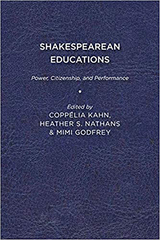 Shakespearean Educations: Power, Citizenship, and Performance
Coppélia Kahn
University of Delaware Press, 2011 Shakespearean Educations examines how and why Shakespeare’s works shaped the development of American education from the colonial period through the 1934 Chicago World’s Fair, taking the reader up to the years before the Servicemen’s Readjustment Act of 1944 (popularly known as the GI Bill), coeducation, and a nascent civil rights movement would alter the educational landscape yet again. The essays in this collection query the nature of education, the nature of citizenship in a democracy, and the roles of literature, elocution, theater, and performance in both. Expanding the notion of “education” beyond the classroom to literary clubs, private salons, public lectures, libraries, primers, and theatrical performance, this collection challenges scholars to consider how different groups in our society have adopted Shakespeare as part of a specifically “American” education. Shakespearean Educations maps the ways in which former slaves, Puritan ministers, university leaders, and working class theatergoers used Shakespeare not only to educate themselves about literature and culture, but also to educate others about their own experience.
Published by University of Delaware Press. Distributed worldwide by Rutgers University Press.
 Shakespearean Metadrama: The Argument of the Play in Titus Andronicus, Love’s Labour’s Lost, Romeo and Juliet, A Midsummer Night’s Dream, and Richard II
James L. Calderwood
University of Minnesota Press, 1971 Shakespearean Metadrama was first published in 1971. Minnesota Archive Editions uses digital technology to make long-unavailable books once again accessible, and are published unaltered from the original University of Minnesota Press editions. In a new approach to Shakespeare criticism, the author interprets five of Shakespeare's early plays as metadramas, dramas that are not only about the various moral, social, political, and other thematic issues with which critics have so long been concerned but also about the plays themselves. Professor Calderwood demonstrates that in these five plays Shakespeare writes about his dramatic art -- its nature, its media of language and theater, its generic forms and conventions, its relationship to truth and the social order. In an introductory chapter the author explains his theory of metadrama, placing it in a general critical context as well as in the specific framework of Shakespeare's plays. He distinguishes between the meaning of metadrama and the similar terms "metaplay" and "metatheare." He points out that the dominant metadramatic aspect of the five plays under study is the interplay of language and action in drama. A separate chapter is devoted to the interpretation of each of the plays. Professor Calderwood is aware that in presenting his critical theory and interpretations he may be met with skepticism by other scholars and critics. He anticipates such a situation in the introduction: "To the critic trying on introductory styles for a book on Shakespearean metadrama," he writes, "the plight of Falstaff at the Boar's Head Tavern comes all to readily to mind. 'What trick," he must ask himself, 'what device, what starting-hole, canst thou now find out to hide thee from this open and apparent shame?'"
 Shakespearean Pragmatism: Market of His Time
Lars Engle
University of Chicago Press, 1993 Just as Shakespeare's theater was an economic gamble, subject to the workings of a market, so the plays themselves submit actions, persons, and motives to an audience's judgment. Such a theatrical economy, Lars Engle suggests, provides a model for the way in which truth is determined and assessed in the world at large—a model much like that offered by contemporary pragmatism.
To Engle, the problems of worth, price, and value that appear so frequently in Shakespeare's works reveal a playwright dramatizing the negotiable nature of perception and belief—in short, the nature of his audience's purchase on reality. This innovative argument is the first to view Shakespeare in the context of contemporary pragmatism and to show that Shakespeare in many ways anticipated pragmatism as it has been developed in the thought of Richard Rorty, Barbara Herrnstein Smith, and others. With detailed reference to the sonnets and plays, Engle explores Shakespeare's tendency to treat knowledge, truth, and certainty as relatively stable goods within a theatrical economy of social interaction. He shows the playwright recasting kingship, aristocracy, and poetic immortality in pragmatic terms.
As attentive to history as it is to contemporary theory, this book mediates between current and traditional accounts of Shakespeare. In doing so, it offers a sweeping new account of Shakespeare's enterprise that will interest philosophers, literary theorists, and Shakespeare scholars alike.
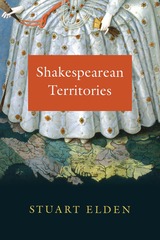 Shakespearean Territories
Stuart Elden
University of Chicago Press, 2018 Shakespeare was an astute observer of contemporary life, culture, and politics. The emerging practice of territory as a political concept and technology did not elude his attention. In Shakespearean Territories, Stuart Elden reveals just how much Shakespeare’s unique historical position and political understanding can teach us about territory. Shakespeare dramatized a world of technological advances in measuring, navigation, cartography, and surveying, and his plays open up important ways of thinking about strategy, economy, the law, and colonialism, providing critical insight into a significant juncture in history. Shakespeare’s plays explore many territorial themes: from the division of the kingdom in King Lear, to the relations among Denmark, Norway, and Poland in Hamlet, to questions of disputed land and the politics of banishment in Richard II. Elden traces how Shakespeare developed a nuanced understanding of the complicated concept and practice of territory and, more broadly, the political-geographical relations between people, power, and place. A meticulously researched study of over a dozen classic plays, Shakespearean Territories will provide new insights for geographers, political theorists, and Shakespearean scholars alike.
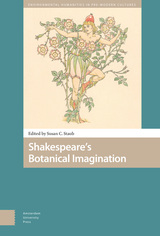 Shakespeare's Botanical Imagination
Susan C. Staub
Amsterdam University Press, 2023 Writing on the cusp of modern botany and during the heyday of English herbals and garden manuals, Shakespeare references at least 180 plants in his works and makes countless allusions to horticultural and botanical practices. Shakespeare’s Botanical Imagination moves plants to the foreground of analysis and brings together some of the rich and innovative ways that scholars are expanding the discussion of plants and botany in Shakespeare’s writings. The essays gathered here all emphasize the interdependence and entanglement of plants with humans and human life, whether culturally, socially, or materially, and vividly illustrate the fundamental role plants play in human identity. As they attend to the affinities and shared materiality between plants and humans in Shakespeare’s works, these essays complicate the comfortable Aristotelian hierarchy of human-animal-plant. And as they do, they often challenge the privileged position of humans in relation to non-human life.
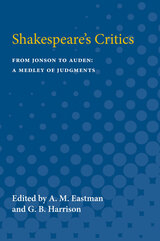 Shakespeare's Critics: From Jonson to Auden, A Medley of Judgments
A. M. Eastman and G. B. Harrison, Editors
University of Michigan Press, 1964 In Shakespeare's Critics, A. M. Eastman and G. B. Harrison bring together Shakespearean criticism of 120 poets and writers from across more than three and a half centuries. They discuss every aspect of Shakespeare's art—his style, wit, characterization, adaptability to the modern stage, even the decency of his language.The variety, diversion, and contradiction of their points of view, as well as their different approaches, heighten our enjoyment and appreciation of his art. This Baedeker of Shakespearean criticism stresses both general and specific problems of interpretation and demonstrates that for Shakespeare there is no single, agreed-upon truth.The plays, from As You Like It to The Winter's Tale, are discussed and analyzed, giving us a total picture of Shakespeare's art that is concise and comprehensive. The result is a unique compendium of the shifting tides of taste during the past 370 years.
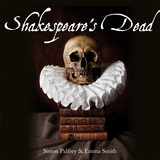 Shakespeare's Dead: Stages of Death in Shakespeare's Playworlds
Simon Palfrey and Emma Smith
Bodleian Library Publishing, 2016 Four hundred years after Shakespeare’s death, his plays live on in theater and popular culture, given new life through countless innovative approaches to their performance and interpretation. Just as our enthusiasm for seeing the plays performed—and transformed—affirms their continued life, death scenes in Shakespeare’s plays tend to mark not an ending but a transformation of life.
Published to accompany a major exhibition at the Bodleian Library, University of Oxford, Shakespeare’s Dead documents the many ways Shakespeare’s characters meet their demise, from suicide to murder, from death by workaday dagger to the more creative method of being baked and fed to one’s family in a meat pie. Through these examples, Simon Palfrey and Emma Smith show Shakespeare’s mastery at choreographing death as a means of rediscovery. Some characters refuse to go quietly, dying in stages, as in Nick Bottom’s performance as Pyramus killing himself with much flourish in A Midsummer Night’s Dream. Others are remembered in elegies, and still others are resurrected or reappear as ghosts. Shakespeare’s death scenes also often speak to the boundaries between theater and everyday life, with funerals and scenes of mourning that are undercut by their staged inauthenticity.
Extensively illustrated with contemporary drawings and images from stage history, Shakespeare’s Dead takes readers through the playwright’s great death scenes and tragic figures, exploring in them the theme of life in death and delineating the cultural, religious, and social contexts.
Shakespeare's Debt to Montaigne
George Coffin Taylor
Harvard University Press Although several studies have been devoted before now to the question of the influence exerted upon Shakespeare by Florio’s translation of Montaigne’s Essays, Professor Taylor is able in this little book to offer a new and distinctly important treatment of it. He has demonstrated that Shakespeare was, beyond any doubt, extensively influenced by Montaigne; definitely influenced in regard to vocabulary, phrases, short and long passages, and, after a fashion, influenced also in thought. The monograph will take its place among the more important Shakespeare studies and will therefore prove of unusual interest to everyone familiar with early seventeenth-century English literature.
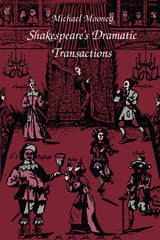 Shakespeare's Dramatic Transactions
Michael Mooney
Duke University Press, 1990 Shakespeare’s Dramatic Transactions uses conventions of performance criticism—staging and theatrical presentation—to analyze seven major Shakespearean tragedies: Hamlet, Othello, King Lear, Macbeth, Antony and Cleopatra, Richard II, and Richard III. As scholars and readers increasingly question the theoretical models used to describe the concepts of “mimesis” and “representation,” this book describes how the actor’s stage presentation affects the actor’s representational role and the ways in which viewers experience Shakespearean tragedy.
Michael Mooney draws on the work of East German critic Robert Weimann and his concept of figurenposition—the correlation between an actor’s stage location and the speech, action, and stylization associated with that position—to understand the actor/stage location relationship in Shakespeare’s plays. In his examination of the original staging of Shakespeare’s tragedies, Mooney looks at the traditional interplay between a downstage “place” and upstage “location” to describe the difference between non-illusionistic action (often staged near the audience) and the illusionistic, localized action that characterizes mimetic art.
The innovative and insightful approach of Shakespeare’s Dramatic Transactions brings together the techniques of performance criticism and the traditional literary study of Shakespearean tragedy. In showing how the distinctions of stage location illuminate the interaction among language, representation, Mooney’s compelling argument enhances our understanding of Shakespeare and the theater.
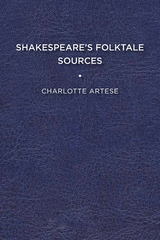 Shakespeare's Folktale Sources
Charlotte Artese
University of Delaware Press, 2015 Shakespeare’s Folktale Sources argues that seven plays—The Taming of the Shrew, Titus Andronicus, The Merry Wives of Windsor, The Merchant of Venice, All’s Well that Ends Well, Measure for Measure, and Cymbeline—derive one or more of their plots directly from folktales. In most cases, scholars have accepted one literary version of the folktale as a source. Recognizing that the same story has circulated orally and occurs in other medieval and early modern written versions allows for new readings of the plays. By acknowledging that a play’s source story circulated in multiple forms, we can see how the playwright was engaging his audience on common ground, retelling a story that may have been familiar to many of them, even the illiterate. We can also view the folktale play as a Shakespearean genre, defined by source as the chronicle histories are, that spans and traces the course of Shakespeare’s career. The fact that Shakespeare reworked folktales so frequently also changes the way we see the history of the literary folk- or fairy-tale, which is usually thought to bypass England and move from Italian novella collections to eighteenth-century French salons. Each chapter concludes with a bibliography listing versions of each folktale source as a resource for further research and teaching.
Published by University of Delaware Press. Distributed worldwide by Rutgers University Press.
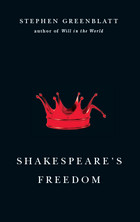 Shakespeare's Freedom
Stephen Greenblatt
University of Chicago Press, 2010 Shakespeare lived in a world of absolutes—of claims for the absolute authority of scripture, monarch, and God, and the authority of fathers over wives and children, the old over the young, and the gentle over the baseborn. With the elegance and verve for which he is well known, Stephen Greenblatt, author of the best-selling Will in the World, shows that Shakespeare was strikingly averse to such absolutes and constantly probed the possibility of freedom from them. Again and again, Shakespeare confounds the designs and pretensions of kings, generals, and churchmen. His aversion to absolutes even leads him to probe the exalted and seemingly limitless passions of his lovers.
Greenblatt explores this rich theme by addressing four of Shakespeare’s preoccupations across all the genres in which he worked. He first considers the idea of beauty in Shakespeare’s works, specifically his challenge to the cult of featureless perfection and his interest in distinguishing marks. He then turns to Shakespeare’s interest in murderous hatred, most famously embodied in Shylock but seen also in the character Bernardine in Measure for Measure. Next Greenblatt considers the idea of Shakespearean authority—that is, Shakespeare’s deep sense of the ethical ambiguity of power, including his own. Ultimately, Greenblatt takes up Shakespearean autonomy, in particular the freedom of artists, guided by distinctive forms of perception, to live by their own laws and to claim that their creations are singularly unconstrained.
A book that could only have been written by Stephen Greenblatt, Shakespeare’s Freedom is a wholly original and eloquent meditation by the most acclaimed and influential Shakespearean of our time.
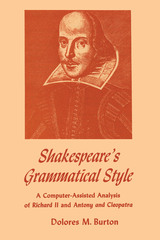 Shakespeare's Grammatical Style: A Computer-assisted Analysis of Richard II and Anthony and Cleopatra
By Dolores M. Burton
University of Texas Press, 1973 Shakespeare’s Grammatical Style is the first full-scale, systematic study using an examination of Shakespeare’s syntax as a key to the interpretation of his work. Dolores M. Burton presents information on the application of linguistic and statistical techniques to the description and analysis of style, and she has applied the insights and techniques of the major schools of linguistic inquiry, including those of London and Prague. Just as studies of imagery and vocabulary have aided interpretations of the plays, so an examination of the grammatical features of Shakespeare’s language indicates that they, too, perform a poetic and dramatic function. For example, noun modifiers like possessives and definite articles yield insights into a speaker’s point of view or subtly aid in defining the fictional world of the plays. With respect to stylistic development, Shakespeare’s handling of word order moved from a concentration of dislocated sentences and clause constituents to greater emphasis on varied and frequent permutations in nominal and verbal phrases. A computer-generated concordance of function words facilitated the study of syntactic features, which included an examination of formal aspects of diction, nominal group structure, the function and frequency of relative clauses, and the classification of sentences by mood and type. Several problems associated with quantitative and linguistic studies of a full-length literary work are discussed and exemplified. Style itself is defined mathematically as a propositional function S(A), and from this definition stylistic parameters are derived by correlating critical notions like fictional world, point of view, and characterization with differences in the syntax of the two plays.
 Shakespeare’s Hand
Jonathan Goldberg
University of Minnesota Press, 2002 A provocative exploration of the relationship between gender, history, and Shakespeare’s plays. Over the past fifteen years, Jonathan Goldberg’s wide-ranging essays have been among the most sophisticated, influential, and controversial writing about Shakespeare. He challenges the critical orthodoxy, provoking scholars to reassess both their own assumptions and those underpinning the field of Shakespeare studies. Collected in one volume for the first time, these essays offer a sustained, energetic, and rigorous examination of issues of gender and sexuality that pervade Shakespeare’s plays, as well as a road map of the shifts during the past two decades in our understanding of English literature’s most canonical figure. Central to these essays are concerns about textuality as considered from a number of vantage points, including deconstructionist, psychoanalytic, and historicist. Goldberg studies most of Shakespeare’s plays, giving particular emphasis to Henry IV, Parts 1 and 2, and to Romeo and Juliet; he focuses throughout on the relationship between the text as material object and the reality created or reflected by that text. Among the issues he considers are the textual instability of Shakespeare’s plays and the historical instabilities of gender and sexuality depicted in those plays, the construction of gender and the dehumanization implicit in treating characters as a textual production, the function of letters and other documents within the Shakespearean texts, and the correlation of sexual politics and textual desire. Tracing a path from characters in the scriptive sense to their embodiment in characters marked by gender and sexuality, Shakespeare's Hand provides a brilliant set of inquiries into the production, critical reception, and conditions of Shakespearean texts.
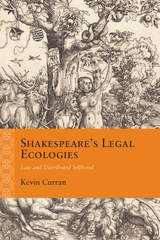 Shakespeare’s Legal Ecologies: Law and Distributed Selfhood
Kevin Curran
Northwestern University Press, 2017 Shakespeare’s Legal Ecologies offers the first sustained examination of the relationship between law and selfhood in Shakespeare’s work. Taking five plays and the sonnets as case studies, Kevin Curran argues that law provided Shakespeare with the conceptual resources to imagine selfhood in social and distributed terms, as a product of interpersonal exchange or as a gathering of various material forces. In the course of these discussions, Curran reveals Shakespeare’s distinctly communitarian vision of personal and political experience, the way he regarded living, thinking, and acting in the world as materially and socially embedded practices.
At the center of the book is Shakespeare’s fascination with questions that are fundamental to both law and philosophy: What are the sources of agency? What counts as a person? For whom am I responsible, and how far does that responsibility extend? What is truly mine? Curran guides readers through Shakespeare’s responses to these questions, paying careful attention to both historical and intellectual contexts.
The result is a book that advances a new theory of Shakespeare’s imaginative relationship to law and an original account of law’s role in the ethical work of his plays and sonnets. Readers interested in Shakespeare, theater and philosophy, law, and the history of ideas will find Shakespeare’s Legal Ecologies to be an essential resource.
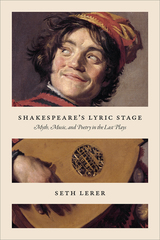 Shakespeare's Lyric Stage: Myth, Music, and Poetry in the Last Plays
Seth Lerer
University of Chicago Press, 2018 What does it mean to have an emotional response to poetry and music? And, just as important but considered less often, what does it mean not to have such a response? What happens when lyric utterances—which should invite consolation, revelation, and connection—somehow fall short of the listener’s expectations?
As Seth Lerer shows in this pioneering book, Shakespeare’s late plays invite us to contemplate that very question, offering up lyric as a displaced and sometimes desperate antidote to situations of duress or powerlessness. Lerer argues that the theme of lyric misalignment running throughout The Tempest, The Winter’s Tale, Henry VIII, and Cymbeline serves a political purpose, a last-ditch effort at transformation for characters and audiences who had lived through witch-hunting, plague, regime change, political conspiracies, and public executions.
A deep dive into the relationship between aesthetics and politics, this book also explores what Shakespearean lyric is able to recuperate for these “victims of history” by virtue of its disjointed utterances. To this end, Lerer establishes the concept of mythic lyricism: an estranging use of songs and poetry that functions to recreate the past as present, to empower the mythic dead, and to restore a bit of magic to the commonplaces and commodities of Jacobean England. Reading against the devotion to form and prosody common in Shakespeare scholarship, Lerer’s account of lyric utterance’s vexed role in his late works offers new ways to understand generational distance and cultural change throughout the playwright’s oeuvre.
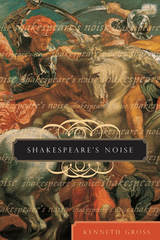 Shakespeare's Noise
Kenneth Gross
University of Chicago Press, 2001 "You common cry of curs! whose breath I hate / As reek o'th'rotten fens, whose loves I prize / As the dead carcasses of unburied men / That do corrupt my air: I banish you!" (from Coriolanus)
Kenneth Gross explores Shakespeare's deep fascination with dangerous and disorderly forms of speaking—especially rumor, slander, insult, vituperation, and curse—and through them offers a vision of the work of words in his plays. Coriolanus's taunts or Lear's curses force us to think not just about how Shakespeare's characters speak, but also about how they hear, overhear, and mishear what is spoken, how rumor becomes tragic knowledge for Hamlet, or opens Othello to fantastic jealousies. Gross also shows how Shakespeare's preoccupation with "noisy" speech echoed and transformed a broader cultural obsession with the perils of rumor, slander, and libel in Renaissance England.
Elegantly written and passionately argued, Shakespeare's Noise will challenge and delight anyone who loves his plays, from scholars to general readers, actors, and directors.
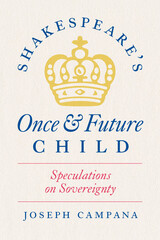 Shakespeare's Once and Future Child: Speculations on Sovereignty
Joseph Campana
University of Chicago Press, 2024 A study of Shakespeare’s child figures in relation to their own political moment, as well as our own.
Politicians are fond of saying that “children are the future.” How did the child become a figure for our political hopes? Joseph Campana’s book locates the source of this idea in transformations of childhood and political sovereignty during the age of Shakespeare, changes spectacularly dramatized by the playwright himself. Shakespeare’s works feature far more child figures—and more politically entangled children—than other literary or theatrical works of the era. Campana delves into this rich corpus to show how children and childhood expose assumptions about the shape of an ideal polity, the nature of citizenship, the growing importance of population and demographics, and the question of what is or is not human. As our ability to imagine viable futures on our planet feels ever more limited, and as children take up legal proceedings to sue on behalf of the future, it behooves us to understand the way past child figures haunt our conversations about intergenerational justice. Shakespeare offers critical precedents for questions we still struggle to answer.
Shakespeare’s Politic Comedy
Will Morrisey
St. Augustine's Press, 2022 Will Morrisey again considers the political dimensions of literary classics, as previously seen in Melville’s Ship of State (2019). His attention to Shakespeare’s comedies is a reader’s and playgoer’s delight.
INTRODUCTORY NOTE: The Politic Character of Shakespeare’s Comedy
PART ONE: THREE REGIMES: OLIGARCHY, ARISTOCRACY, MONARCHY
Chapter One: Shakespearean Comedy: Two Points on the Compass
Chapter Two: Gentlemen and Gentlemanliness
Chapter Three: Royal Dreaming
PART TWO: THE RULE OF LAW
Chapter Four: Comic Errors, Legal Slapstick
Chapter Five: What Will You?
PART THREE: THE COMEDY OF MORALS
Chapter Six: Taming Our Shrewishness
Chapter Seven: What Does Shakespeare Mean When He Says, “As You Like It”?
PART FOUR: THE COMEDY OF POLITICS
Chapter Eight: Is All Well That Ends Well?
Chapter Nine: The Geopolitics of Love
Chapter Ten: The Wisest Beholder
SHAKESPEARE’S POLITIC MERRIMENT
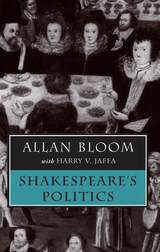 Shakespeare's Politics
Allan Bloom
University of Chicago Press, 1981 Taking the classical view that the political shapes man's consciousness, Allan Bloom considers Shakespeare as a profoundly political Renaissance dramatist. He aims to recover Shakespeare's ideas and beliefs and to make his work once again a recognized source for the serious study of moral and political problems.
In essays looking at Julius Caesar, Othello, and The Merchant of Venice, Bloom shows how Shakespeare presents a picture of man that does not assume privileged access for only literary criticism. With this claim, he argues that political philosophy offers a comprehensive framework within which the problems of the Shakespearean heroes can be viewed. In short, he argues that Shakespeare was an eminently political author. Also included is an essay by Harry V. Jaffa on the limits of politics in King Lear.
"A very good book indeed . . . one which can be recommended to all who are interested in Shakespeare." —G. P. V. Akrigg
"This series of essays reminded me of the scope and depth of Shakespeare's original vision. One is left with the impression that Shakespeare really had figured out the answers to some important questions many of us no longer even know to ask."-Peter A. Thiel, CEO, PayPal, Wall Street Journal
Allan Bloom was the John U. Nef Distinguished Service Professor on the Committee on Social Thought and the co-director of the John M. Olin Center for Inquiry into the Theory and Practice of Democracy at the University of Chicago. Harry V. Jaffa is professor emeritus at Claremont McKenna College and Claremont Graduate School.
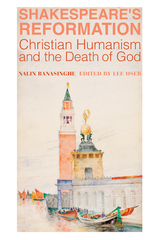 Shakespeare's Reformation: Christian Humanism and the Death of God
Nalin Ranasinghe
St. Augustine's Press, 2022 This is a posthumously published collection of Nalin Ranasinghe's sharp analyses of Shakespeare's five heavy dramas: Hamlet, King John, Julius Caesar, King Lear, and Antony and Cleopatra. True to form, Ranasinghe serves up philosophical and literary genius for the reader's benefit and delight.
"I will try to claim that Shakespeare offers an esoteric vindication of the human soul itself, not merely poetry, against the looming backdrop of the Counter-Reformation in Europe and the Puritan perversion of English Anglicanism. Neither the Scholasticism of the former nor the fundamentalism of the latter had any sympathy for the claims of men like Bottom or the Bastard to see beyond the confines of scripture and sacred social structures. While poetry could indulge in metaphysical fantasy, it could not take on the status quo without the assistance of more learned allies; this Shakespeare seems to do by his re-telling of Classical and English history. As disingenuous as Bottom (or Erasmus) in this artful use of ignorance and folly to conceal his serious goals, Shakespeare is thus tying poetry to history and giving us an alternate, if playful, account of Western Civilization."
Shakespeare's Reparative Comedies: A Psychoanalytic View of the Middle Ages
Joseph Westlund
University of Chicago Press, 1984 Joseph Westlund brings recent developments in psychoanalytic thought to his elegant and sensitive readings of Shakespeare's Merchant of Venice, Much Ado About Nothing, As You Like It, Twelfth Night, All's Well That Ends Well, and Measure for Measure. Westlund departs from the usual preoccupation in psychoanalytic criticism with conflict and guilt to rely instead on Melanie Klein's theory of reparation, which emphasizes the impulse in life to resolve and transcend conflict. Through interpretations that are new and convincing, Westlund views the interactions of characters in the six comedies as attempts to work through anger and guilt to effect reparations for themselves and for us.
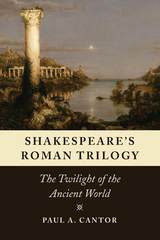 Shakespeare's Roman Trilogy: The Twilight of the Ancient World
Paul A. Cantor
University of Chicago Press, 2017 Paul A. Cantor first probed Shakespeare’s Roman plays—Coriolanus, Julius Caeser, and Antony and Cleopatra—in his landmark Shakespeare’s Rome (1976). With Shakespeare’s Roman Trilogy, he now argues that these plays form an integrated trilogy that portrays the tragedy not simply of their protagonists but of an entire political community.
Cantor analyzes the way Shakespeare chronicles the rise and fall of the Roman Republic and the emergence of the Roman Empire. The transformation of the ancient city into a cosmopolitan empire marks the end of the era of civic virtue in antiquity, but it also opens up new spiritual possibilities that Shakespeare correlates with the rise of Christianity and thus the first stirrings of the medieval and the modern worlds.
More broadly, Cantor places Shakespeare’s plays in a long tradition of philosophical speculation about Rome, with special emphasis on Machiavelli and Nietzsche, two thinkers who provide important clues on how to read Shakespeare’s works. In a pathbreaking chapter, he undertakes the first systematic comparison of Shakespeare and Nietzsche on Rome, exploring their central point of contention: Did Christianity corrupt the Roman Empire or was the corruption of the Empire the precondition of the rise of Christianity? Bringing Shakespeare into dialogue with other major thinkers about Rome, Shakespeare’s Roman Trilogy reveals the true profundity of the Roman Plays.
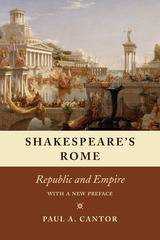 Shakespeare's Rome: Republic and Empire
Paul A. Cantor
University of Chicago Press, 2017 For more than forty years, Paul Cantor’s Shakespeare’s Rome has been a foundational work in the field of politics and literature. While many critics assumed that the Roman plays do not reflect any special knowledge of Rome, Cantor was one of the first to argue that they are grounded in a profound understanding of the Roman regime and its changes over time. Taking Shakespeare seriously as a political thinker, Cantor suggests that his Roman plays can be profitably studied in the context of the classical republican tradition in political philosophy.
In Shakespeare’s Rome, Cantor examines the political settings of Shakespeare’s Roman plays, Coriolanus and Antony and Cleopatra, with references as well to Julius Caesar. Cantor shows that Shakespeare presents a convincing portrait of Rome in different eras of its history, contrasting the austere republic of Coriolanus, with its narrow horizons and martial virtues, and the cosmopolitan empire of Antony and Cleopatra, with its “immortal longings” and sophistication bordering on decadence.
Shakespeare's Silences
Alwin Thaler
Harvard University Press Edward Dowden remarked long ago that a curious essay might be written upon the silences of some of Shakespeare’s characters. Alwin Thaler independently reached the same conclusion, as witness the first part of this book. His study, however, touches also upon many a curious silence in Shakespeare’s plot management. In short, his interest in the general “technique of silence” in Shakespeare leads him to a fresh interpretation of various and sundry aspects of Shakespeare’s dramatic technique in the large, and of the conventional technique of the critics. The second part of the book concerns Milton as well as Shakespeare. It has to do with Shakespeare’s influence upon Milton and Sir Thomas Browne, and with Milton’s connections with the drama and theatre of Shakespeare and his after-times. The book is not intended for specialists exclusively, but for lovers of Shakespeare and Milton.
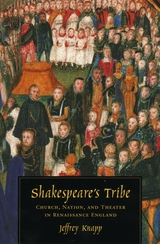 Shakespeare's Tribe: Church, Nation, and Theater in Renaissance England
Jeffrey Knapp
University of Chicago Press, 2004 Most contemporary critics characterize Shakespeare and his tribe of fellow playwrights and players as resolutely secular, interested in religion only as a matter of politics or as a rival source of popular entertainment. Yet as Jeffrey Knapp demonstrates in this radical new reading, a surprising number of writers throughout the English Renaissance, including Shakespeare himself, represented plays as supporting the cause of true religion.
To be sure, Renaissance playwrights rarely sermonized in their plays, which seemed preoccupied with sex, violence, and crime. During a time when acting was regarded as a kind of vice, many theater professionals used their apparent godlessness to advantage, claiming that it enabled them to save wayward souls the church could not otherwise reach. The stage, they argued, made possible an ecumenical ministry, which would help transform Reformation England into a more inclusive Christian society.
Drawing on a variety of little-known as well as celebrated plays, along with a host of other documents from the English Renaissance, Shakespeare's Tribe changes the way we think about Shakespeare and the culture that produced him.
Winner of the Best Book in Literature and Language from the Association of American Publishers' Professional/Scholarly division, the Conference on Christianity and Literature Book Award, and the Roland H. Bainton Prize for Literature from the Sixteenth Century Society and Conference.
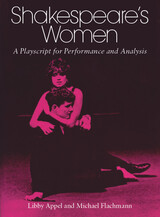 Shakespeare's Women: A Playscript for Performance and Analysis
Libby Appel and Michael Flachmann
Southern Illinois University Press, 1986
Serves both as a script for performance and as a text for high school and college theater and English classes.
This self-contained script brings together different scenes from Shakespeare’s plays to portray women “in all their infinite variety.” Two narrators, a man and a woman, introduce and comment on these scenes, weaving together the different characters and situations.
This book combines literary and theatrical techniques in examining Shakespeare’s women. Its promptbook format provides clear, helpful stage directions on pages facing each of the scenes. Also helpful are concise glosses and footnotes to define difficult words and phrases plus a commentary to explain each scene in its dramatic context.
Other features include sheet music for each song in the play, a bibliography on the topic of women in Shakespeare’s plays, and suggestions for directors who wish to stage the play.
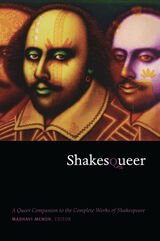 Shakesqueer: A Queer Companion to the Complete Works of Shakespeare
Madhavi Menon, ed.
Duke University Press, 2011 Shakesqueer puts the most exciting queer theorists in conversation with the complete works of William Shakespeare. Exploring what is odd, eccentric, and unexpected in the Bard’s plays and poems, these theorists highlight not only the many ways that Shakespeare can be queered but also the many ways that Shakespeare can enrich queer theory. This innovative anthology reveals an early modern playwright insistently returning to questions of language, identity, and temporality, themes central to contemporary queer theory. Since many of the contributors do not study early modern literature, Shakesqueer takes queer theory back and brings Shakespeare forward, challenging the chronological confinement of queer theory to the last two hundred years. The book also challenges conceptual certainties that have narrowly equated queerness with homosexuality. Chasing all manner of stray desires through every one of Shakespeare’s plays and poems, the contributors cross temporal, animal, theoretical, and sexual boundaries with abandon. Claiming adherence to no one school of thought, the essays consider The Winter’s Tale alongside network TV, Hamlet in relation to the death drive, King John as a history of queer theory, and Much Ado About Nothing in tune with a Sondheim musical. Together they expand the reach of queerness and queer critique across chronologies, methodologies, and bodies. Contributors. Matt Bell, Amanda Berry, Daniel Boyarin, Judith Brown, Steven Bruhm, Peter Coviello, Julie Crawford, Drew Daniel, Mario DiGangi, Lee Edelman, Jason Edwards, Aranye Fradenburg, Carla Freccero, Daniel Juan Gil, Jonathan Goldberg, Jody Greene, Stephen Guy-Bray, Ellis Hanson, Sharon Holland, Cary Howie, Lynne Huffer, Barbara Johnson, Hector Kollias, James Kuzner , Arthur L. Little Jr., Philip Lorenz, Heather Love, Jeffrey Masten, Robert McRuer , Madhavi Menon, Michael Moon, Paul Morrison, Andrew Nicholls, Kevin Ohi, Patrick R. O’Malley, Ann Pellegrini, Richard Rambuss, Valerie Rohy, Bethany Schneider, Kathryn Schwarz, Laurie Shannon, Ashley T. Shelden, Alan Sinfield, Bruce Smith, Karl Steel, Kathryn Bond Stockton, Amy Villarejo, Julian Yates
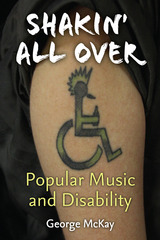 Shakin' All Over: Popular Music and Disability
George McKay
University of Michigan Press, 2013 Given the explosion in recent years of scholarship exploring the ways in which disability is manifested and performed in numerous cultural spaces, it’s surprising that until now there has never been a single monograph study covering the important intersection of popular music and disability. George McKay’s Shakin’ All Over is a cross-disciplinary examination of the ways in which popular music performers have addressed disability: in their songs, in their live performances, and in various media presentations. By looking closely into the work of artists such as Johnny Rotten, Neil Young, Johnnie Ray, Ian Dury, Teddy Pendergrass, Curtis Mayfield, and Joni Mitchell, McKay investigates such questions as how popular music works to obscure and accommodate the presence of people with disabilities in its cultural practice. He also examines how popular musicians have articulated the experiences of disability (or sought to pass), or have used their cultural arena for disability advocacy purposes.
 Shakin' Up Race and Gender: Intercultural Connections in Puerto Rican, African American, and Chicano Narratives and Culture (1965–1995)
By Marta E. Sánchez
University of Texas Press, 2006 The second phase of the civil rights movement (1965-1973) was a pivotal period in the development of ethnic groups in the United States. In the years since then, new generations have asked new questions to cast light on this watershed era. No longer is it productive to consider only the differences between ethnic groups; we must also study them in relation to one another and to U.S. mainstream society. In "Shakin' Up" Race and Gender, Marta E. Sánchez creates an intercultural frame to study the historical and cultural connections among Puerto Ricans, African Americans, and Chicanos/as since the 1960s. Her frame opens up the black/white binary that dominated the 1960s and 1970s. It reveals the hidden yet real ties that connected ethnics of color and "white" ethnics in a shared intercultural history. By using key literary works published during this time, Sánchez reassesses and refutes the unflattering portrayals of ethnics by three leading intellectuals (Octavio Paz, Daniel Patrick Moynihan, and Oscar Lewis) who wrote about Chicanos, African Americans, and Puerto Ricans. She links their implicit misogyny to the trope of La Malinche from Chicano culture and shows how specific characteristics of this trope—enslavement, alleged betrayal, and cultural negotiation—are also present in African American and Puerto Rican cultures. Sánchez employs the trope to restore the agency denied to these groups. Intercultural contact—encounters between peoples of distinct ethnic groups—is the theme of this book.
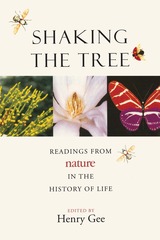 Shaking the Tree: Readings from Nature in the History of Life
Edited by Henry Gee
University of Chicago Press, 2000 Nature has published news about the history of life ever since its first issue in 1869, in which T. H. Huxley ("Darwin's bulldog") wrote about Triassic dinosaurs. In recent years, the field has enjoyed a tremendous flowering due to new investigative techniques drawn from cladistics (a revolutionary method for charting evolutionary relationships) and molecular biology.
Shaking the Tree brings together nineteen review articles written for Nature over the past decade by many of the major figures in paleontology and evolution, from Stephen Jay Gould to Simon Conway Morris. Each article is brief, accessible, and opinionated, providing "shoot from the hip" accounts of the latest news and debates. Topics covered include major extinction events, homeotic genes and body plans, the origin and evolution of the primates, and reconstructions of phylogenetic trees for a wide variety of groups. The editor, Henry Gee, gives new commentary and updated references.
Shaking the Tree is a one-stop resource for engaging overviews of the latest research in the history of life on Earth.
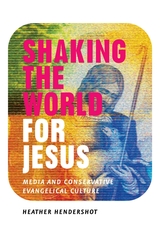 Shaking the World for Jesus: Media and Conservative Evangelical Culture
Heather Hendershot
University of Chicago Press, 2004 In 1999, the Reverend Jerry Falwell outed Tinky-Winky, the purple character from TV's Teletubbies. Events such as this reinforced in many quarters the common idea that evangelicals are reactionary, out of touch, and just plain paranoid. But reducing evangelicals to such caricatures does not help us understand their true spiritual and political agendas and the means they use to advance them. Shaking the World for Jesus moves beyond sensationalism to consider how the evangelical movement has effectively targeted Americans—as both converts and consumers—since the 1970s.
Thousands of products promoting the Christian faith are sold to millions of consumers each year through the Web, mail order catalogs, and even national chains such as Kmart and Wal-Mart. Heather Hendershot explores in this book the vast industry of film, video, magazines, and kitsch that evangelicals use to spread their message. Focusing on the center of conservative evangelical culture—the white, middle-class Americans who can afford to buy "Christian lifestyle" products—she examines the industrial history of evangelist media, the curious subtleties of the products themselves, and their success in the religious and secular marketplace.
To garner a wider audience, Hendershot argues, evangelicals have had to carefully temper their message. But in so doing, they have painted themselves into a corner. In the postwar years, evangelical media wore the message of salvation on its sleeve, but as the evangelical media industry has grown, many of its most popular products have been those with heavily diluted Christian messages. In the eyes of many followers, the evangelicals who purvey such products are sellouts—hucksters more interested in making money than spreading the word of God.
Working to understand evangelicalism rather than pass judgment on it, Shaking the World for Jesus offers a penetrating glimpse into a thriving religious phenomenon.
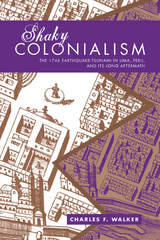 Shaky Colonialism: The 1746 Earthquake-Tsunami in Lima, Peru, and Its Long Aftermath
Charles F. Walker
Duke University Press, 2008 Contemporary natural disasters such as Hurricane Katrina are quickly followed by disagreements about whether and how communities should be rebuilt, whether political leaders represent the community’s best interests, and whether the devastation could have been prevented. Shaky Colonialism demonstrates that many of the same issues animated the aftermath of disasters more than 250 years ago. On October 28, 1746, a massive earthquake ravaged Lima, a bustling city of 50,000, capital of the Peruvian Viceroyalty, and the heart of Spain’s territories in South America. Half an hour later, a tsunami destroyed the nearby port of Callao. The earthquake-tsunami demolished churches and major buildings, damaged food and water supplies, and suspended normal social codes, throwing people of different social classes together and prompting widespread chaos. In Shaky Colonialism, Charles F. Walker examines reactions to the catastrophe, the Viceroy’s plans to rebuild the city, and the opposition he encountered from the Church, the Spanish Crown, and Lima’s multiracial population. Through his ambitious rebuilding plan, the Viceroy sought to assert the power of the colonial state over the Church, the upper classes, and other groups. Agreeing with most inhabitants of the fervently Catholic city that the earthquake-tsunami was a manifestation of God’s wrath for Lima’s decadent ways, he hoped to reign in the city’s baroque excesses and to tame the city’s notoriously independent women. To his great surprise, almost everyone objected to his plan, sparking widespread debate about political power and urbanism. Illuminating the shaky foundations of Spanish control in Lima, Walker describes the latent conflicts—about class, race, gender, religion, and the very definition of an ordered society—brought to the fore by the earthquake-tsunami of 1746.
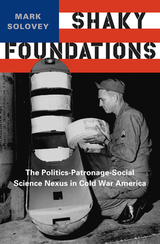 Shaky Foundations: The Politics-Patronage-Social Science Nexus in Cold War America
Solovey, Mark
Rutgers University Press, 2015 Numerous popular and scholarly accounts have exposed the deep impact of patrons on the production of scientific knowledge and its applications. Shaky Foundations provides the first extensive examination of a new patronage system for the social sciences that emerged in the early Cold War years and took more definite shape during the 1950s and early 1960s, a period of enormous expansion in American social science. By focusing on the military, the Ford Foundation, and the National Science Foundation, Mark Solovey shows how this patronage system presented social scientists and other interested parties, including natural scientists and politicians, with new opportunities to work out the scientific identity, social implications, and public policy uses of academic social research. Solovey also examines significant criticisms of the new patronage system, which contributed to widespread efforts to rethink and reshape the politics-patronage-social science nexus starting in the mid-1960s. Based on extensive archival research, Shaky Foundations addresses fundamental questions about the intellectual foundations of the social sciences, their relationships with the natural sciences and the humanities, and the political and ideological import of academic social inquiry.
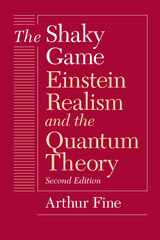 The Shaky Game
Arthur Fine
University of Chicago Press, 1996 In this new edition, Arthur Fine looks at Einstein's philosophy of science and develops his own views on realism. A new Afterword discusses the reaction to Fine's own theory.
"What really led Einstein . . . to renounce the new quantum order? For those interested in this question, this book is compulsory reading."—Harvey R. Brown, American Journal of Physics
"Fine has successfully combined a historical account of Einstein's philosophical views on quantum mechanics and a discussion of some of the philosophical problems associated with the interpretation of quantum theory with a discussion of some of the contemporary questions concerning realism and antirealism. . . . Clear, thoughtful, [and] well-written."—Allan Franklin, Annals of Science
"Attempts, from Einstein's published works and unpublished correspondence, to piece together a coherent picture of 'Einstein realism.' Especially illuminating are the letters between Einstein and fellow realist Schrödinger, as the latter was composing his famous 'Schrödinger-Cat' paper."—Nick Herbert, New Scientist
"Beautifully clear. . . . Fine's analysis is penetrating, his own results original and important. . . . The book is a splendid combination of new ways to think about quantum mechanics, about realism, and about Einstein's views of both."—Nancy Cartwright, Isis
 The Shale Dilemma: A Global Perspective on Fracking and Shale Development
Shanti Gamper-Rabindran
University of Pittsburgh Press, 2017 The US shale boom and efforts by other countries to exploit their shale resources could reshape energy and environmental landscapes across the world. But how might those landscapes change? Will countries with significant physical reserves try to exploit them? Will they protect or harm local communities and the global climate? Will the benefits be shared or retained by powerful interests? And how will these decisions be made?
The Shale Dilemma brings together experts working at the forefront of shale gas issues on four continents to explain how countries reach their decisions on shale development. Using a common analytical framework, the authors identify both local factors and transnational patterns in the decision-making process. Eight case studies reveal the trade-offs each country makes as it decides whether to pursue, delay, or block development. Those outcomes in turn reflect the nature of a country’s political process and the power of interest groups on both sides of the issue. The contributors also ask whether the economic arguments made by the shale industry and its government supporters have overshadowed the concerns of local communities for information on the effects of shale operations, and for tax policies and regulations to ensure broad-based economic development and environmental protection.
As an informative and even-handed account, The Shale Dilemma recommends practical steps to help countries reach better, more transparent, and more far-sighted decisions.
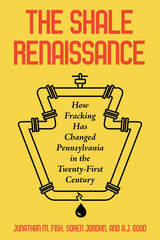 The Shale Renaissance: How Fracking Has Changed Pennsylvania in the Twenty-First Century
Jonathan M. Fisk, Soren Jordan, and David Allen Good Jr.
University of Pittsburgh Press, 2022 Although a technique for hydraulic fracturing—more commonly known as fracking—was developed and implemented in the 1970s in Texas, fracking of the Marcellus Shale formation that stretches from West Virginia through Pennsylvania to New York did not begin in earnest until the twenty-first century. Unconventional natural gas production via fracking has ignited debate, challenged regulators, and added to the complexity of twenty-first-century natural resource management. Through a longitudinal study taken from 2000 to 2015, Jonathan M. Fisk, Soren Jordan, and A. J. Good examine how the management of natural resources functions relative to specific regulatory actions including inspections, identifying violations, and the use of specific regulatory tools. Ultimately, they find that factors as disparate as state policy goals, elected officials, the availability of data, inspectors, front-line staff, and the use of technology form a context that, in turn, shapes the use of specific regulatory tools and decisions.
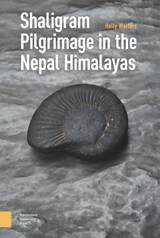 Shaligram Pilgrimage in the Nepal Himalayas
Holly Walters
Amsterdam University Press, 2020 For roughly two thousand years, the veneration of sacred fossil ammonites, called Shaligrams, has been an important part of Hindu and Buddhist ritual practice throughout South Asia and among the global Diaspora. Originating from a single remote region of Himalayan Nepal, called Mustang, Shaligrams are all at once fossils, divine beings, and intimate kin with families and worshippers. Through their lives, movements, and materiality, Shaligrams then reveal fascinating new dimensions of religious practice, pilgrimage, and politics. But as social, environmental, and national conflicts in the politically-contentious region of Mustang continue to escalate, the geologic, mythic, and religious movements of Shaligrams have come to act as parallels to the mobility of people through both space and time. Shaligram mobility therefore traverses through multiple social worlds, multiple religions, and multiple nations revealing Shaligram practitioners as a distinct, alternative, community struggling for a place in a world on the edge.
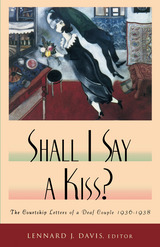 Shall I Say A Kiss?: The Courtship Letters of a Deaf Couple, 1936-1938
Lennard J. Davis
Gallaudet University Press, 1999 Upon the death of his father Morris at age 82, Lennard Davis found among his effects a trove of letters, kept in careful chronological order, that dated from 1936. The letters ended in 1938, when Eva Weintrobe came to America to marry Morris, and they provide the core of Shall I Say A Kiss?, their courtship by correspondence. In his framing comments, Davis speculates that his parents met perhaps four or five times before they wed, a fact that heightens the importance of these letters to their fate. Davis illustrates vast contrasts between Morris and Eva, both to each other (Morris was 38; Eva was 26), and to themselves in later life as witnessed by their son. Where Davis saw his father brimming with confidence and a sense of superior intellect while his mother acted as the reserved, dutiful wife, he was startled to learn through their letters that she could be the shrewd questioning correspondent even as his father wrote as an unsure, imploring suitor.
Shall I Say A Kiss? opens a window into the lives of two working-class, Jewish, British, Deaf people in the 1930s. This striking book reveals a consistent, journal-like account of the “lived” experience of Deaf people during the tumultuous times just prior to World War II. Because the correspondence is mainly composed of Eva’s letters, the focus sharpens even further as a record of the life and opinions of a young, working-class, Deaf woman about to embark upon marriage and life in a new country. The challenges she faced, including de facto racial barriers for both deaf and Jewish immigrants, and the prospect of uniting with a man she knew mostly through his letters alone, make for a compelling and emotional trip through her life. Shall I Say A Kiss? serves as a singular social document and also as an engaging and often moving narrative that will win audiences among academics and romantics alike.
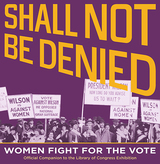 Shall Not Be Denied: Women Fight for the Vote
Library of Library of Congress
Rutgers University Press, 2019 Official Companion to the Library of Congress Exhibition. The campaign for women’s suffrage—considered the largest reform movement in American history—lasted more than seven decades. The struggle was not for the fainthearted. For years, determined women organized, lobbied, paraded, petitioned, lectured, picketed, and faced imprisonment in pursuit of the right to vote. Drawing from the Library’s extensive collections of photographs, personal papers, and the organizational records of such figures as Susan B. Anthony, Elizabeth Cady Stanton, Mary Church Terrell, Carrie Chapman Catt, the National Woman’s Party, and the National American Woman Suffrage Association, Shall Not Be Denied traces the movement leading to the women’s rights convention at Seneca Falls, the contributions of suffragists who worked to persuade women that they deserved the same rights as men, the divergent political strategies and internal divisions they overcame, the push for a federal women’s suffrage amendment, and the legacy of the movement.
A companion to the exhibition staged by the Library of Congress, which opened on June 4, 2019—the 100th anniversary of the US Senate’s passage of the suffrage amendment that would become the 19th amendment—Shall Not Be Denied: Women Fight for the Vote is part of the national commemoration of the 100th anniversary of women’s suffrage. Published by Rutgers University Press in association with the Library of Congress.
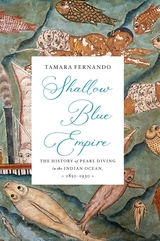 Shallow Blue Empire: A History of Pearl Diving in the Indian Ocean, 1850-1930
Tamara Surani Fernando
Harvard University Press A nuanced history of seafaring communities in the Indian Ocean, where the force of British imperial power depended on the expertise of local divers and sailors to feed a global demand for pearls.
In the late nineteenth century, thousands of men and boys across the northern rim of the Indian Ocean dove daily to the ocean floor in search of pearl-bearing oysters. It was the height of the so-called global pearl boom, driven by enormous demand for pearls in Europe and North America. Far removed from the showrooms of New York, London, and Paris, these divers drew on skills and expertise handed down across generations to conduct the dangerous work of hauling oysters up from the warm shallows. But they also faced a new challenge: the rise of British power in the Indian Ocean, where colonial officials relied heavily on local knowledge and labor to feed the lucrative pearling industry.
Tamara Fernando examines the transformations wrought by colonial extraction across the three primary sites that fed the pearl boom between 1850 and 1930: the Persian Gulf, the Gulf of Mannar near Sri Lanka, and the Mergui Archipelago in Myanmar. British oversight transformed migration patterns and the dynamics of race and caste among divers, while imperial scientists regularly tested new technologies and techniques intended to improve oyster hauls. Yet even as the positions of local divers and sailors changed dramatically, their expertise remained paramount to the industry—until, in the 1930s, the depletion of oyster beds and the rise of lab-grown alternatives shuttered the market for natural pearls altogether.
A vivid account of how seafaring communities navigated these shifting tides, Shallow Blue Empire fundamentally recenters the human labor, animal lives, and environmental conditions that sustained a global obsession with pearls.
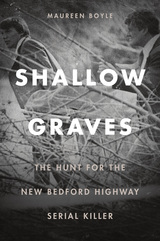 Shallow Graves: The Hunt for the New Bedford Highway Serial Killer
Maureen Boyle
University Press of New England, 2017 Eleven women went missing over the spring and summer of 1988 in New Bedford, Massachusetts, an old fishing port known as the Whaling City, where Moby Dick, Frederick Douglass, textile mills, and heroin-dealing represent just a few of the many threads in the community’s diverse fabric. In Shallow Graves, investigative reporter Maureen Boyle tells the story of a case that has haunted New England for thirty years. The Crimes: The skeletal remains of nine of the women, aged nineteen to thirty-six, were discovered near highways around New Bedford. Some had clearly been strangled, others were so badly decomposed that police were left to guess how they had died. The Victims: All the missing women had led troubled lives of drug addiction, prostitution, and domestic violence, including Nancy Paiva, whose sister was a hard-working employee of the City of New Bedford, and Debra Greenlaw DeMello, who came from a solidly middle-class family but fell into drugs and abusive relationships. In a bizarre twist, Paiva’s clothes were found near DeMello’s body. The Investigators: Massachusetts state troopers Maryann Dill and Jose Gonsalves were the two constants in a complex cast of city, county, and state cops and prosecutors. They knew the victims, the suspects, and the drug-and-crime-riddled streets of New Bedford. They were present at the beginning of the case and they stayed to the bitter end. The Suspects: Kenneth Ponte, a New Bedford attorney and deputy sheriff with an appetite for drugs and prostitutes, landed in the investigative crosshairs from the start. He was indicted by a grand jury in the murder of one of the victims, but those charges were later dropped. Anthony DeGrazia was a loner who appeared to fit the classic serial-killer profile: horrific childhood abuse, charming, charismatic, but prone to bursts of violence. He hunted prostitutes in the city by night and served at a Catholic church by day. Which of these two was the real killer? Or was it someone else entirely? Maureen Boyle first broke the story in 1988 and stayed with it for decades. In Shallow Graves she spins a riveting narrative about the crimes, the victims, the hunt for the killers, and the search for justice, all played out against the backdrop of an increasingly impoverished community beset by drugs and crime. Drawing on more than one hundred interviews, along with police reports, first-person accounts, and field reporting both during the killings and more recently, Shallow Graves brings the reader behind the scenes of the investigation, onto the streets of the city, and into the homes of the families still hoping for answers.
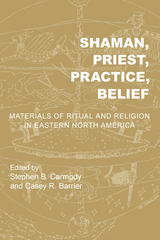 Shaman, Priest, Practice, Belief: Materials of Ritual and Religion in Eastern North America
Edited by Stephen B. Carmody and Casey R. Barrier
University of Alabama Press, 2020 Archaeological case studies consider material evidence of religion and ritual in the pre-Columbian Eastern Woodlands
Archaeologists today are interpreting Native American religion and ritual in the distant past in more sophisticated ways, considering new understandings of the ways that Native Americans themselves experienced them. Shaman, Priest, Practice, Belief: Materials of Ritual and Religion in Eastern North America broadly considers Native American religion and ritual in eastern North America and focuses on practices that altered and used a vast array of material items as well as how physical spaces were shaped by religious practices.
Unbound to a single theoretical perspective of religion, contributors approach ritual and religion in diverse ways. Importantly, they focus on how people in the past practiced religion by altering and using a vast array of material items, from smoking pipes, ceremonial vessels, carved figurines, and iconographic images, to sacred bundles, hallucinogenic plants, revered animals, and ritual architecture. Contributors also show how physical spaces were shaped by religious practice, and how rock art, monuments, soils and special substances, and even land- and cityscapes were part of the active material worlds of religious agents.
Case studies, arranged chronologically, cover time periods ranging from the Paleoindian period (13,000–7900 BC) to the late Mississippian and into the protohistoric/contact periods. The geographical scope is much of the greater southeastern and southern Midwestern culture areas of the Eastern Woodlands, from the Central and Lower Mississippi River Valleys to the Ohio Hopewell region, and from the greater Ohio River Valley down through the Deep South and across to the Carolinas.
Contributors
Sarah E. Baires / Melissa R. Baltus / Casey R. Barrier / James F. Bates / Sierra M. Bow / James A. Brown / Stephen B. Carmody / Meagan E. Dennison / Aaron Deter-Wolf / David H. Dye / Bretton T. Giles / Cameron Gokee / Kandace D. Hollenbach / Thomas A. Jennings / Megan C. Kassabaum / John E. Kelly / Ashley A. Peles / Tanya M. Peres / Charlotte D. Pevny / Connie M. Randall / Jan F. Simek / Ashley M. Smallwood / Renee B. Walker / Alice P. Wright
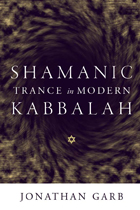 Shamanic Trance in Modern Kabbalah
Jonathan Garb
University of Chicago Press, 2011 Bringing to light a hidden chapter in the history of modern Judaism, Shamanic Trance in Modern Kabbalah explores the shamanic dimensions of Jewish mysticism. Jonathan Garb integrates methods and models from the social sciences, comparative religion, and Jewish studies to offer a fresh view of the early modern kabbalists and their social and psychological contexts.
Through close readings of numerous texts—some translated here for the first time—Garb draws a more complete picture of the kabbalists than previous depictions, revealing them to be as concerned with deeper states of consciousness as they were with study and ritual. Garb discovers that they developed physical and mental methods to induce trance states, visions of heavenly mountains, and transformations into animals or bodies of light. To gain a deeper understanding of the kabbalists’ shamanic practices, Garb compares their experiences with those of mystics from other traditions as well as with those recorded by psychologists such as Milton Erickson and Carl Jung. Finally, Garb examines the kabbalists’ relations with the wider Jewish community, uncovering the role of kabbalistic shamanism in the renewal of Jewish tradition as it contended with modernity.
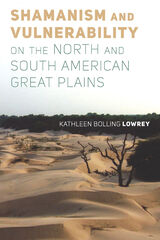 Shamanism and Vulnerability on the North and South American Great Plains
Kathleen Bolling Lowrey
University Press of Colorado, 2020 In Shamanism and Vulnerability on the North and South American Great Plains Kathleen Bolling Lowrey provides an innovative and expansive study of indigenous shamanism and the ways in which it has been misinterpreted and dismissed by white settlers, NGO workers, policymakers, government administrators, and historians and anthropologists. Employing a wide range of theory on masculinity, disability, dependence, domesticity, and popular children’s literature, Lowrey examines the parallels between the cultures and societies of the South American Gran Chaco and those of the North American Great Plains and outlines the kinds of relations that invite suspicion and scrutiny in divergent contexts in the Americas: power and autonomy in the case of Amerindian societies and weakness and dependence in the case of settler societies. She also demonstrates that, where stigmatized or repressed in practice, dependence and power manifest and intersect in unexpected ways in storytelling, fantasy, and myth.
The book reveals the various ways in which anthropologists, historians, folklorists, and other writers have often misrepresented indigenous shamanism and revitalization movements by unconsciously projecting ideologies and assumptions derived from modern ‘contract societies’ onto ethnographic and historical realities. Lowrey also provides alternative ways of understanding indigenous American communities and their long histories of interethnic relations with expanding colonial and national states in the Americas. A creative historical and ethnographical reevaluation of the last few decades of scholarship on shamanism, disability, and dependence, Shamanism and Vulnerability on the North and South American Great Plains will be of interest to scholars of North and South American anthropology, indigenous history, American studies, and feminism.
Shamanism, Colonialism, and the Wild Man: A Study in Terror and Healing
Michael Taussig
University of Chicago Press, 1987 Working with the image of the Indian shaman as Wild Man, Taussig reveals not the magic of the shaman but that of the politicizing fictions creating the effect of the real.
"This extraordinary book . . . will encourage ever more critical and creative explorations."—Fernando Coronil, [I]American Journal of Sociology[/I]
"Taussig has brought a formidable collection of data from arcane literary, journalistic, and biographical sources to bear on . . . questions of evil, torture, and politically institutionalized hatred and terror. His intent is laudable, and much of the book is brilliant, both in its discovery of how particular people perpetrated evil and others interpreted it."—Stehen G. Bunker, Social Science Quarterly
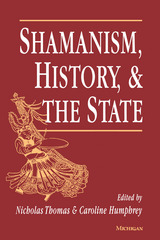 Shamanism, History, and the State
Nicholas Thomas and Caroline Humphrey, Editors
University of Michigan Press, 1996 The literature on shamanism and related topics is extensive, but has in general been biased toward curing and trance; the political and historical significance of shamanic activities has been largely neglected. The contributors to Shamanism, History, and the State--distinguished anthropologists and historians from England, Australia, and France--show that shamanism is not static and stable, but always changing as a result of political dynamics and historical processes.
Contributors are Tamsyn Barton, Sysan Bayly, Mary Beard, Maurice Bloch, Peter Gow, Roberte N. Hamayon, Stephen Hugh-Jones, Caroline Humphrey, and Nicholas Thomas.
"The importance of this collection lies in the painstaking, many-sided ways in which it shows 'shamanism' to be a multifarious and continuously changing 'dialogue' or interaction with specific, local contexts. . . . Thus, rather than tackling the issue in principle, this collection tries to demonstrate through 'case studies' just how different 'shamanism' becomes if seen through a lens sensitive to history and the influence of institutions, such as the state, which seem far removed from it. I think the demonstrations add up to an impressive force." --Michael Taussig
"This new, ably edited volume provides . . . chapters that are rich in historic detail and that provide insights into general cultural processes and social interactions." --Historian
Nicholas Thomas is Queen Elizabeth II Research Fellow, Department of Prehistory and Anthropology, Australian National University, Canberra. He is the author of Out of Time: History and Evolution in Anthropological Discourse. Caroline Humphrey, author of Karl Marx Collective: Economy, Society and Religion in a Siberian Collective Farm, is Fellow of King's College and Lecturer in Social Anthropology, University of Cambridge.
 Shamans and Robots: On Ritual, the Placebo Effect, and Artificial Consciousness
Roger Bartra
University of Minnesota Press, 2024 A profound exploration of the external influences that shape human consciousness, from healing rituals to digital devices
In this voyage through thousands of years of psychosomatic healing, distinguished anthropologist and sociologist Roger Bartra examines the placebo effect as a key to our understanding of human consciousness. Shamans and Robots demonstrates how biology and technology become intertwined within human culture by using the various histories of ritual and symbolic healing to speculate about future developments in artificial intelligence. Charting the extensive history of the placebo effect through medieval healing, shamanism, and early psychoanalytic practices, Bartra posits that consciousness is not simply the province of the mind but something equally shaped by external systems and objects. He finds evidence of this “exocerebrum”—the extension of our brains outside the body—in the shamanistic concept of the placebo, in which external objects heal our bodies, and in modern technical devices like prostheses or robots, whose development of a mechanical consciousness would have to mimic, and in turn elucidate, the processes involved in the creation of consciousness in humans. Through this radical concept, he analyzes digital media’s relationship to the functions of the human brain and probes the possibility of artificial consciousness. Both a look at the human body’s potential to restore itself and a profound reflection on the curative power of symbolic structures, Shamans and Robots explores how our technologies increasingly serve as extensions of our cognitive selves.
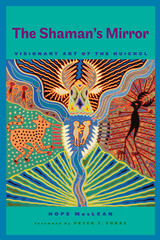 The Shaman’s Mirror: Visionary Art of the Huichol
By Hope MacLean
University of Texas Press, 2011 Huichol Indian yarn paintings are one of the world's great indigenous arts, sold around the world and advertised as authentic records of dreams and visions of the shamans. Using glowing colored yarns, the Huichol Indians of Mexico paint the mystical symbols of their culture—the hallucinogenic peyote cactus, the blue deer-spirit who appears to the shamans as they croon their songs around the fire in all-night ceremonies deep in the Sierra Madre mountains, and the pilgrimages to sacred sites, high in the central Mexican desert of Wirikuta. Hope MacLean provides the first comprehensive study of Huichol yarn paintings, from their origins as sacred offerings to their transformation into commercial art. Drawing on twenty years of ethnographic fieldwork, she interviews Huichol artists who have innovated important themes and styles. She compares the artists' views with those of art dealers and government officials to show how yarn painters respond to market influences while still keeping their religious beliefs. Most innovative is her exploration of what it means to say a tourist art is based on dreams and visions of the shamans. She explains what visionary experience means in Huichol culture and discusses the influence of the hallucinogenic peyote cactus on the Huichol's remarkable use of color. She uncovers a deep structure of visionary experience, rooted in Huichol concepts of soul-energy, and shows how this remarkable conception may be linked to visionary experiences as described by other Uto-Aztecan and Meso-American cultures.
Shamans, Mystics and Doctors: A Psychological Inquiry into India and its Healing Traditions
Sudhir Kakar
University of Chicago Press, 1990 Sudhir Kakar, a psychoanalyst and scholar, brilliantly illuminates the ancient healing traditions of India embodied in the rituals of shamans, the teachings of gurus, and the precepts of the school of medicine known as Ayurveda.
"With extraordinary sympathy, open-mindedness, and insight Sudhir Kakar has drawn from both his Eastern and Western backgrounds to show how the gulf that divides native healer from Western psychiatrist can be spanned."—Rosemary Dinnage, New York Review of Books
"Each chapter describes the geographical and cultural context within which the healers work, their unique approach to healing mental illness, and . . . the philosophical and religious underpinnings of their theories compared with psychoanalytical theory."—Choice
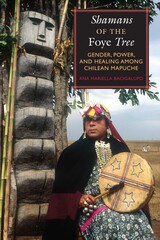 Shamans of the Foye Tree: Gender, Power, and Healing among Chilean Mapuche
By Ana Mariella Bacigalupo
University of Texas Press, 2007 Drawing on anthropologist Ana Mariella Bacigalupo's fifteen years of field research, Shamans of the Foye Tree: Gender, Power, and Healing among Chilean Mapuche is the first study to follow shamans' gender identities and performance in a variety of ritual, social, sexual, and political contexts. To Mapuche shamans, or machi, the foye tree is of special importance, not only for its medicinal qualities but also because of its hermaphroditic flowers, which reflect the gender-shifting components of machi healing practices. Framed by the cultural constructions of gender and identity, Bacigalupo's fascinating findings span the ways in which the Chilean state stigmatizes the machi as witches and sexual deviants; how shamans use paradoxical discourses about gender to legitimatize themselves as healers and, at the same time, as modern men and women; the tree's political use as a symbol of resistance to national ideologies; and other components of these rich traditions. The first comprehensive study on Mapuche shamans' gendered practices, Shamans of the Foye Tree offers new perspectives on this crucial intersection of spiritual, social, and political power.
 Shamans, Software, and Spleens: Law and the Construction of the Information Society
James Boyle
Harvard University Press, 1996 Who owns your genetic information? Might it be the doctors who, in the course of removing your spleen, decode a few cells and turn them into a patented product? In 1990 the Supreme Court of California said yes, marking another milestone on the information superhighway. This extraordinary case is one of the many that James Boyle takes up in Shamans, Software, and Spleens, a timely look at the infinitely tricky problems posed by the information society. Discussing topics ranging from blackmail and insider trading to artificial intelligence (with good-humored stops in microeconomics, intellectual property, and cultural studies along the way), Boyle has produced a work that can fairly be called the first social theory of the information age.
Now more than ever, information is power, and questions about who owns it, who controls it, and who gets to use it carry powerful implications. These are the questions Boyle explores in matters as diverse as autodialers and direct advertising, electronic bulletin boards and consumer databases, ethno-botany and indigenous pharmaceuticals, the right of publicity (why Johnny Carson owns the phrase "Here's Johnny!"), and the right to privacy (does J. D. Salinger "own" the letters he's sent?). Boyle finds that our ideas about intellectual property rights rest on the notion of the Romantic author--a notion that Boyle maintains is not only outmoded but actually counterproductive, restricting debate, slowing innovation, and widening the gap between rich and poor nations. What emerges from this lively discussion is a compelling argument for relaxing the initial protection of authors' works and expanding the concept of the fair use of information. For those with an interest in the legal, ethical, and economic ramifications of the dissemination of information--in short, for every member of the information society, willing or unwilling--this book makes a case that cannot be ignored.
Shamara and Other Stories
Svetlana Vasilenko
Northwestern University Press, 1999 This collection features Svetlana Vasilenko's novel Little Fool, nominated for the Russian Booker Prize. Rich in folklore, legend, and history, the story follows the transformation of Ganna, a girl from the Volga shores, into a modern-day Madonna. Also included are the novella "Shamara" and several short stories, including the acclaimed "Going After Goat Antelopes."
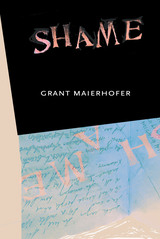 Shame
Grant Maierhofer
University of Alabama Press, 2022 A kaleidoscopic sequence of autofictional narratives about identity, grief, and narrative itself. Shame is a daring exploration of the potential and limits of memory and self. Here we meet Grant Maierhofer at various points within his life then, now, and in the future as he investigates the sense of shame that haunts the course of his days. The real and unreal, fact and fiction, blur together in a Kaufmanesque sequence of overlapping narratives about who we really are, how we cope with regret, and the repetitions of our behavior.
Through lists, fragments, recollections, and rants, the story of a son’s vexing grief for his father emerges. A sober addict trying to figure out how to navigate pleasure, diversion, and escape. A father trying to figure out marriage, children, maturity, and responsibility. A confused observer in a world constantly torn apart by media, politics, and aggression. A meditation on the nature of art, and art’s place in contemporary life.
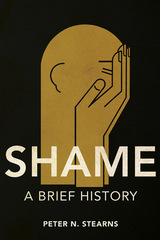 Shame: A Brief History
Peter Stearns
University of Illinois Press, 2017 Shame varies as an individual experience and in its manifestations across time and cultures. Groups establish identity and enforce social behaviors through shame and shaming, while attempts at shaming often provoke a social or political backlash. Yet historians often neglect shame’s power to complicate individual, international, cultural, and political relationships. Peter N. Stearns draws on his long career as a historian of emotions to provide the foundational text on shame’s history and how this history contributes to contemporary issues around the emotion. Summarizing current research, Stearns unpacks the major debates that surround this complex emotion. He also surveys the changing role of shame in the United States from the nineteenth century to today, including shame’s revival as a force in the 1960s and its place in today’s social media. Looking ahead, he maps the abundant opportunities for future historical research and historically informed interdisciplinary scholarship. Written for interested readers and scholars alike, Shame combines significant new research with a wider synthesis.
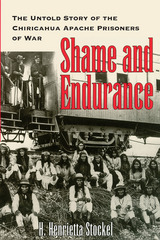 Shame and Endurance: The Untold Story of the Chiricahua Apache Prisoners of War
H. Henrietta Stockel
University of Arizona Press, 2004 Many readers may be familiar with the wartime exploits of the Apaches; this book relates the untold story of their postwar fate. It tells of the Chiricahua Apaches’ 27 years of imprisonment as recorded in American dispatches, reports, and news items: documents that disclose the confusion, contradictions, and raw emotions expressed by government and military officials regarding the Apaches while revealing the shameful circumstances in which they were held.
First removed from Arizona to Florida, the prisoners were eventually relocated to Mount Vernon Barracks in Alabama, where, in the words of one Apache, "We didn’t know what misery was until they dumped us in those swamps." Pulmonary disease took its toll—by 1894, disease had killed nearly half of the Apaches—and after years of pressure from Indian rights activists and bureaucratic haggling, Fort Sill in Oklahoma was chosen as a more healthful location. Here they were given the opportunity to farm, and here Geronimo, who eventually converted to Christianity, died of pneumonia in 1909 at the age of 89, still a prisoner of war. In the meantime, many Apache children had been removed to Carlisle, Pennsylvania, for education—despite earlier promises that families would not be split up—and most eventually lost their cultural identity.
Henrietta Stockel has combed public records to reconstruct this story of American shame and Native endurance. Unabashedly speaking on behalf of the Apaches, she has framed these documents within a readable narrative to show how exasperated public officials, eager to openly demonstrate their superiority over "savages" who had successfully challenged the American military for years, had little sympathy for the consequences of their confinement. Although the Chiricahua Apaches were not alone in losing their ancestral homelands, they were the only American Indians imprisoned for so long a time in an environment that continually exposed them to illnesses against which they had no immunity, devastating families even more than warfare. Shame and Endurance records events that ought never to be repeated—and tells a story that should never be forgotten.
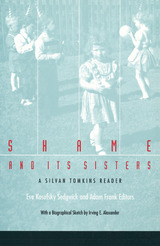 Shame and Its Sisters: A Silvan Tomkins Reader
Eve Kosofsky Sedgwick and Adam Frank, eds.
Duke University Press, 1995 The question of affect is central to critical theory, psychology, politics, and the entire range of the humanities; but no discipline, including psychoanalysis, has offered a theory of affect that would be rich enough to account for the delicacy and power, the evanescence and durability, the bodily rootedness and the cultural variability of human emotion.SilvanTomkins (1911–1991) was one of the most radical and imaginative psychologists of the twentieth century. In Affect, Imagery, Consciousness, a four-volume work published over the last thirty years of his life, Tomkins developed an ambitious theory of affect steeped in cybernetics and systems theory as well as in psychoanalysis, ethology, and neuroscience. The implications of his conceptually daring and phenomenologically suggestive theory are only now—in the context of postmodernism—beginning to be understood. With Shame and Its Sisters, editors Eve Kosofsky Sedgwick and Adam Frank make available for the first time an engaging and accessible selection of Tomkins’s work.
Featuring intensive examination of several key affects, particularly shame and anger, this volume contains many of Tomkins’s most haunting, diagnostically incisive, and theoretically challenging discussions. An introductory essay by the editors places Tomkins’s work in the context of postwar information technologies and will prompt a reexamination of some of the underlying assumptions of recent critical work in cultural studies and other areas of the humanities. The text is also accompanied by a biographical sketch of Tomkins by noted psychologist Irving E. Alexander, Tomkins’s longtime friend and collaborator.
The Shame of It: Global Perspectives on Anti-poverty Policies
Edited by Erika K. Gubrium, Sony Pellissery, and Ivar Lødemel
Bristol University Press, 2014 We have long recognized that poverty carries a tremendous feeling of shame. However, few have let this overwhelming fact actually influence the making and implementation of anti-poverty policies. The Shame of It demonstrates that in order for anti-poverty policies to be truly effective, they must take into account the psychological trauma that poverty creates. Drawing on pioneering empirical research from a diverse group of countries, including the United Kingdom, Uganda, Norway, Pakistan, India, South Korea, and China, the contributors outline core principles that can bring policy makers greater sensitivity to the power of shame and, thus, the foundations for more effective ways of combating poverty.
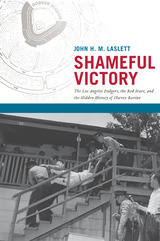 Shameful Victory: The Los Angeles Dodgers, the Red Scare, and the Hidden History of Chavez Ravine
John H. M. Laslett
University of Arizona Press, 2015 On May 8, 1959, the evening news shocked Los Angeles residents, who saw LA County sheriffs carrying a Mexican American woman from her home in Chavez Ravine not far from downtown. Immediately afterward, the house was bulldozed to the ground. This violent act was the last step in the forced eviction of 3,500 families from the unique hilltop barrio that in 1962 became the home of the Los Angeles Dodgers.
John H. M. Laslett offers a new interpretation of the Chavez Ravine tragedy, paying special attention to the early history of the barrio, the reform of Los Angeles's destructive urban renewal policies, and the influence of the evictions on the collective memory of the Mexican American community.
In addition to examining the political decisions made by power brokers at city hall, Shameful Victory argues that the tragedy exerted a much greater influence on the history of the Los Angeles civil rights movement than has hitherto been appreciated. The author also sheds fresh light on how the community grew, on the experience of individual home owners who were evicted from the barrio, and on the influence that the event had on the development of recent Chicano/a popular music, drama, and literature.
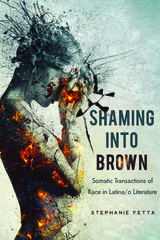 Shaming into Brown: Somatic Transactions of Race in Latina/o Literature
Stephanie Fetta
Ohio State University Press, 2018 Winner of the 2019 MLA Prize in United States Latina and Latino and Chicana and Chicano Literary and Cultural Studies
In Shaming into Brown: Somatic Transactions of Race in Latina/o Literature, Stephanie Fetta asserts that our bodies are fundamental to how we live and how we make meaning. Anchored by two psychoanalytic theories, bioenergetic analysis developed by Alexander Lowen and affect theory put forth by Silvan Tomkins, Fetta examines Latinx fiction to draw attention to the cultural role of the intelligent, emotional, and communicative body—the soma—in relation to shame. She argues that we bring the soma—the physical, emotive, and social register of our subjectivity—to the text as we do to our lives,proposing that the power of racialization operates at the level of somatic expression and reception through habituated, socially cued behaviors that are not readily subject to intentional control.
Fetta examines shame beyond individual experiences, looking at literary renderings of the cultural practice of racial shaming that are deeply embedded into our laws, hiring practices, marketing strategies, and more. Grounding her analysis in the works of Gloria Anzaldúa and Cherríe Moraga, Shaming into Brown focuses on exposing the underpinnings of racialized shame and does so through analyzing “scenes of racialization” in prominent works by authors such as Junot Díaz, Sandra Cisneros, and Oscar Zeta Acosta.
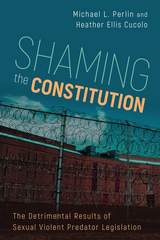 Shaming the Constitution: The Detrimental Results of Sexual Violent Predator Legislation
Michael L. Perlin
Temple University Press, 2017 Convicted sexually violent predators are more vilified, more subject to media misrepresentation, and more likely to be denied basic human rights than any other population. Shaming the Constitution authors Michael Perlin and Heather Cucolo question the intentions of sex offender laws, offering new approaches to this most complex (and controversial) area of law and social policy. The authors assert that sex offender laws and policies are unconstitutional and counter-productive. The legislation largely fails to add to public safety—even ruining lives for what are, in some cases, trivial infractions. Shaming the Constitution draws on law, behavioral sciences, and other disciplines to show that many of the “solutions” to penalizing sexually violent predators are “wrong,” as they create the most repressive and useless laws. In addition to tracing the history of sex offender laws, the authors address the case of Jesse Timmendequas, whose crime begat “Megan’s Law;” the media’s role in creating a “moral panic;” recidivism statistics and treatments, as well as international human rights laws. Ultimately, they call attention to the flaws in the system so we can find solutions that contribute to public safety in ways that do not mock Constitutional principles.
 The Shamrock and the Cross: Irish American Novelists Shape American Catholicism
Eileen P. Sullivan
University of Notre Dame Press, 2016 In The Shamrock and the Cross: Irish American Novelists Shape American Catholicism, Eileen P. Sullivan traces changes in nineteenth-century American Catholic culture through a study of Catholic popular literature. Analyzing more than thirty novels spanning the period from the 1830s to the 1870s, Sullivan elucidates the ways in which Irish immigration, which transformed the American Catholic population and its institutions, also changed what it meant to be a Catholic in America.
In the 1830s and 1840s, most Catholic fiction was written by American-born converts from Protestant denominations; after 1850, most was written by Irish immigrants or their children, who created characters and plots that mirrored immigrants’ lives. The post-1850 novelists portrayed Catholics as a community of people bound together by shared ethnicity, ritual, and loyalty to their priests rather than by shared theological or moral beliefs. Their novels focused on poor and working-class characters; the reasons they left their homeland; how they fared in the American job market; and where they stood on issues such as slavery, abolition, and women’s rights. In developing their plots, these later novelists took positions on capitalism and on race and gender, providing the first alternative to the reigning domestic ideal of women. Far more conscious of American anti-Catholicism than the earlier Catholic novelists, they stressed the dangers of assimilation and the importance of separate institutions supporting a separate culture. Given the influence of the Irish in church institutions, the type of Catholicism they favored became the gold standard for all American Catholics, shaping their consciousness until well into the next century.
"In The Shamrock and the Cross, Eileen P. Sullivan demonstrates a splendid command of her subject. Her book is required reading for anybody interested in the subject—an unduly neglected one—and, indeed, it deserves to be widely consulted as an essential work by anyone working on immigrant literature in American culture in general."
—J. Joseph Lee, Glucksman Professor of Irish Studies, New York University
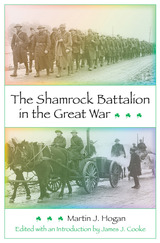 Shamrock Battalion in the Great War
Martin J. Hogan, Edited & Intro by James J. Cooke
University of Missouri Press, 2007
When Martin Hogan began training on a vacant lot to be a soldier, he had no idea that he was about to become part of one of the most famed fighting units of World War I. But soon he and other citizen soldiers from the Irish neighborhoods of New York City were locked in deadly combat with the German army.
Hogan’s book records his recollections of the 165th Infantry in World War I, a regiment in the famed Rainbow Division. Company K of the Third or Shamrock Battalion had a part in every fight, and those who survived had more wound stripes than did the soldiers of any other company in the American Expeditionary Forces. Few soldiers saw as much of the war in eighteen months as did young Martin Hogan, and in this stirring account he tells of his experiences with graphic power, humility, and humor.
Hogan depicts World War I at its most human level, with memories of combat in the trenches and on blood-soaked battlefields at St. Mihiel and in the Argonne Forest. His account tells us much about how unprepared for service the United States really was, with the National Guard woefully undersupplied and seriously undertrained. His experiences as a gassed, then wounded, soldier also show the reader a side of war that was far from glorious—in a time before penicillin, when the dangers of gangrene ran high—and his memoir conveys rare insight about conditions in American military hospitals where he found care.
This insider view of the frontline experience during the Great War, complete with well-known figures such as Chaplain Father Francis Duffy and Colonel “Wild Bill” Donovan, attests that the Rainbow Division “epitomized the best of the best spirit in the world—the American spirit.”
James Cooke’s new introduction to this edition places that renowned division in historical context. Now that other part-time American soldiers are facing new challenges abroad, Hogan’s account also attests that the National Guard, citizen soldiers who bore the brunt of much decisive fighting, measured up to the highest standards of professional fighting men.
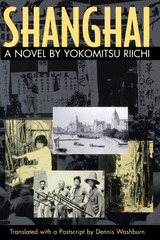 Shanghai: A Novel by Yokomitsu Riichi
Yokomitsu Riichi; Translated with a Postscript by Dennis Washburn
University of Michigan Press, 2001 Published serially between 1928 and 1931, Shanghai tells the story of a group of Japanese expatriates living in the International Settlement at the time of the May 30th Incident of 1925. The personal lives and desires of the main characters play out against a historical backdrop of labor unrest, factional intrigue, colonialist ambitions, and racial politics. The author, Yokomitsu Riichi (1898–1947), was an essayist, writer, and critical theorist who became one of the most powerful and influential literary figures in Japan during the 1920s and 1930s. In 1924 Yokomitsu joined with Kataoka Teppei and Kawabata Yasunari to found the Shinkankaku-ha (New Sensation School), artists who looked to contemporary avant-garde movements in Europe—Dadaism, futurism, surrealism, expressionism—for inspiration in their effort to explode the conventions of literary language and to break free of what they saw as the prisonhouse of modern culture. A key feature of the school’s experiments was the use of jarring imagery that originated in the visual effects of cinema. Yokomitsu incorporated the striking visuality of his early experimental style into a realistic mode that presents a disturbing picture of a city in turmoil. The result is a brilliant evocation of Shanghai as a gritty ideological battleground where dreams of sexual and economic domination are nurtured.
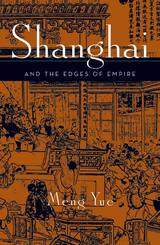 Shanghai and the Edges of Empires
Meng Yue
University of Minnesota Press, 2006 Even before the romanticized golden era of Shanghai in the 1930s, the famed Asian city was remarkable for its uniqueness and East-meets-West cosmopolitanism. Meng Yue analyzes a century-long shift of urbanity from China’s heartland to its shore. During the period between the decline of Jiangnan cities such as Suzhou and Yangzhou and Shanghai’s early twentieth-century rise, the overlapping cultural edges of a failing Chinese royal order and the encroachment of Western imperialists converged. Simultaneously appropriating and resisting imposing forces, Shanghai opened itself to unruly, subversive practices, becoming a crucible of creativity and modernism.
Calling into question conventional ways of conceptualizing modernity, colonialism, and intercultural relations, Meng Yue examines such cultural practices as the work of the commercial press, street theater, and literary arts, and shows that what appear to be minor cultural changes often signal the presence of larger political and economic developments. Engaging theories of modernity and postcolonial and global cultural studies, Meng Yue reveals the paradoxical interdependence between imperial and imperialist histories and the retranslation of culture that characterized the most notable result of China’s urban relocation—the emergence of the international city of Shanghai.
Meng Yue is assistant professor of East Asian languages and literature at the University of California, Irvine.
 The Shanghai Capitalists and the Nationalist Government, 1927-1937
Parks Coble
Harvard University Press, 1986 A common generalization about the Nationalist Government in China during the 1927-1937 decade has been that Chiang Kai-shek's regime was closely allied with the capitalists in Shanghai. This book brings to light a different picture--that Nanking sought to control the capitalists politically, to prevent them from having a voice in the political structure, and to milk the wealth of the urban economy for government coffers. This study documents major political conflicts between the capitalists and the government and demonstrates that the regime gradually suppressed the main organizations of the capitalists and gained control of many of their financial and industrial enterprises.
This is the first systematic examination of the political role of the Shanghai capitalists during the Nanking decade. A number of related issues--the operation of the government bond market, the role of the Shanghai underworld and its ties to Chiang Kai-shek, the personalities and policies of key government officials such as TV. Soong and H.H. Kung, the Japanese attempt to control the economic policies of the Nanking government, and the growth of "bureaucratic capitalism"--are brought into focus.
 The Shanghai Capitalists and the Nationalist Government, 1927-1937
Parks Coble
Harvard University Press, 1980 A common generalization about the Nationalist Government in China during the 1927-1937 decade has been that Chiang Kai-shek's regime was closely allied with the capitalists in Shanghai. This book brings to light a different picture--that Nanking sought to control the capitalists politically, to prevent them from having a voice in the political structure, and to milk the wealth of the urban economy for government coffers. This study documents major political conflicts between the capitalists and the government and demonstrates that the regime gradually suppressed the main organizations of the capitalists and gained control of many of their financial and industrial enterprises.
This is the first systematic examination of the political role of the Shanghai capitalists during the Nanking decade. A number of related issues--the operation of the government bond market, the role of the Shanghai underworld and its ties to Chiang Kai-shek, the personalities and policies of key government officials such as TV. Soong and H.H. Kung, the Japanese attempt to control the economic policies of the Nanking government, and the growth of "bureaucratic capitalism"--are brought into focus.
 The Shanghai Intrigue
Michael S. Koyama
Seagull Books, 2017 When a Chinese American intelligence officer at the US Embassy in Beijing intercepts complex coded messages, the race is on to decipher their meaning. When she finally succeeds in decoding them, the messages seem to indicate a targeted assault on the Japanese financial market. Puzzled, the officer digs deeper and uncovers more intrigue—a large, state-owned Chinese company, which has recently discovered oil in Benin seems to be involved, and. . . what’s this about a kidnapping?
As the complex plot to bring down a major financial institution unfolds at a rapid pace, American and Japanese officials scramble to prevent a crisis with international implications. Set against the backdrop of the political and financial practices of Japan, China, and the US, The Shanghai Intrigue brings with it murder, betrayal, romance, even a natural disaster, as the plot races to a most unpredictable outcome. The book’s breakneck speed and thrilling twists and turns will leave readers spellbound from the first page.
Shanghai Literary Imaginings: A City in Transformation
Lena Scheen
Amsterdam University Press, 2015 This book draws on a wide range of methods-including approaches from literary studies, cultural studies, and urban sociology-to analyse the transformation of Shanghai through rapid growth and widespread urban renewal. Lena Scheen explores the literary imaginings of the city, its past, present, and future, in order to understand the effects of that urban transformation on both the psychological state of Shanghai's citizens and their perception of the spaces they inhabit.
 Shanghai Modern: The Flowering of a New Urban Culture in China, 1930–1945
Leo Ou-fan Lee
Harvard University Press, 1999 In the midst of China’s wild rush to modernize, a surprising note of reality arises: Shanghai, it seems, was once modern indeed, a pulsing center of commerce and art in the heart of the twentieth century. This book immerses us in the golden age of Shanghai urban culture, a modernity at once intrinsically Chinese and profoundly anomalous, blending new and indigenous ideas with those flooding into this “treaty port” from the Western world.
A preeminent specialist in Chinese studies, Leo Ou-fan Lee gives us a rare wide-angle view of Shanghai culture in the making. He shows us the architecture and urban spaces in which the new commercial culture flourished, then guides us through the publishing and filmmaking industries that nurtured a whole generation of artists and established a bold new style in urban life known as modeng. In the work of six writers of the time, particularly Shi Zhecun, Mu Shiying, and Eileen Chang, Lee discloses the reflection of Shanghai’s urban landscape—foreign and familiar, oppressive and seductive, traditional and innovative. This work acquires a broader historical and cosmopolitan context with a look at the cultural links between Shanghai and Hong Kong, a virtual genealogy of Chinese modernity from the 1930s to the present day.
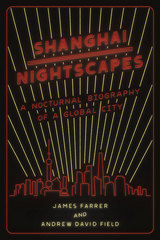 Shanghai Nightscapes: A Nocturnal Biography of a Global City
James Farrer and Andrew David Field
University of Chicago Press, 2015 The pulsing beat of its nightlife has long drawn travelers to the streets of Shanghai, where the night scene is a crucial component of the city’s image as a global metropolis. In Shanghai Nightscapes, sociologist James Farrer and historian Andrew David Field examine the cosmopolitan nightlife culture that first arose in Shanghai in the 1920s and that has been experiencing a revival since the 1980s. Drawing on over twenty years of fieldwork and hundreds of interviews, the authors spotlight a largely hidden world of nighttime pleasures—the dancing, drinking, and socializing going on in dance clubs and bars that have flourished in Shanghai over the last century.
The book begins by examining the history of the jazz-age dance scenes that arose in the ballrooms and nightclubs of Shanghai’s foreign settlements. During its heyday in the 1930s, Shanghai was known worldwide for its jazz cabarets that fused Chinese and Western cultures. The 1990s have seen the proliferation of a drinking, music, and sexual culture collectively constructed to create new contact zones between the local and tourist populations. Today’s Shanghai night scenes are simultaneously spaces of inequality and friction, where men and women from many different walks of life compete for status and attention, and spaces of sociability, in which intercultural communities are formed. Shanghai Nightscapes highlights the continuities in the city’s nightlife across a turbulent century, as well as the importance of the multicultural agents of nightlife in shaping cosmopolitan urban culture in China’s greatest global city.
To listen to an audio diary of a night out in Shanghai with Farrer and Field, click here: http://n.pr/1VsIKAw.
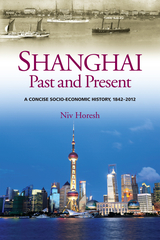 Shanghai, Past and Present: A Concise Socio-Economic History, 1842-2012
Niv Horesh
Sussex Academic Press, 2022 This book sets out to explain how Shanghai emerged from relative obscurity in 1842 to become one of the world's best-known finance and industry hubs. As China's largest city, Shanghai today plays a central economic role, much as it did in the 1920s. The author provides a concise diachronic survey of the economic history of modern Shanghai, setting out how the city's urban infrastructure, municipal institutions, consumer culture and industry have shaped, and have been shaped by, this economic power house. The work is aimed at a broad readership of all who are interested in Asian history, and tackles a range of themes including: the city's millionaires, then and now; racial tensions and quotidian liaisons between Europeans and Asians before World War II; and the gambling and prostitution industry. The post-war era is portrayed in comparative discussions on Shanghai under Mao Zedong, and during the reform era. These discussions bring the narrative up to date to cover important events such as the designation of the Pudong precinct as the city's new engine of growth in 1991. The city's illustrious pre-war past is compared with its present ambitions to become Asia's leading financial centre. The book employs insights from studies frameworks of new institutional economics as well as from the development trajectory of other world cities by way of better understanding Shanghai's historic distinctness, its relative weaknesses and contemporary strengths.
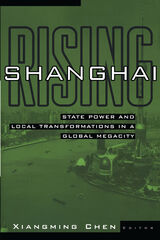 Shanghai Rising: State Power and Local Transformations in a Global Megacity
Xiangming Chen
University of Minnesota Press, 2009 Analyzing a Chinese city’s dazzling rise to global megacity status Until around 1990, Shanghai was China’s premier but sluggish industrial center. Now at the beginning of the twenty-first century, the joint impact of global forces and state power has turned Shanghai into a dynamic megacity. Shanghai’s remarkable growth in economy, infrastructure, and global presence has prompted questions about the Shanghai “miracle.” This collection places the city’s unprecedented rise in a rare comparative examination of U.S. cities, as well as with Asian megacities Singapore and Hong Kong, providing a nuanced account of how Shanghai’s politics, economy, society, and space have been transformed by macro- and micro-level forces. Contributors: Stephen W. K. Chiu, Chinese U of Hong Kong; K. C. Ho, National U of Singapore; John D. Kasarda, U of North Carolina; Hanlong Lu, Shanghai Academy of Social Sciences; Tai-lok Lui, Chinese U of Hong Kong; Ann R. Markusen, U of Minnesota; Anthony M. Orum, U of Illinois, Chicago; Yuan Ren, Fudan U Shanghai; Saskia Sassen, Columbia U; Jiaming Sun, Texas A&M U, Commerce; Fulong Wu, Cardiff U; Pingkang Yu, George Washington U; Tingwei Zhang, U of Illinois, Chicago; Zhenhua Zhou, Development Research Center, Shanghai Municipal Government.
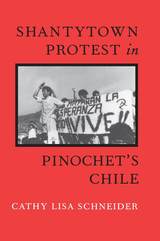 Shantytown Protest in Pinochet's Chile
Cathy Lisa Schneider
Temple University Press, 1995 "Shantytown Protest is one of the richest and most interesting accounts of popular mobilizations in urban Latin America that I have ever seen. The description of popular resistance under conditions of extreme material scarcity and ruthless military repression is fascinating. The book is a major contribution to the research literatures on Third World urbanization and Latin America politics."
--Alejandro Portes, John Dewey Professor of Sociology and International Relations, The Johns Hopkins University
In 1973 armed forces launched a violent attack against the Chilean presidential palace and Santiago's slums and shantytowns. For ten years, only the Catholic Church was able to defy the military regime. Then, in 1983, students, workers, and shantytown residents stormed the streets demanding the resignation of Augusto Pinochet. The protests raged for three years and, in 1989, democratic elections were held. The following year a new civilian government took office.
Cathy Lisa Schneider examines this democratic transition from the bottom up, looking at the struggles of poor people to create and sustain organized resistance, to risk their lives to fight tyranny. Both an oral history based on over a hundred interviews collected in shantytowns and a comparative sociological study that explores political differences among different shantytowns in Santiago, this book analyzes the context in which the urban poor make choices about their lives, and the political histories that shape their vision.
"With an anthropologist's sympathetic ear, an activist's reasoned zeal, a social scientist's theoretical sensibility, and a journalist's deft pen, Cathy Schneider has brought to life Chile's burgeoning shantytown politics of the 1980s. From the overthrow of Allende to the fall of Pinochet, she chronicles and explains the swirling of popular struggles. Read her and learn."
--Charles Tilly, Director, Center for Studies of Social Change, New School for Social Research
"Cathy Schneider's book shows how democratic nation-building depends not only on how elites maneuver, but crucially on how ordinary citizens mobilize on behalf of democracy. She has successfully brought together Latin American studies and social science, the human drama of the shantytown protests with the analytical perspectives of social movement studies."
--Sidney Tarrow, Professor of Government, Cornell University
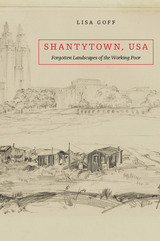 Shantytown, USA: Forgotten Landscapes of the Working Poor
Lisa Goff
Harvard University Press, 2016 The word “shantytown” conjures images of crowded slums in developing nations. Though their history is largely forgotten, shantytowns were a prominent feature of one developing nation in particular: the United States. Lisa Goff restores shantytowns to the central place they once occupied in America’s urban landscape, showing how the basic but resourcefully constructed dwellings of America’s working poor were not merely the byproducts of economic hardship but potent assertions of self-reliance.
In the nineteenth century, poor workers built shantytowns across America’s frontiers and its booming industrial cities. Settlements covered large swaths of urban property, including a twenty-block stretch of Manhattan, much of Brooklyn’s waterfront, and present-day Dupont Circle in Washington, D.C. Names like Tinkersville and Hayti evoked the occupations and ethnicities of shantytown residents, who were most often European immigrants and African Americans. These inhabitants defended their civil rights and went to court to protect their property and resist eviction, claiming the benefits of middle-class citizenship without its bourgeois trappings.
Over time, middle-class contempt for shantytowns increased. When veterans erected an encampment near the U.S. Capitol in the 1930s President Hoover ordered the army to destroy it, thus inspiring the Depression-era slang “Hoovervilles.” Twentieth-century reforms in urban zoning and public housing, introduced as progressive efforts to provide better dwellings, curtailed the growth of shantytowns. Yet their legacy is still felt in sites of political activism, from shanties on college campuses protesting South African apartheid to the tent cities of Occupy Wall Street demonstrations.
The Shape and Shaping of the Book of Psalms: The Current State of Scholarship
Nancy L. deClaissé-Walford
SBL Press, 2014 A new and innovative way to approach the Psalter that moves beyond
form and cult-functional criticism
Drawing inspiration from Gerald H. Wilson’s The Editing of the Hebrew Psalter, this volume explores questions of the formation of the Psalter from the perspective of canonical criticism. Though called “canonical criticism,” the study actually employs a number of historically traditional and nontraditional approaches to reading the text including form criticism, historical criticism of individual psalms as well as of the whole Psalter, and redaction criticism.
Features:
- Exploration of collections of psalms, theological viewpoints, sovereignty, and the shape and shaping of Psalms
- Examination of the impact of canonical criticism on the study of the Psalter
- Sixteen essays from the Book of Psalms Consultation group and invited scholars
The Shape of Content
Ben Shahn
Harvard University Press, 1985 In his 1956–57 Charles Eliot Norton Lectures, the Russian-born American painter Ben Shahn sets down his personal views of the relationship of the artist—painter, writer, composer—to his material, his craft, and his society. He talks of the creation of the work of art, the importance of the community, the problem of communication, and the critical theories governing the artist and his audience.
 The Shape of Content
Ben Shahn
Harvard University Press, 2025 “The clearest, most forceful statement on art by an artist of our time that I have read.” —Frank Getlein, New Republic
An illustrated guide to artistic creation from one of the twentieth century’s most provocative and expressive painters.
Can art be taught? For the celebrated activist-painter Ben Shahn, the answer was a qualified yes. Any would-be artist can take a few courses and dip their toes in the water. But a true education goes far beyond the classroom.
The Shape of Content, compiled from Shahn’s 1956–1957 Norton Lectures, appeals for artists to break the confines of formal instruction. In wide-ranging reflections on art history, the problems of form, and his own career, Shahn conveys the stubborn determination required to move beyond dilettantism and toward an authentic voice. But he delivers no easy formulas. Critics celebrate artists’ seemingly effortless moments of inspiration, yet genuine achievement is always the fruit of prodigious labor. To the perennial questions of “What shall I paint?” and “How shall I paint it?” Shahn replies: Live and think and try. Read endlessly, develop and test opinions, and above all, don’t stop painting.
A figurative realist in an age of high abstraction and an unabashed leftist at the height of the Cold War, Shahn was never quite at home in his own time. The accessibility and popularity of his work, and his sometimes-unfashionable humanism, made him a frequent target of critics during his life. And yet it is precisely these features that have since cemented Shahn as a giant of twentieth-century art. Today, his lectures offer potent lessons for anyone who shares his belief in the power of art to change minds and contest injustice.
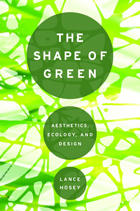 The Shape of Green: Aesthetics, Ecology, and Design
Lance Hosey
Island Press, 2012 Does going green change the face of design or only its content? The first book to outline principles for the aesthetics of sustainable design, The Shape of Green argues that beauty is inherent to sustainability, for how things look and feel is as important as how they’re made. In addition to examining what makes something attractive or emotionally pleasing, Hosey connects these questions with practical design challenges. Can the shape of a car make it more aerodynamic and more attractive at the same time? Could buildings be constructed of porous materials that simultaneously clean the air and soothe the skin? Can cities become verdant, productive landscapes instead of wastelands of concrete? Drawing from a wealth of scientific research, Hosey demonstrates that form and image can enhance conservation, comfort, and community at every scale of design, from products to buildings to cities. Fully embracing the principles of ecology could revolutionize every aspect of design, in substance and in style. Aesthetic attraction isn’t a superficial concern — it’s an environmental imperative. Beauty could save the planet.
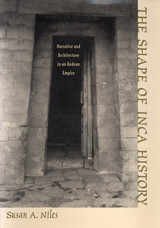 The Shape of Inca History: Narrative and Architecture in an Andean Empire
Susan A. Niles
University of Iowa Press, 1999 In The Shape of Inca History, Susan Niles considers the ways in which the Inca concept of history informed their narratives, rituals, and architecture. Using sixteenth-century chronicles of Inca culture, legal documents from the first generation of conquest, and field investigation of architectural remains, she strategically explores the interplay of oral and written histories with the architectural record and provides a new and exciting understanding of the lives of the royal families on the eve of conquest. Niles focuses on the life of Huayna Capac, the Inca king who ruled at the time of the first European incursions on the Andean coast. Because he died just a few years before the Spaniards overturned the Inca world, eyewitness accounts of his deeds as recorded by the invaders can be used to separate fact from propaganda. The rich documentary sources telling of his life include extraordinarily detailed legal records that inventory lands on his estate in the Yucay Valley. These sources provide a basis—unique in the Andes—for reconstructing the social and physical plan of the estate and for dating its construction exactly. Huayna Capac's country palace shows a design different from that devised by his ancestors. Niles argues that the radical stylistic and technical innovations documented in the buildings themselves can be understood by referring to the turbulent political atmosphere prevalent at the time of his accession. Illustrated with numerous photographs and reconstruction drawings, The Shape of Inca History breaks new ground by proposing that Inca royal style was dynamic and that the design of an Inca building can best be interpreted by its historical context. In this way it is possible to recreate the development of Inca architectural style over time.
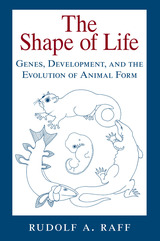 The Shape of Life: Genes, Development, and the Evolution of Animal Form
Rudolf A. Raff
University of Chicago Press, 1996 Rudolf Raff is recognized as a pioneer in evolutionary developmental biology. In their 1983 book, Embryos, Genes, and Evolution, Raff and co-author Thomas Kaufman proposed a synthesis of developmental and evolutionary biology. In The Shape of Life, Raff analyzes the rise of this new experimental discipline and lays out new research questions, hypotheses, and approaches to guide its development.
Raff uses the evolution of animal body plans to exemplify the interplay between developmental mechanisms and evolutionary patterns. Animal body plans emerged half a billion years ago. Evolution within these body plans during this span of time has resulted in the tremendous diversity of living animal forms.
Raff argues for an integrated approach to the study of the intertwined roles of development and evolution involving phylogenetic, comparative, and functional biology. This new synthesis will interest not only scientists working in these areas, but also paleontologists, zoologists, morphologists, molecular biologists, and geneticists.
The Shape of Populism: Serbia before the Dissolution of Yugoslavia
Marko Grdešic
University of Michigan Press, 2019 The Shape of Populism examines socialist Serbia, then part of Yugoslavia, which in the late 1980s witnessed popular mobilization and an emergence of a populist discourse that both constructed and celebrated “the people.” Author Marko Grdešić uses quantitative and qualitative analyses to show how “the people” emerge in the public sphere. This book examines over 300 protests and analyzes them in conjunction with elite events such as party sessions. It examines over 1,600 letters-to-the-editor and political cartoons to reveal the populist construction of “the people.” Grdešić also relies on interviews with participants in populist rallies in the late 1980s to examine the long-term legacies of populism.
Shape of Things: A Philosophy of Design
Vilém Flusser
Reaktion Books, 1999 This book presents for the first time in English an array of essays on design by the seminal media critic and philosopher Vilém Flusser. It puts forward the view that our future depends on design. In a series of insightful essays on such ordinary "things" as wheels, carpets, pots, umbrellas and tents, Flusser emphasizes the interrelationships between art and science, theology and technology, and archaeology and architecture. Just as formal creativity has produced both weapons of destruction and great works of art, Flusser believed that the shape of things (and the designs behind them) represents both a threat and an opportunity for designers of the future.
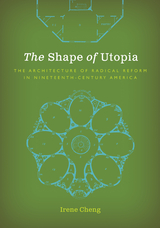 The Shape of Utopia: The Architecture of Radical Reform in Nineteenth-Century America
Irene Cheng
University of Minnesota Press, 2023 How nineteenth-century social reformers devised a new set of radical blueprints for society
In the middle of the nineteenth century, a utopian impulse flourished in the United States through the circulation of architectural and urban plans predicated on geometrically distinct designs. Though the majority of such plans remained unrealized, The Shape of Utopia emphasizes the enduring importance of these radical propositions and their ability to visualize alternatives to what was then a newly emerging capitalist nation. Drawing diagrammatic plans for structures such as octagonal houses, a hexagonal anarchist city, and circular centers of equitable commerce, these various architectural utopians applied geometric forms to envision a more just and harmonious society. Highlighting the inherent political capacity of architecture, Irene Cheng showcases how these visionary planners used their blueprints as persuasive visual rhetoric that could mobilize others to share in their aspirations for a better world. Offering an extensive and uniquely focused view of mid-nineteenth-century America’s rapidly changing cultural landscape, this book examines these utopian plans within the context of significant economic and technological transformation, encompassing movements such as phrenology, anarchism, and spiritualism. Engaging equally with architectural history, visual culture studies, and U.S. history, The Shape of Utopia documents a pivotal moment in American history when ordinary people ardently believed in the potential to reshape society.
 Shaped by Stories: The Ethical Power of Narratives
Marshall Gregory
University of Notre Dame Press, 2009
In his latest book, Marshall Gregory begins with the premise that our lives are saturated with stories, ranging from magazines, books, films, television, and blogs to the words spoken by politicians, pastors, and teachers. He then explores the ethical implication of this nearly universal human obsession with narratives. Through careful readings of Katherine Anne Porter's "The Grave," Thurber's "The Catbird Seat," as well as David Copperfield and Wuthering Heights, Gregory asks (and answers) the question: How do the stories we absorb in our daily lives influence the kinds of persons we turn out to be?
"Shaped by Storiesweaves its own compelling story about the pervasive ethical effects of reading narrative, with Marshall Gregory serving as a highly engaging and ethically admirable narrator--a very model of good company." --James Phelan, Distinguished University Professor of English, Ohio State University
"Marshall Gregory's Shaped by Storiesbrings ethical criticism to the level of felt experience. Witty and passionate, full of personal reflections and sharp examples, this book will help anyone who has been drawn to the mysterious power of stories to think more carefully about the connections between narrative art and human ethos. Gregory reminds us that the urgency of our need for stories is tied permanently to the need to exercise judgment, belief, and empathy in the process of becoming who we are." --Annette Federico, James Madison University
"From a lifetime of reflecting on the ethics of fiction, Marshall Gregory has given us an elegant analysis of the power of stories to instruct and delight. No one interested in storytelling will want to be without this incisive guide to both the myriad ways that stories shape our lives and the strategies writers use to affect our responses. Both the theoretical and practical halves of Shaped by Stories have clarity and eloquence." --Robert D. Denham, Fishwick Professor of English, Emeritus, Roanoke College
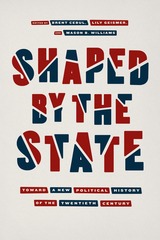 Shaped by the State: Toward a New Political History of the Twentieth Century
Edited by Brent Cebul, Lily Geismer, and Mason B. Williams
University of Chicago Press, 2019 American political history has been built around narratives of crisis, in which what “counts” are the moments when seemingly stable political orders collapse and new ones rise from the ashes. But while crisis-centered frameworks can make sense of certain dimensions of political culture, partisan change, and governance, they also often steal attention from the production of categories like race, gender, and citizenship status that transcend the usual break points in American history.
Brent Cebul, Lily Geismer, and Mason B. Williams have brought together first-rate scholars from a wide range of subfields who are making structures of state power—not moments of crisis or partisan realignment—integral to their analyses. All of the contributors see political history as defined less by elite subjects than by tensions between state and economy, state and society, and state and subject—tensions that reveal continuities as much as disjunctures. This broader definition incorporates investigations of the crosscurrents of power, race, and identity; the recent turns toward the history of capitalism and transnational history; and an evolving understanding of American political development that cuts across eras of seeming liberal, conservative, or neoliberal ascendance. The result is a rich revelation of what political history is today.
|
|

